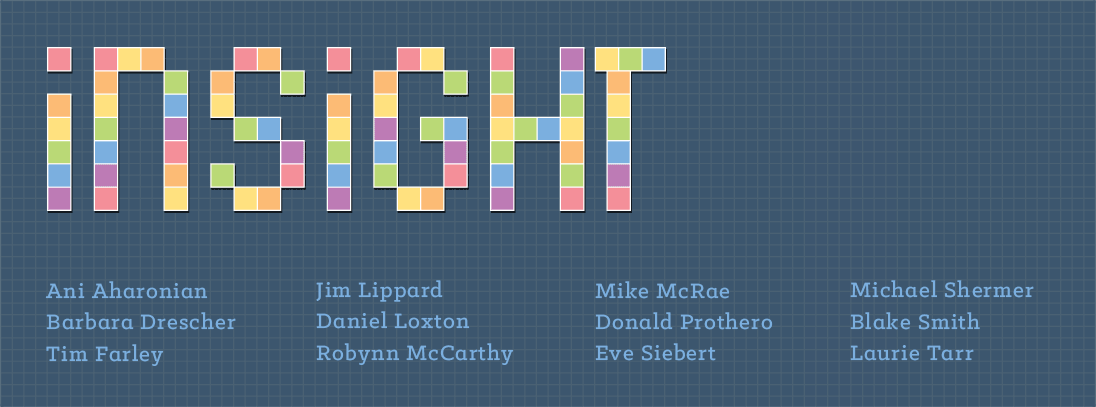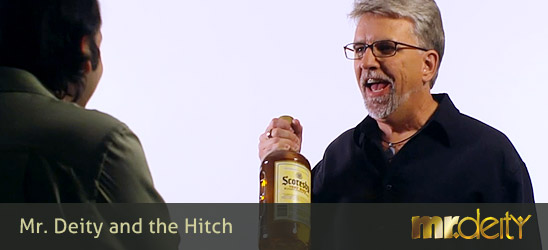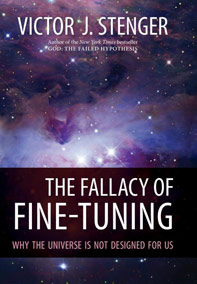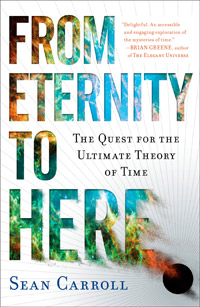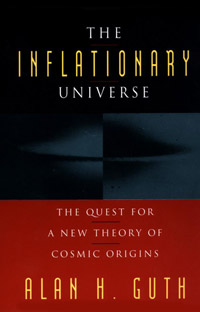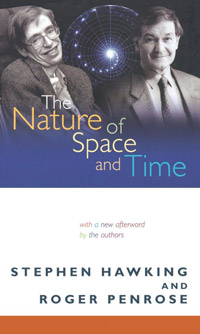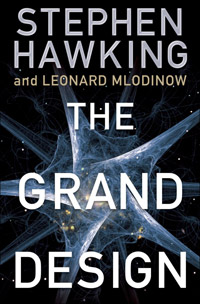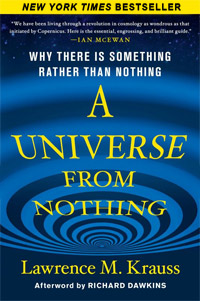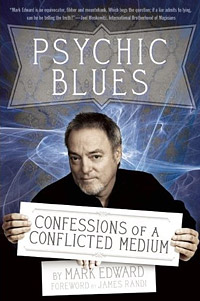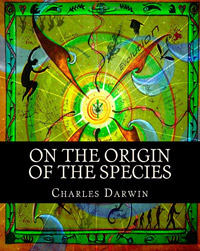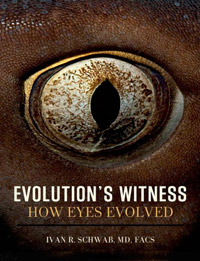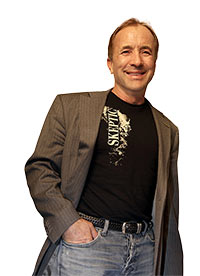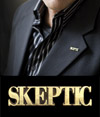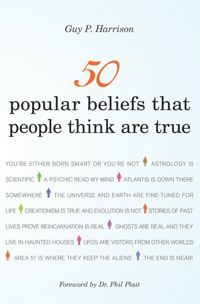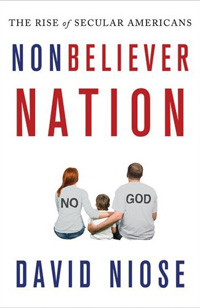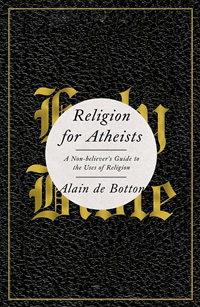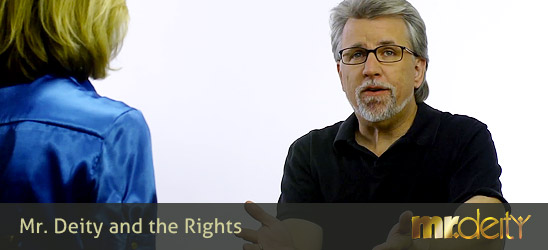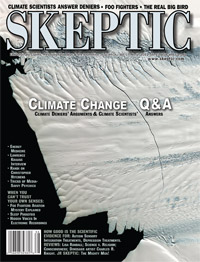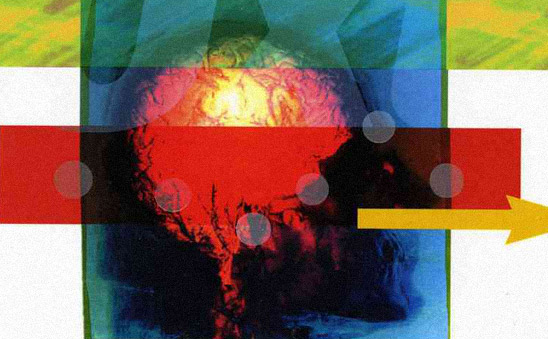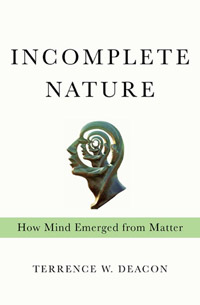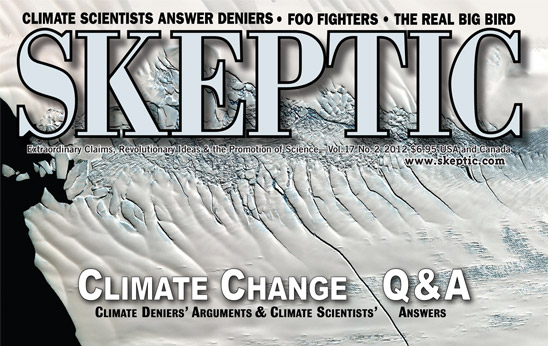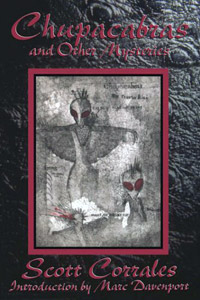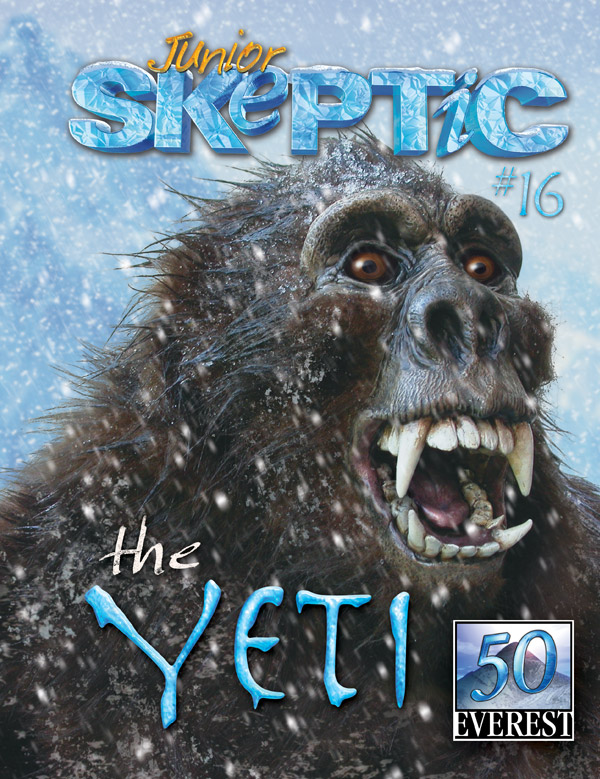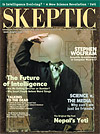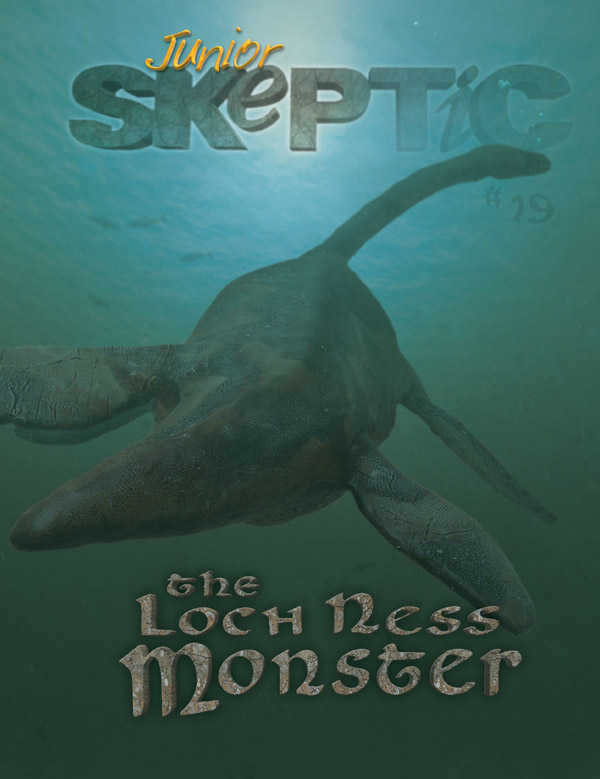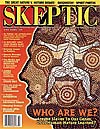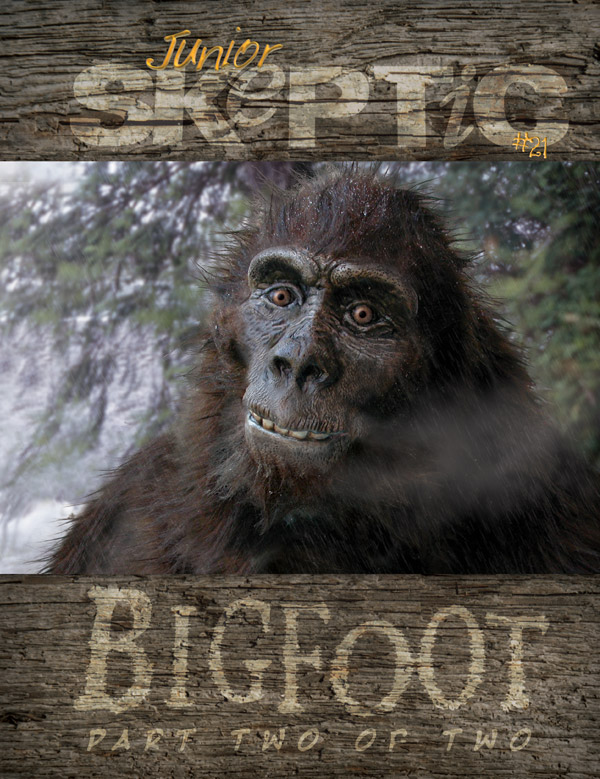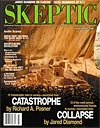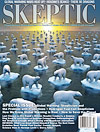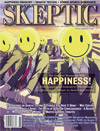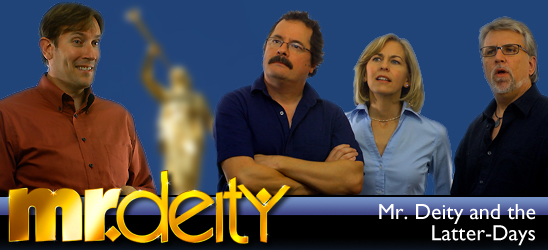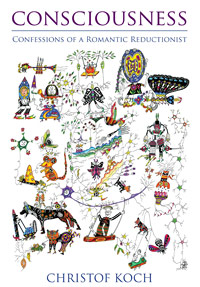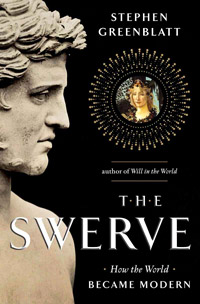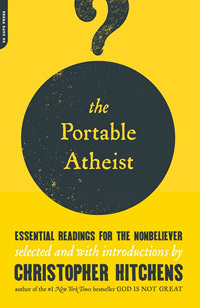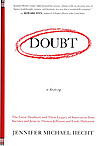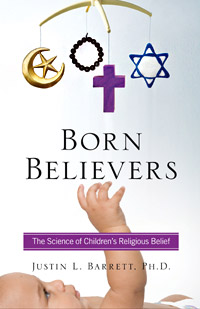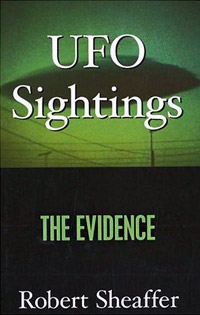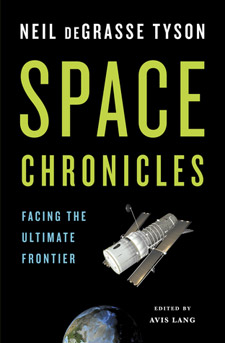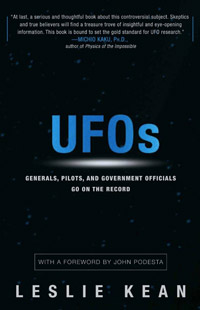12-07-11
In this week’s eSkeptic:
The Latest Episode of Mr. Deity: Mr. Deity and the Hitch
WATCH THIS EPISODE | DONATE | NEWSLETTER | FACEBOOK | MrDeity.com
About this week’s eSkeptic
Scientists are edging closer to providing logical and even potentially empirically testable hypotheses to account for the universe. In this week’s eSkeptic, Michael Shermer discusses 12 possible answers to the question of why there is something rather than nothing.
About the image below
Timeline of the Universe — A representation of the evolution of the universe over 13.7 billion years. The far left depicts the earliest moment we can now probe, when a period of “inflation” produced a burst of exponential growth in the universe. (Size is depicted by the vertical extent of the grid in this graphic.) For the next several billion years, the expansion of the universe gradually slowed down as the matter in the universe pulled on itself via gravity. More recently, the expansion has begun to speed up again as the repulsive effects of dark energy have come to dominate the expansion of the universe. The afterglow light seen by WMAP was emitted about 380,000 years after inflation and has traversed the universe largely unimpeded since then. The conditions of earlier times are imprinted on this light; it also forms a backlight for later developments of the universe. (Credit: NASA / WMAP Science Team)
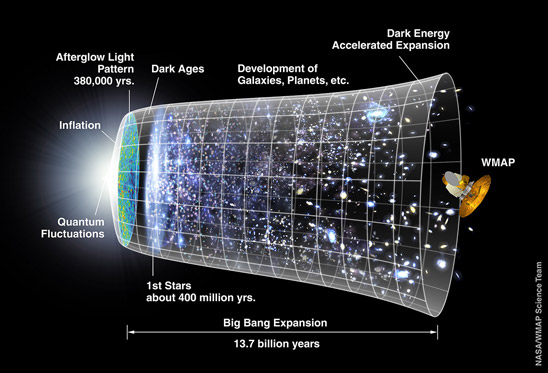
Nothing is Negligible
Why There is Something Rather than Nothing
by Michael Shermer
Why is there something rather than nothing? The question is usually posed by Christian apologists as a rhetorical argument meant to pose as the drop-dead killer case for God that no scientist can possibly answer. Those days are over. Even though scientists are not in agreement on a final answer to the now non-rhetorical question, they are edging closer to providing logical and even potentially empirically testable hypotheses to account for the universe. Here are a dozen possible answers to the question
The Definitive Dozen
1 GOD. The theist’s answer to the question is that God existed before the universe and subsequently brought it into existence out of nothing (ex nihilo) in a single creation moment as described in Genesis. But the very conception of a creator existing before the universe and then creating it implies a time sequence. In both the Judeo-Christian tradition (along with the Babylonian pre-Judeo-Christian cosmogony) and the scientific worldview, time began when the universe came into existence, either through divine creation or the Big Bang. God, therefore, would have to exist outside of space and time, which means that as natural beings delimited by living in a finite universe, we cannot possibly know anything about such a supernatural entity. The theist’s answer is an untestable hypothesis and thus amounts to nothing more than a god-of-the-gaps argument.
2 WRONG QUESTION. Asking why there is something rather than nothing presumes “nothing” is the natural state of things out of which “something” needs an explanation. Maybe “something” is the natural state of things and “nothing” would be the mystery to be solved. As the physicist Victor Stenger notes in his book, The Fallacy of Fine Tuning: “Current cosmology suggests that no laws of physics were violated in bringing the universe into existence. The laws of physics themselves are shown to correspond to what one would expect if the universe appeared from nothing. There is something rather than nothing because something is more stable.”
3 GRAND UNIFIED THEORY. In order to answer the question, we need a comprehensive theory of physics that connects the subatomic world described by quantum mechanics to the cosmic world described by general relativity. As the Caltech cosmologist Sean Carroll notes in his book From Eternity to Here: “Possibly general relativity is not the correct theory of gravity, at least in the context of the extremely early universe. Most physicists suspect that a quantum theory of gravity, reconciling the framework of quantum mechanics with Einstein’s ideas about curved spacetime, will ultimately be required to make sense of what happens at the very earliest times. So if someone asks you what really happened at the moment of the purported Big Bang, the only honest answer would be: ‘I don’t know.’” That grand unified theory of everything will itself need an explanation, but it may be explicable by some other theory we have yet to comprehend out of our sheer ignorance at this moment in history.
4 BOOM-AND-BUST CYCLES. Sean Carroll also suggests that our universe may be just one in a series of boom-and-bust cycles of expansion and contractions of the universe, with our universe just one “episode” of the bubble’s eventual collapse and re-expansion in an eternal cycle, and therefore “there is no such thing as an initial state, because time is eternal. In this case, we are imagining that the Big Bang isn’t the beginning of the entire universe, although it’s obviously an important event in the history of our local region.”
5 DARWINIAN MULTIVERSE. According to the cosmologist Lee Smolin, in his book The Life of the Cosmos, our universe is just one of many bubble universes with varying sets of laws of nature. Those universes with laws of nature similar to ours will generate matter, which coalesces into stars, some of which collapse into black holes and a singularity, the same entity out of which our universe may have sprung. Thus, universes like ours give birth to baby universes with those same laws of nature, some of which develop intelligent life smart enough to discover this Darwinian process of cosmic evolution.
6 INFLATIONARY COSMOLOGY. In his 1997 book The Inflationary Universe, the cosmologist Alan Guth proposes that our universe sprang into existence from a bubble nucleation of spacetime. If this process of universe creation is natural, then there may be multiple bubble nucleations that give rise to many universes that expand but remain separate from one another without any causal contact between them.
7 MANY-WORLDS MULTIVERSE. According to the “many worlds” interpretation of quantum mechanics, there are an infinite number of universes in which every possible outcome of every possible choice that has ever been available, or will be available, has happened in one of those universes. This many-worlds multiverse is grounded in the bizarre findings of the famous “double-slit” experiment, in which light is passed through two slits and forms an interference pattern of waves on a back surface (like throwing two stones in a pond and watching the concentric wave patterns interact, with crests and troughs adding and subtracting from one another). The spooky part comes when you send single photons of light one at a time through the two slits—they still form an interference wave pattern even though they are not interacting with other photons. How can this be? One answer is that the photons are interacting with photons in other universes! In this type of multiverse you could meet your doppelgänger, and depending on which universe you entered, your parallel self would be fairly similar or dissimilar to you, a theme that has become a staple of science fiction (see, for example, Michael Crichton’s Timeline).
8 BRANE UNIVERSES. A multi-dimensional universe may come about when three-dimensional “branes” (a membrane-like structure on which our universe exists) moves through higher-dimensional space and collides with another brane, the result of which is the energized creation of another universe.
9 STRING UNIVERSES. A related multiverse is derived through string theory, which by at least one calculation allows for 10500 possible worlds, all with different self-consistent laws and constants. That’s a 1 followed by 500 zeroes possible universes (12 zeroes is a trillion!). In his book The Unconscious Quantum, Victor Stenger published the results of a computer model that analyzes what just 100 different universes would be like under constants different from our own, ranging from five orders of magnitude above to five orders of magnitude below their values in our universe. Stenger found that long-lived stars of at least 1 billion years—necessary for the production of life-giving heavy elements—would emerge within a wide range of parameters in at least half of the universes in his model.
10 QUANTUM FOAM MULTIVERSE. In this model, universes are created out of nothing, but in the scientific version of ex nihilo the nothing of the vacuum of space actually contains the theoretical spacetime mishmash called quantum foam, which may fluctuate to create baby universes. In this configuration, any quantum object in any quantum state may generate a new universe, each one of which represents every possible state of every possible object. This is Stephen Hawking’s explanation for the fine-tuning problem that he himself famously presented in his 1996 book (co-authored with Roger Penrose) The Nature of Space and Time: “Quantum fluctuations lead to the spontaneous creation of tiny universes, out of nothing. Most of the universes collapse to nothing, but a few that reach a critical size, will expand in an inflationary manner, and will form galaxies and stars, and maybe beings like us.”
11 M-THEORY GRAND DESIGN. Stephen Hawking has continued working on this question, and this month, he and the Caltech mathematician Leonard Mlodinow present their answer in a book entitled The Grand Design. They approach the problem from what they call “model-dependent realism,” based on the assumption that our brains form models of the world from sensory input, that we use the model most successful at explaining events, and that when more than one model makes accurate predictions “we are free to use whichever model is most convenient.” Employing this method, they write, “it is pointless to ask whether a model is real, only whether it agrees with observation.” The dual wave/particle models of light are an example of model-dependent realism, where each one agrees with certain observations but neither one is sufficient to explain all observations. To model the entire universe, Hawking and Mlodinow employ “M-Theory,” an extension of string theory that includes 11 dimensions and incorporates all five current string theory models. “M-theory is the most general supersymmetric theory of gravity,” Hawking and Mlodinow explain. “For these reasons M-theory is the only candidate for a complete theory of the universe. If it is finite—and this has yet to be proved—it will be a model of a universe that creates itself.” Although they admit that the theory has yet to be confirmed by observation, if it is, then no creator explanation is necessary because the universe creates itself. I call this auto-ex-nihilo.
12 NOTHING IS UNSTABLE, SOMETHING IS NATURAL In his 2012 book, A Universe From Nothing, the cosmologist Lawrence M. Krauss attempts to link quantum physics to Einstein’s gravitational theory of general relativity to explain the origin of something (including a universe) from nothing: “In quantum gravity, universes can, and indeed always will, spontaneously appear from nothing. Such universes need not be empty, but can have matter and [electromagnetic] radiation in them, as long as the total energy, including the negative energy associated with gravity [balancing the positive energy of matter], is zero.” And: “In order for the closed universes that might be created through such mechanisms to last for longer than infinitesimal times, something like inflation is necessary.” Observations have revealed that, in fact, the universe is flat (there is just enough matter to eventually halt its expansion), its energy is zero, and it underwent rapid inflation, or expansion, shortly after the Big Bang as described by inflationary cosmology. Thus, Krauss concludes, “quantum gravity not only appears to allow universes to be created from nothing—meaning…the absence of space and time—it may require them. ‘Nothing’—in this case no space, no time, no anything!—is unstable.”
Putting Something to the Test
Many of these dozen explanations are testable. The theory that new universes can emerge from collapsing black holes may be illuminated through additional knowledge about the properties of black holes. Other bubble universes might be detected in the subtle temperature variations of the cosmic microwave background radiation left over from the Big Bang of our own universe. NASA recently launched a spacecraft constructed to study this radiation. Another way to test these theories might be through the Laser Interferometer Gravitational Wave Observatory (LIGO) that is designed to detect exceptionally faint gravitational waves. If there are other universes, perhaps ripples in gravitational waves will signal their presence. Maybe gravity is such a relatively weak force (compared to electromagnetism and the nuclear forces) because some of it “leaks” out to other universes. Maybe.
After a column I wrote in Scientific American on this topic (“Much Ado About Nothing,” May, 2012), I received an email from the Columbia University theoretical physicist Peter Woit cautioning me not to put too much emphasis on any one of these hypotheses/answers to the question of why there is something rather than nothing, noting that even these proposed tests probably themselves lack validity, if they could ever be conducted in reality. He explained that his skepticism came not out of religious conviction: “I’m as much of an atheist as anyone, and I’m really disturbed to see arguments being made that are going to end up discrediting skepticism and atheism.” He then posted a blog commentary on my Scientific American column, noting that my “authority here is the Hawking/Mlodinow popular book, but he’s also convinced that WMAP and LIGO are somehow going to provide evidence for multiverses, something that even the most far-out theorists in this field aren’t claiming.” Regarding my comment that perhaps gravity “leaks” out to other universes Woit responds: “Nobody seems to have told Shermer that this is not an idea taken seriously by a significant number of theorists, or that LHC data has shot down the hopes of the one or two such theorists.” Woit was prescient in that the prominent Intelligent Design creationist William Dembski did highlight Woit’s skepticism at his blog Uncommon Descent (“Serving the Intelligent Design Community”), quoting Woit and commenting: “Don’t nobody tell Shermer. It’s more fun this way.”
Given the fact that I appreciated Peter Woit’s skeptical book on string theory (Not Even Wrong: The Failure of String Theory and the Search for Unity in Physical Law), I queried my sources. Physicist Victor Stenger responded: “The multiverse is not nonsense. It is based on good theory, but only theory. It is, in principle, detectable by measuring an anisotropy in the cosmic background radiation. That’s why I did not rely on it in The Fallacy of Fine-Tuning. I agree with Woit on M-theory, though.” Caltech physicist Leonard Mlodinow said he doubts that either he or Woit knows what “most physicists” think about the multiverse, and then opined that “most cosmologists certainly believe it,” recalling that Brian Greene “outlined the general thinking (as opposed to, say, Hawking’s particular views) very well in his book on it” (The Hidden Reality). Finally, Caltech physicist and cosmologist Sean Carroll noted: “You are completely correct, the multiverse is an idea that pops out of inflation (and string theory), not one that is put in out of desperation. Here is a column of my own making exactly this point. Carroll then cautioned: “Obviously the entire set of ideas is controversial and speculative, and should be presented as such, but it’s taken very seriously by a large number of extremely smart and respectable people.” For example: Leonard Susskind, Alex Vilenkin and Alan Guth (on the pro-multiverse side) and David Gross, Paul Steinhardt, and Edward Farhi (skeptical of the multiverse side).
God, Science, and the Great Unknown
In the meantime, while scientists sort out the science to answer the question Why is there something instead of nothing?, in addition to reviewing these dozen answers it is also okay to say “I don’t know” and keep searching. There is no need to turn to supernatural answers just to fulfill an emotional need for explanation. Like nature, the mind abhors a vacuum, but sometimes it is better to admit ignorance than feign certainty about which one knows not. If there is one lesson that the history of science has taught us it is that it is arrogant to think that we now know enough to know that we cannot know. Science is young. Let us have the courage to admit our ignorance and to keep searching for answers to these deepest questions.
Skeptical perspectives on the universe…
-
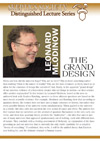 The Grand Design
The Grand Design
by Leonard Mlodinow -
When and how did the universe begin? Why are we here? Why is there something rather than nothing? What is the nature of reality? Why are the laws of nature so finely tuned as to allow for the existence of beings like ourselves? And, finally, is the apparent “grand design” of our universe evidence of a benevolent creator who set things in motion—or does science offer another explanation? In this lecture by Leonard Mlodinow, based on his co-authored book with Stephen Hawking, answers to these ultimate questions are answers based on the most recent scientific evidence.
-
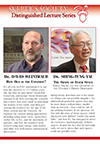 How Old is the Universe? and
How Old is the Universe? and
The Shape of Inner Space
(two lectures on one DVD)
by Dr. David Weintraub and Dr. Shing-Tung Yau -
It’s all very well for astronomers to say that the universe is 13.7 billion years old, but how do they know? Weintraub explains various dating approaches and illustrates the work of astronomers to find the answer to one of the most basic questions about our universe.
Dr. Yau tells the story of the six-dimensional geometric spaces that may be more than a trillion times smaller than an electron (and also one of the defining features of our universe), which physicists have dubbed “Calabi-Yau manifolds.” Dr. Yau managed to prove the existence, mathematically, of these spaces, despite the fact that he had originally set out to prove that such spaces could not possibly exist.
-
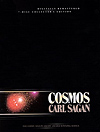 Cosmos (7-DVD set)
Cosmos (7-DVD set)
by Carl Sagan -
The Collector’s edition boxed set of 7 DVDs of the 13 hour series narrated in 1980 by Carl Sagan and revamped in 2000 with up-to-date science and images. The definitive tour of our universe. Inspiring!
12-07-04
In this week’s eSkeptic:

NEW ON SKEPTICBLOG.ORG
How to Learn to Think Like a Scientist (Without Being a Geek)
In this week’s Skepticblog, Michael Shermer shares his experience of what it was like teaching a course in Skepticism 101.
NEW ON MICHAELSHERMER.COM
Aunt Millie’s Mind
In Michael Shermer’s July “Skeptic” column for Scientific American, he reminds us that the hypothesis that the brain creates consciousness has vastly more evidence for it than the hypothesis that consciousness creates the brain.

SKEPTICALITY EPISODE 186
Interviews with Todd Stiefel and Mark Edward
In this episode of Skepticality, Derek sits down with Todd Stiefel to talk about his involvement in recent, and upcoming secular public events and campaigns. His latest is working to collect one million dollars (or more) for the Leukemia and Lymphoma Society through the Foundation Beyond Belief. Also in this episode, Derek catches up with Mark Edward, a well known mentalist, about his new book, Psychic Blues, and the experiences which led him to write the book and his thoughts on the varied types of current psychics who are operating out there today, and through the recent past.
About this week’s eSkeptic
In this week’s eSkeptic, Donald R. Prothero reviews Ivan R. Schwab book, Evolution’s Witness: How Eyes Evolved (Oxford University Press, New York, 2012, ISBN 978-0-19-536974-8). Read Prothero’s bio after the article.

How the Blind Watchmaker
Made Eyes
by Donald R. Prothero
Since the days of Darwin, eyes and evolution have been an irresistible topic for scientists and amateur authors alike. British biologist St. George Jackson Mivart was initially a supporter of Darwin, but when his Catholic religion caused conflict with Thomas Henry Huxley in 1871, he changed to a critic. Mivart’s critique focused on the issue of the perfection of the human eye and how he could not fathom how it could have evolved by natural selection and random chance (a point still raised by creationists today who know nothing about comparative biology).
In later editions of On the Origin of Species, Darwin specifically addressed Mivart’s criticism and carefully explained how the incipient stages of complex structures like the eye could be useful, and could have evolved by small steps; it did not require a giant leap to the complexity to develop the human eye. As Darwin first showed, nature is full of examples of every kind of photoreceptor, from simple light-sensitive cells to eyespots to simple eyes with no lenses, to a variety of solutions of seeing with more and more complex eyes. Once you arrange these solutions in an array, it is only a small step from one to the next, more complex eye. (Indeed, many animals actually show this transition during their embryonic development as their eyes change, and in some organisms, the eyes develop differently in males and females). In fact, the passages where Darwin talks about the eye are one of the most frequently “quote mined” by creationists trying to distort Darwin’s meaning, because they quote only the beginning of the paragraph where Darwin is setting up the creationist position in order to shoot it down the in the rest of the passage (which creationists never quote). Here is the first section that creationists quote (On the Origin of Species, 6th ed., 1872, 143–144):
To suppose that the eye, with all its inimitable contrivances for adjusting the focus to different distances, for admitting different amounts of light, and for the correction of spherical and chromatic aberration, could have been formed by natural selection, seems, I freely confess, absurd in the highest possible degree.
Here is the rest of the quote that creationists conveniently leave out:
Yet reason tells me, that if numerous gradations from a perfect and complex eye to one very imperfect and simple, each grade being useful to its possessor, can be shown to exist; if further, the eye does vary ever so slightly, and the variations be inherited, which is certainly the case; and if any variation or modification in the organ be ever useful to an animal under changing conditions of life, then the difficulty of believing that a perfect and complex eye could be formed by natural selection, though insuperable by our imagination, can hardly be considered real. How a nerve comes to be sensitive to light, hardly concerns us more than how life itself first originated; but I may remark that several facts make me suspect that any sensitive nerve may be rendered sensitive to light, and likewise to those coarser vibrations of the air which produce sound.
The rest of Darwin’s chapter goes into great depth describing the full range of photoreceptor solutions in the animal kingdom, which creationists also conveniently fail to address.
Fast-forward 153 years later to the culmination of this line of argument, represented by Ivan Schwab’s outstanding book Evolution’s Witness: How Eyes Evolved. There have been a number of scientific papers that have expanded on Darwin’s comparative sequence of ocular solutions, but none in the beautiful full-color coffee-table book format that extensively reviews photoreception across all of biology, as does Schwab’s book. Schwab is a professor of ophthalmology at University of California Davis, so he knows eyes in a way that few biologists do, but he also takes great trouble to study and image photoreceptors from nearly every group of living organisms. The book shows not only spectacular color photographs of a wide range of organisms and close-ups of their eyes, but many images of histological sections through the eyes and head (done by Richard Dubielzig, DVM), color reconstructions of prehistoric animals by renowned paleoartist John Sibbick, and microphotography of eye histology. Detailed discussions of the eye anatomy of many key living organisms are provided, along with speculation about the eye anatomy of fossils with excellent preservation. Some, like trilobites, have preserved their crystal calcite lenses unaltered, so we can actually see what they could see. The anatomical discussion might be heavy going for those without any background in biology, but the author provides excellent diagrams and definitions of every anatomical term, plus a glossary, so those who wish to dig in and learn the material will be rewarded.
The book also attempts not just a comparative biology exercise, but a fully chronological account of the geological factors that were in play when each type of eye arose prehistorically. Thus, rather than running through the full gamut of eye types in, say, phylum Arthropoda or phylum Chordata, the chapters jump from the kinds of eyes that existed in invertebrates of a given geological period to the contemporary vertebrates, and back again. This exposition may be a little hard to follow for some readers, but it does allow one to see when each type of eye arose and under what geological conditions. Thus, we can better understand, for example, how 300 m.y. old Carboniferous dragonflies with wingspans almost 3 feet across had eyes the size of golf balls! They, like the 9-foot Arthropleura (a sowbug relative on steroids) or the foot-long cockroaches of this period, were able to grow so large because atmospheric oxygen levels at that time were much higher; oxygen is a critical limiting factor not only for arthropod growth, but especially for eye development. Elsewhere, he describes the amazing dolphin-like marine reptiles known as ichthyosaurs, some of which had eyes the size of beach balls, the largest eyes ever known. These animals apparently were divers into the dark depths of the oceans where they must have hunted prey (possibly large squid like modern sperm whales hunt) that live at such depths.
Schwab begins at the beginning of the simplest life forms, discussing the chemicals and pigments found even in bacteria and algae, and how many (besides chlorophyll) are sensitive to light. He shows how some non-photosynthetic light-sensitive pigments have non-light-sensitive precursors, and evolved before the advent of photoreceptors, then were later co-opted for light sensitivity. Schwab goes into the recent research on evolutionary development of eyes, and how certain genes turn on or off expression of certain eye features, or even the entire eye. He reminds us how many animals have no need for sensitivity to light at all, let alone photoreceptors or eyes, and dispels our anthropomorphic notion that eyes are essential to evolutionary success.
In discussing the appearance of the first real eyes of the trilobites in the Cambrian, Schwab does not make the mistake that Andrew Parker made in his 2004 book In the Blink of an Eye: How Vision Caused the Big Bang of Evolution. Parker’s book was excoriated in the scientific community, not only for its execrable writing style and lack of proper references, but for the even simpler reason that the “Cambrian explosion” was no “explosion” (it took at least 20–80 million years in a series of steps) and that the trilobites and their eyes were one of the last events in this long slow process, so they are unlikely to have caused anything more than the late radiation of more trilobites.
Finally, in his review of cephalopod eyes, Schwab shows how the structure of the fluid-filled eyeball of an octopus evolved independently in that lineage and in the vertebrates—but the octopus eye is actually designed better than our eye! It has no “blind spot” in the retina caused by the exit of the optic nerve, and its layers of photoreceptors are not buried under several other layers of cells, distorting the vision, as our retinas are. The next time you run into a creationist who rhapsodizes about how beautifully designed nature is, remind them of the flawed construction of our eyes compared to that of an octopus or squid, and ask what that tells them about the Designer!
In a project this large in scope, small errors are bound to creep in, especially in areas far from the author’s expertise in eye anatomy. For example, he mentions the discredited notion that a meteorite impact might have something to do with the great Permian extinction; he follows the controversial idea that turtles are nested within Diapsida; but he retains the outdated notions that mesonychids are closer relatives of whales than hippos and other artiodactyls. These can be forgiven, because the author is making an attempt to reach across disciplines and paint a broad picture in a geological context, and such an effort is hard for anyone, regardless of specialty, to manage.
In the broader sense, the entire book is an outstanding antidote to scientific ignorance and creationist lies. It is beautifully written and illustrated, yet the writing is accessible to anyone with some biology background and a willingness to follow the details carefully. The evidence for evolution screams out at you page after page. Like Darwin did in 1859, Schwab pounds the case home with example after example in a way that no creationist can rebut. Among the overwhelmingly positive reviews the book has received in the professional journals and on the Internet, there are three pathetic one-sentence negative reviews by creationist trolls on the book’s Amazon.com page, which clearly show that they didn’t actually read the book and could not comprehend it. Indeed, one of them admits that he gave a bad review to the book after only reading the “look inside” feature on the Amazon.com site and skimming the few pages that are presented. If that doesn’t summarize creationist “scholarship” in a nutshell, nothing does! ![]()
About the Author of this Review
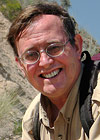
DR. DONALD R. PROTHERO was Professor of Geology at Occidental College in Los Angeles, and Lecturer in Geobiology at the California Institute of Technology in Pasadena. He earned M.A., M.Phil., and Ph.D. degrees in geological sciences from Columbia University in 1982, and a B.A. in geology and biology (highest honors, Phi Beta Kappa) from the University of California, Riverside. He is currently the author, co-author, editor, or co-editor of 32 books and over 250 scientific papers, including five leading geology textbooks and five trade books as well as edited symposium volumes and other technical works. He is on the editorial board of Skeptic magazine, and in the past has served as an associate or technical editor for Geology, Paleobiology and Journal of Paleontology. He is a Fellow of the Geological Society of America, the Paleontological Society, and the Linnaean Society of London, and has also received fellowships from the Guggenheim Foundation and the National Science Foundation. He has served as the President and Vice President of the Pacific Section of SEPM (Society of Sedimentary Geology), and five years as the Program Chair for the Society of Vertebrate Paleontology. In 1991, he received the Schuchert Award of the Paleontological Society for the outstanding paleontologist under the age of 40. He has also been featured on several television documentaries, including episodes of Paleoworld (BBC), Prehistoric Monsters Revealed (History Channel), Entelodon and Hyaenodon (National Geographic Channel) and Walking with Prehistoric Beasts (BBC). His website is: www.donaldprothero.com. Check out Donald Prothero’s page at Shop Skeptic.
Skeptical perspectives on evolution and Darwin…
-
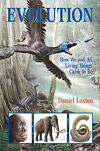 Evolution: How We and All Living Things Came to Be
Evolution: How We and All Living Things Came to Be
Written by Daniel Loxton; illustrated by Daniel Loxton
with Jim W.W. Smith -
Can something as complex and wondrous as the natural world be explained by a simple theory? The answer is YES, and now Evolution explains how in a way that makes it easy to understand. Based on acclaimed articles from Junior Skeptic (Skeptic magazine’s science insert for kids) Evolution is a gorgeous hardcover with dust jacket, packed throughout with dazzling full-color art. This spectacularly illustrated introduction to the theory of evolution takes us from Charles Darwin to modern-day science. Along the way, Evolution answers common questions (and clears up misunderstandings) that sometimes confuse people about the history of life on Earth.
-
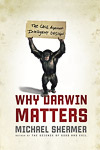 Why Darwin Matters: The Case Against Intelligent Design
Why Darwin Matters: The Case Against Intelligent Design
by Michael Shermer -
Evolution happened, and the theory describing it is one of the most well founded in all of science. Then why do half of all Americans reject it? Michael Shermer defuses the hesitation people have of accepting the theory of evolution by examining what evolution really is, how we know it happened, and how to test it. Dr. Shermer was once an evangelical Christian and a creationist, and is now one of the best-known public intellectuals defending evolutionary theory, so Why Darwin Matters provides readers with an insiders’ guide to the evolution-creation debate, in which he shows why creationism and Intelligent Design are not only bad science, they are bad theology, and why science should be embraced by people of all beliefs.
-
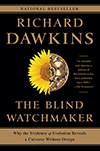 The Blind Watchmaker: Why the Evidence of Evolution Reveals a Universe Without Design
The Blind Watchmaker: Why the Evidence of Evolution Reveals a Universe Without Design
by Richard Dawkins -
One of the most famous creationist arguments originated with 18th century theologian William Paley who suggested that since a watch should have a maker, the natural world also needed to have one. Just as a watch is too complicated and too functional to have sprung into existence by accident, so too must all living things, with their far greater complexity, be purposefully designed. It was Charles Darwin’s brilliant discovery that put the lie to these arguments. But only Richard Dawkins could have written this eloquent riposte to the creationists…
-
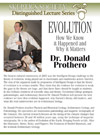 Evolution: How We Know it Happened
Evolution: How We Know it Happened
& Why it Matters
by Dr. Donald R. Prothero -
The hottest cultural controversy of 2005 was the Intelligent Design challenge to the theory of evolution, being played out in classrooms and courtrooms across America. The crux of the argument made by proponents of Intelligent Design is that the theory of evolution is in serious trouble. They claim that the evidence for evolution is weak, the gaps in the theory are huge, and that these flaws should be taught to students. In this brilliant synthesis of scientific data and theory, Occidental College geologist, paleontologist, and evolutionary theorist Dr. Donald Prothero will present the best evidence we have that evolution happened, why Darwin’s theory still matters, and what the real controversies are in evolutionary biology.
Announcing The Amaz!ng Meeting 2012
Southpoint Hotel & Casino, Las Vegas, NV
July 12–15, 2012
THE AMAZ!NG MEETING (TAM) is an annual celebration of science, skepticism and critical thinking. People from all over the world come to TAM each year to share learning, laughs and the skeptical perspective with their fellow skeptics and a host of distinguished guest speakers and panelists.
The James Randi Educational Foundation (JREF) has hosted its annual Amaz!ng Meeting since 2003 as a way to promote science, skepticism and critical thinking about paranormal and supernatural claims to the broader public. TAM has been held in Las Vegas, NV since 2004 and has become the world’s largest gathering of like-minded science-advocates and skeptics.
With yet another incredible lineup of speakers, hands-on workshops, and entertainment, this is sure to be an Amaz!ng Meeting you won’t want to miss! Check out the entire program, and follow @jref on Twitter for the latest #TAM2012 news and announcements.
12-06-27
Michael Shermer Announces Skepticism 101
I am exceptionally proud to announce today the beta launching of Skepticism 101: The Skeptical Studies Curriculum Resource Center, where we provide skeptical resources, freely available to anyone, anywhere, anytime. Brought to you by the Skeptics Society and under the direction of Anondah Saide and William Bull, Skepticism 101 is a resource center for educators, teachers, administrators, students, and skeptics in all fields and walks of life to provide you with the resources you need to teach people how to think skeptically and critically about any and all claims.
We Are All Teachers. We Are All Educators.
Every time you talk to someone anywhere about anything you have an opportunity to teach skepticism and critical thinking, both of which are at the core of science. We want to change the world. Ideas and how to think about them is at the foundation of all change, especially beliefs. To that end we have launched Skepticism 101 and invite you to get involved by contributing any materials that you think might be relevant, interesting, and important to our cause of making the world a better place through reason and science. We are looking for suggested readings, course syllabi, PowerPoint presentations, student projects, papers, and videos that you have written and/or produced, and anything else you can think of that might be relevant. You can browse resources by topic (e.g. psychics), resource type (e.g. course syllabi), academic discipline (e.g. biology), or academic level (e.g. college).
Thank you to everyone who has contributed thus far—in both educational materials and financial support—and I invite you all to make a contribution in any way you can. Think of this as the launching of a Skeptical Library of Alexandria! To participate contact the Skepticism 101 Resource Center Director Anondah Saide: skepticism101@skeptic.com
In addition to those who contributed teaching materials we are especially grateful to our significant supporters in last year’s fundraising campaign on behalf of Skepticism 101: Bill Nye, Steven Ridley, Robert Engman, Richard Epstein, Jones Hamilton, James Alexander, Jean Bettanny, Arnold Lau, David Kaloyanides, Jeff Kodosky, Marvin Mueller, and Michael Roberts. Special thanks go to Tyson Jacobsen, who also attended Michael Shermer’s first official course in skepticism last fall, “Skepticism 101: How to Think Like a Scientist Without Being a Geek.”
12-06-20
In this week’s eSkeptic:
OUR NEW LARGE SIZE BUMPER STICKER (shown above) is designed to withstand the elements, our new self-adhesive bumper stickers (made from the highest quality weather resistant and laminated vinyl) are ideal for use on vehicle bumpers, windows, refrigerators, school lockers and binders, or just about anywhere…
Wear Your Skepticism Proudly!

NEW ON SKEPTICBLOG.ORG
The Reality Distortion Field
In this week’s Skepticblog, Michael Shermer discusses Steve Job’s “Reality Distortion Field,” reminding us that Jobs’ modus operandi of ignoring reality is a double-edge sword, and that reality must take precedence over willful optimism.

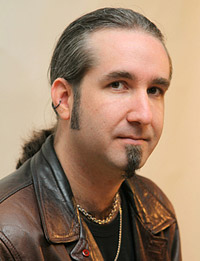
Mike McRae
SKEPTICALITY EPISODE 185
Interview with Mike McRae
In this episode of Skepticality, Derek sits down with Mike McRae, a science writer and touring science communicator for Questacon: Australia’s National Science and Technology Center. Mike has recently released his latest book, Tribal Science. Derek and Mike discuss how the book came about and how our current culture still owes many of its common illogical behaviors to our tribal nature.
About this week’s eSkeptic
Who needs make-believe, when nature offers so much excitement and so many mysteries waiting to be solved? In this week’s eSkeptic, Peter Boghossian reviews Guy P. Harrison’s latest book, 50 Popular Beliefs That People Think are True (Prometheus Books, 2012, ISBN-13: 978-1616144951). Dr. Peter Boghossian teaches critical thinking, science and pseudoscience, and atheism at Portland State University.
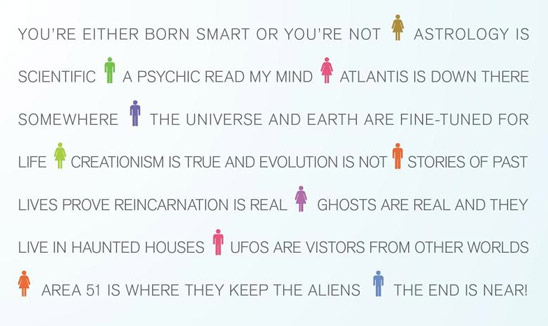
Bogus, Bunk, and B.S.
by Peter Boghossian
Rarely has a skeptic gone to battle against nonsense with the warmth and humor found in 50 Popular Beliefs That People Think are True. Author Guy P. Harrison, an award-winning journalist and long-time advocate for science and reason, delivers a grand tour though the bizarre ecosystem of irrational beliefs and extraordinary claims. Harrison deftly and compellingly demonstrates how science and reality are preferable to superstition and delusion. Who needs make-believe, he asks, when nature offers so much excitement and so many mysteries waiting to be solved?
Readers will find first-rate skeptical treatments of UFOs, psychics, ESP, Atlantis, Bigfoot, astrology, Nostradamus, the Moon landing hoax, Area 51, and other usual suspects—but they will also discover topics that are not as well considered by the skeptical community, but should be. For example, skeptical perspectives on biological race categories, and the race-sports dynamic—covered in the pages of Skeptic magazine in the 1990s but not discussed recently—are thoughtful additions to the skeptical canon. Moreover, his arguments about how television news distorts our view of the real world, even for smart people who should know better, is yet another topic that further differentiates this book from the available literature. Add to this his analysis of how global warming is assessed as a political issue rather than a matter of science, and readers have a comprehensive, provocative tome that will captivate as it educates.
Still another differentiating characteristic of 50 Popular Beliefs That People Think are True, is that it has the potential to make a lasting impression on those who harbor beliefs that are out of alignment with reality. Harrison genuinely attempts, and succeeds, at being gentle and sympathetic toward people who hold unwarranted beliefs—even as he mercilessly and systematically annihilates justifications for the beliefs under examination. He articulates how we are all vulnerable to falling for bad ideas and misinterpreting reality due to the influence of culture and the way our brains routinely deceive us about reality. For example, Harrison explains how vision and memory can be misleading. He writes that human memory is not the biological version of a DVR playback system that most people imagine; memory is more like having a little old man who lives inside your head. When you want to remember something, you have to tap him on the shoulder and then listen to the creative tale he weaves about your past. And like most storytellers, the old man adds a bit here, subtracts a bit there, embellishes, distorts, and even lies in an attempt to deliver to you the best story possible. For an individual, however, memories can feel like a perfectly reliable replay of what happened, no matter how inaccurate they happen to be. All of this has obvious implications for UFO encounters, ghost sightings, psychic readings, and so on. But beyond this, Harrison helps people feel as if it was not their fault that they were unduly influenced and that this influence skewed the mechanism of belief formation; now that they are aware of influences that take them away from reality they can realign their beliefs on the basis of reliable evidence, and do so without shame, guilt or recrimination.
Harrison’s gentle touch doesn’t mean he won’t play rough when it’s needed. Chapters on alternative medicine and the anti-vaccine movement include scathing condemnations of those who promote medical quackery over evidence-based healthcare at the expense of human lives. Through detailed examples, he explains the gravity of what’s at stake because of the tragedy of unreason. For example, Harrison reveals his understandable frustration and anger regarding the strange phenomenon of torturing and killing “witches” in the 21st century. From the abuse of “child witches” by Christians in Africa to the murder of “sorcerers” in rural India by people who fear magic, he shows that humankind has not completely exited the Dark Ages. However, rather than simply state the obvious—that killing people for being witches is tragically ignorant and morally repugnant—Harrison goes further to clearly explain how faith-based thinking in all forms is non-thinking and therefore risky. He shows how even believing in something that seems benign on the surface, such as Bigfoot or the Bermuda Triangle, is a symptom of sloppy thinking that could lead one directly into the grip of a belief that’s pernicious or even fatal.
Fortunately, Harrison does not sidestep religion. He pulls no punches in thorough skeptical assaults on prayer, prophecies, miracles, faith healing, angels, heaven, and gods. He avoids condescension toward believers, but provides the necessary brutal frankness regarding the weakness of their claims. Like any well-versed skeptic, Harrison does not claim to disprove or to know that many of these misaligned beliefs are definitively false. Rather, he shows that a multiplicity of claims people believe as true do not have sufficient evidence to warrant belief. (His personal observations at a Benny Hinn faith healing spectacle are informative and highly entertaining. He also shares his own experience of being prayed for after a cycling accident and his encounter with a “spirit guide” during a vision quest).
This is a book that both believers and skeptics should read. Many believers are likely to enjoy having their beliefs challenged in this often gentle and always thoughtful way. Seasoned skeptics will find plenty of fresh information and new ways to approach conversations with believers. Readers will also appreciate his vigorous defense of the skeptical worldview, in particular how it protects one from harm and frees one up from empty distractions in order to live life more fully. Finally, numerous interviews with prominent scientists and notable people add to the book’s comprehensiveness. Each chapter ends with a useful list of recommended books, documentaries, and Web sites related to the particular topic of that chapter. 50 Popular Beliefs That People Think are True also includes humorous cartoon illustrations, as well as some photographs and statistical illustrations. It is an ideal text for an introductory Science and Pseudoscience or Critical Thinking course. It is clear, comprehensive, non-threatening yet thought provoking while remaining accessible. It’s also a much welcomed and needed addition to every skeptic’s reading list. ![]()
Skeptical perspectives on pseudoscience
and belief in weird things…
-
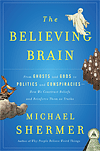 The Believing Brain
The Believing Brain
by Michael Shermer -
In this, his magnum opus synthesizing 30 years of research, Dr. Michael Shermer presents his comprehensive theory on how beliefs are born, formed, nourished, reinforced, challenged, changed, and extinguished. Essentially: beliefs come first, explanations for beliefs follow. We form our beliefs for a variety of subjective, personal, emotional, and psychological reasons in the context of environments created by family, friends, colleagues, culture, and society at large; after forming our beliefs we then defend, justify, and rationalize them with a host of intellectual reasons, cogent arguments, and rational explanations.
-
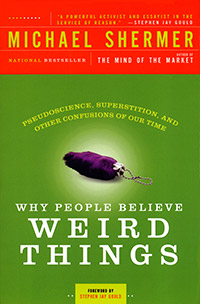 Why People Believe Weird Things
Why People Believe Weird Things
by Michael Shermer -
A no-holds-barred assault on popular superstitions and prejudices, this book debunks these nonsensical claims and explores the very human reasons people find otherworldly phenomena, conspiracy theories, and cults so appealing.
GET AN AUTOGRAPHED COPY OF THIS BOOK.
-
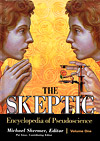 The Skeptic Encyclopedia of Pseudoscience
The Skeptic Encyclopedia of Pseudoscience
Michael Shermer, Pat Linse, Eds. -
Two volumes include and A–Z debunking of all things paranormal and pseudoscientific including case studies and in-depth analyses, a pro and con debate section, plus historical documents on many topics. This was published as a library reference book. Save over $50.00 off the price charged to libraries. GET THE SKEPTIC ENCYCLOPEDIA.
Announcing The Amaz!ng Meeting 2012
Southpoint Hotel & Casino, Las Vegas, NV
July 12–15, 2012
THE AMAZ!NG MEETING (TAM) is an annual celebration of science, skepticism and critical thinking. People from all over the world come to TAM each year to share learning, laughs and the skeptical perspective with their fellow skeptics and a host of distinguished guest speakers and panelists.
The James Randi Educational Foundation (JREF) has hosted its annual Amaz!ng Meeting since 2003 as a way to promote science, skepticism and critical thinking about paranormal and supernatural claims to the broader public. TAM has been held in Las Vegas, NV since 2004 and has become the world’s largest gathering of like-minded science-advocates and skeptics.
With yet another incredible lineup of speakers, hands-on workshops, and entertainment, this is sure to be an Amaz!ng Meeting you won’t want to miss! Check out the entire program, and follow @jref on Twitter for the latest #TAM2012 news and announcements.
12-06-13
In this week’s eSkeptic:

Skeptics are Redoubtable
The hosts of MonsterTalk interview Sharon Hill, creator of the website Doubtful News. The discussion includes updates on the latest in monster news trends, as well as information about The Amaz!ng Meeting—the James Randi Educational Foundation’s annual meeting of skeptical scientists, researchers, artists, performers, teachers and other rational-minded folk in Las Vegas, Nevada. Also in this episode, Brian Thompson of the JREF stops by to discuss TAM 2012.
About this week’s eSkeptic
In this week’s eSkeptic, Rachel Pridgen reviews two books: Nonbeliever Nation: The Rise of Secular Americans by David Niose (Palgrave/Macmillan, 2012, ISBN 13: 978-0-230-33895-1) and Religion for Atheists: A Non-believer’s Guide to the Uses of Religion by Alain de Botton (Pantheon, 2012, ISBN 13: 978-0-307-37910-8).
Rachel Pridgen is credited with preserving the sanity of countless women by hosting group therapy in the form of workout sessions, knit nights, and tea/wine parties. She is a freelance writer with a popular blog depicting her experiences as a freethinking mother in southern Alabama. Her areas of interest and research include religious psychology and early education; the history of philosophy and science; and the intersection between religious language and rational discourse. She is the headmistress and executive director of the Pridgen Ninja Jedi Training Academy for Precocious Children, and she deeply regrets allowing her sons to name their homeschool.

One Nation, Another Religion?
by Rachel Pridgen
Having grown up in Southern California during the Reagan years nothing would have led me to challenge the assumption that all Americans believed in God. We had strong Evangelical leaders and it was evident that God had manifestly blessed America and allowed us to thrive and flourish. To be sure, there were two kinds of Americans: those with vibrant belief and those with apathetic belief. But Americans with no belief? Those existed in the same way ogres, evil wizards, and traitors existed—in a mythical ghetto where we were free to abhor them without actually encountering them. Born into a Christian family during the growth spurt of the religious right, I was unaware of the existence of secular Americans.
“Growing up” for me therefore meant (among many other things) encountering the reality of free thought in America and the humanity that lies behind it. As I asked more questions and my faith failed, I was amazed to find a sizable and thriving secular community beyond my believer bubble.
David Niose, President of the American Humanist Association and Vice President of the Secular Coalition for America presents a new book full of information on secular Americans. Nonbeliever Nation provides a framework for understanding the role of secular Americans, the obstacles they face, and their vision for the future. Niose’s treatment, while not exhaustive, ably maps the American secular experience sociologically and demographically. He begins with demographic data revealing a population in transition. Secularity in America is growing through a change in both belief and identity. It is still an unfortunate reality that disbelief is marginalized in the United States. Open secularity is still not as common as it should be based on the numbers. Tellingly, 81% of Americans report a belief in a divinity, but only 1.6% identify as atheist or agnostic. This means approximately 1 in 6 Americans don’t believe in a divinity, but are unwilling to identify as a non-believer.
The social stigma attached to atheism causes many to remain unidentified regardless of actual belief. This is particularly interesting if one looks at the results of increased religiosity. It would appear that we are not any better off for all of our high rates of fundamentalist beliefs. We have one of the highest homicide rates of all industrialized countries, and Niose provides quotes and statistics to show that “higher rates of belief in and worship of a creator correlate with higher rates of homicide, juvenile and early adult mortality, STD infection rates, teen pregnancy and abortion.” It turns out that belief in God does not necessarily help us to be more moral, and in fact may result in just the opposite. Despite this information, surveys show that atheists remain the most distrusted minority in America, surpassing even rapists and pedophiles.
Niose uses his opening chapters to establish the fact that secular Americans were not always so closeted. In fact, it came as a surprise to many that the Religious Right gained such a strong foothold in American politics. Many simply believed that religious fundamentalism would decline as scientific advances and critical thinking skills increased. This prediction has proven false as the Religious Right has maintained its political clout through heavy marketing strategies, use of emerging technology to reach new markets, and the marginalization of secular culture. Religious conservatives also made extensive use of revisionist historians in order to promote the idea of a conservative Christian tradition in the founding and history of America. Though there are more complete treatments of the secular tradition in America to be found, Nonbeliever Nation provides an excellent overview without getting dragged away from its main focus.
On the matter of secularity and morality, for example, after addressing the evidence that increasing religiosity has not made America a more moral nation than its less religious peers, Niose provides a succinct, accessible overview of the concepts of evolved morality and the benefits of adherence to social norms. For those unfamiliar with the concepts, this presentation is extremely easy to understand, and for those who have already explored these concepts, Niose communicates a sizable amount of complex information without overloading readers.
After laying this sturdy framework, attention is turned to the current problems facing secular Americans. The most pressing problem is not that religion exists or that people believe in God, but that so many of these religious beliefs are being made a matter of public policy. Niose is quick to point out that individual belief is not nearly as problematic as the policies that come out of these beliefs. Unfortunately, the Religious Right views even attempts at religious neutrality as hostile attacks, and are willing to throw large quantities of resources at those who will create more Christian policies. This becomes a problem for secular Americans when the goals of the Religious Right involve anti-intellectualism, revision of textbooks, promotion of public prayer, and discrimination against those without a belief in god.
Now the good news: secular Americans are emerging. Activism is on the rise, people are identifying and organizing in order to influence sound policy, and student activism especially is growing by leaps and bounds. Thanks in large part to the Internet, communities of secular Americans are uniting and working together to make themselves known and heard. College students across the nation are working together to form student alliances, and even high schools are beginning to see the formation of secular student groups. Despite opposition, these groups can legally meet thanks to rights that were originally won by religious groups attempting to gain access to students, so there is a bit of quid pro quo there!
Niose observes that the secular movement is learning a lot from the work of other minority groups, most noticeably, the LGBT movement, which has made great strides in recent years by advocating an identity campaign. Encouraging their members to openly identify and make themselves known has allowed them a public presence, the ability to organize, and a common ground for influence. Niose believes that secular Americans need to adopt this strategy as well in order to move forward and enable change. Unless secular Americans make their presence known, they have little hope of influencing public policy or changing public perceptions. But as Niose emphasizes, this is happening, especially among young people. There is hope that change is imminent. With solid education and awareness, more non-believers will be accepted within the political sphere.
The largest remaining need is that of a solid secular community. Niose states that “religious institutions offer tradition, cultural continuity, and a place to find peace of mind through ritual, meditation, and contemplation. As long as this is not infringing on anyone else’s rights, this can be all good.”
To that end, Alain de Botton offers Religion for Atheists, an interesting read that is sure to stir up conversation and controversy. His thesis is simple: Religion does some things well, and the secular community should unapologetically steal those things. It is de Botton’s goal to create a secular culture with religious (though not supernatural) influences. Though the number of atheists attending Unitarian Universalist churches bears testimony to the validity of some of his claims, de Botton fails to recognize that adding ritual and organization to secular communities does little to avoid the structural problems inherent in religious groups and is unlikely to provide enough positives to outweigh the negatives of dogmatism, propaganda, and various other issues.
De Botton asserts that the creation of community is the easiest and most obvious of the areas in which religions excel. Houses of worship are gathering places for people of varying ages and social classes. Once a week, the faithful are encouraged to set aside their personal differences in order to affirm common beliefs as members of a group. While many will argue that the reinforcement of beliefs is unnecessary, it is hard to argue with the way religions provide an instant social network for their members.
The reinforcement of beliefs is also something that de Botton believes non-believers could adopt. Religion for Atheists points to the methods that churches use to both transmit and affirm beliefs as valuable tools for educators. He argues that while higher education teaches us how to make a living, it doesn’t provide a framework for living well. Churches teach application of values found in its music, writings, and art. They excel at teaching through ritual and repetition. And the best churches employ strong orators who know how to command an audience and draw people in to their topic.
Art and architecture also receive extensive time, though there are many who would criticize the extremes of de Botton’s examples. Religions have historically been very good at using art as propaganda. Not only do they create and commission art, they provide a ready-made framework for interpreting it. The church tells its members exactly how to think and feel about the art they provide. The non-religious do this as well, only it’s called “advertising.” De Botton goes on to say that we should attempt to provide similar interpretive frameworks within our museums, organizing art by topic, emotion or general feeling instead of chronologically or by genre. While it’s an interesting idea, I think it would effectively cut off many observers from their own interpretations.
And this is the problem with many of the suggestions offered in Religion for Atheists. Establishing community is a pretty good idea. Establishing restaurants where patrons are seated with random strangers and instructed to discuss their deepest fears is not a very good idea. Encouraging kindness, creating more beautiful spaces, and finding meaning in life are all great. The idea that we need to establish secular organizations to do these things in ritualistic ways is probably not necessary.
There are other topics where de Botton may find even greater opposition. One chapter claims that the non-religious don’t have enough reminders of the transcendent and that they lack big picture perspective. That has simply not been my experience, nor do I find it to be the experience of the nonbelievers I know. In fact, if anything it seems that most skeptics are more aware of their own insignificance and the fragility and brevity of life, along with the transcendent feelings one gleans from a cosmological and evolutionary perspective.
Both of these books provide valuable food for thought. Niose’s examination of the secular situation in America, its history, and suggestions for the future give hope that secularity will continue to grow and suggest practical ideas for participation in the movement. Due to my recent deconversion, De Botton should have a devoted fan in me. I feel the same pangs toward ritual and the things that the religious community did well as far as establishing community. I even feel the occasional desire to listen to a rousing sermon, though I find debates and lectures to be far more interesting and educational. Unfortunately, I found myself rejecting most of his suggestions. The good news: de Botton’s ideas are just crazy enough to get people talking. While discussing some of the more ridiculous options, we can evaluate whether secular America truly is missing anything, determine what it is, and perhaps come up with ways to fill that need. While it is true that the secular community often throws out the baby with the bathwater when it comes to avoiding similarities to religion, I’m not sure we need to start holding secular baptisms just yet.
Skeptical perspectives on faith, atheism and morality…
-
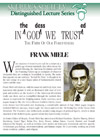 The Faith of Our Forefathers
The Faith of Our Forefathers
by Frank Miele -
Skeptic magazine Senior Editor Frank Miele begins by showing how, when religious fundamentalists call for a return to moral standards, they hold the founding fathers up as exemplars of whatever viewpoints they are seeking to “reestablish” in society. Miele shows how inaccurate this picture is with a slide tour of religion and politics as the revolutionary leaders really saw them. After seeing this lecture you can answer the claims of conservatives and fundamentalists that American was founded as a Christian nation… Order the lecture on DVD.
-
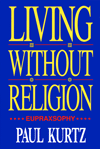 The Living Without Religion
The Living Without Religion
by Paul Kurtz -
One of America’s foremost expositors of humanist philosophy, Paul Kurtz shows how we can live the good life filled with morality, commitment, and dedication, without having to depend on the existence of a higher being. Drawing upon the disciplines of the sciences, philosophy, and ethics, Kurtz also offers concrete recommendations for the development of the humanism of the future. An entire section of the book is devoted to the careful definition of religion, which clearly demonstrates than an authentic moral life is possible without religious belief… Order the book.
-
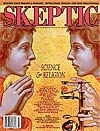 Science and Religion
Science and Religion
Skeptic magazine Vol. 8 No. 2 -
In this issue: Are Science and Religion Compatible?; Faith of the Fatherless: The Psychology of Atheism; Rocks of Ages: Science and Religion in the Fullness of Life, by Stephen Jay Gould; The Natural & the Supernatural: Science, Religion & their Defenders; Finding Darwin’s God: A Scientist’s Search for Common Ground Between God and Evolution; Holy Man, Holy War, Wholly Fiction; Skeptics and True Believers: The Exhilarating Connection Between Science and Religion…
Order the back issue.
-
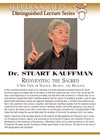 Reinventing the Sacred: A New View
Reinventing the Sacred: A New View
of Science, Reason & Religion
by Dr. Stuart Kauffman -
In this controversial lecture based on his new book, the world-renowned complexity theorist Dr. Stuart Kauffman argues that people who do not believe in God have largely lost their sense of the sacred and the deep human legitimacy of our inherited spirituality, and that those who do believe in a Creator God, no science will ever disprove that belief. Kauffman believes that the science of complexity provides a way to move beyond both reductionist science and dogmatic theology to something new: a unified culture where we see God in the creativity of the universe, biosphere, and humanity…
Order the lecture on DVD.
-
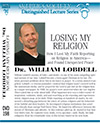 How I Lost My Faith Reporting on Religion
How I Lost My Faith Reporting on Religion
in America—and Found Unexpected Peace
by William Lobdell -
William Lobdell’s journey of faith—and doubt—is one of the most compelling spiritual memoirs of our time. Lobdell became a born-again Christian in his late 20s and the Los Angeles Times asked him to write about faith. While reporting on hundreds of stories, he witnessed a disturbing gap between the tenets of various religions and the behaviors of the faithful and their leaders. He investigated religious institutions that acted less ethically than corrupt Wall Street firms. He found few differences between the morals of Christians and atheists. As this evidence piled up, he started to fear that God didn’t exist. He explored every doubt, every question—until, finally, his faith collapsed… Order the lecture on DVD.
Announcing The Amaz!ng Meeting 2012
Southpoint Hotel & Casino, Las Vegas, NV
July 12–15, 2012
THE AMAZ!NG MEETING (TAM) is an annual celebration of science, skepticism and critical thinking. People from all over the world come to TAM each year to share learning, laughs and the skeptical perspective with their fellow skeptics and a host of distinguished guest speakers and panelists.
The James Randi Educational Foundation (JREF) has hosted its annual Amaz!ng Meeting since 2003 as a way to promote science, skepticism and critical thinking about paranormal and supernatural claims to the broader public. TAM has been held in Las Vegas, NV since 2004 and has become the world’s largest gathering of like-minded science-advocates and skeptics.
With yet another incredible lineup of speakers, hands-on workshops, and entertainment, this is sure to be an Amaz!ng Meeting you won’t want to miss! Check out the entire program, and follow @jref on Twitter for the latest #TAM2012 news and announcements.
The Secrets of Mental Math: The Mathemagician’s Guide to Lightning Calculation and Amazing Math Tricks
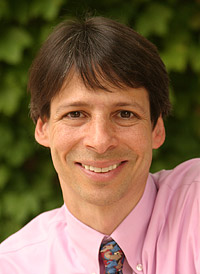
TEACHERS AND PARENTS, BRING YOUR STUDENTS AND KIDS to see the famous lightning calculator and mathemagician Art Benjamin demonstrate simple math secrets and tricks that will forever change how you look at the world of numbers. Get ready to amaze your friends—and yourself—with incredible calculations you never thought you could master, and learn how to do math in your head faster than you ever thought possible, dramatically improve your memory for numbers, and—maybe for the first time—make mathematics fun. Dr. Benjamin will teach you how to quickly multiply and divide triple digits, compute with fractions, and determine squares, cubes, and roots without blinking an eye. No matter what your age or current math ability, Dr. Benjamin will teach you how to perform fantastic feats of the mind effortlessly. This is the math they never taught you in school.
TAGS: Art Benjamin, fast math calculations, math in your head, mathemagics12-06-06
In this week’s eSkeptic:

NEW ON MICHAELSHERMER.COM
The Science of Righteousness
Why are we so predictable and tribal in our politics? In Michael Shermer’s June “Skeptic” column for Scientific American, he explains how evolution helps to explain why parties are so tribal and politics so divisive, arguing for the necessity of competition in creating a “livable middle” ground for society.
NEW ON SKEPTICBLOG.ORG
A Weekend of Woo (Or why I love the Esalen Institute)
Michael Shermer recounts his experience at the Esalen Institute this past weekend where he gave a 3-day workshop on “Science, Spirituality, and the Search for Morality and Meaning.”
Lecture this Sunday at Caltech:
Dr. Art Benjamin

The Secrets of Mental Math: The Mathemagician’s Guide to Lightning Calculation and Amazing Math Tricks
SUNDAY, JUNE 10, 2012 AT 2 PM
Baxter Lecture Hall
Teachers and parents, bring your students and kids to see the famous lightning calculator and mathemagician Art Benjamin demonstrate simple math secrets and tricks that will forever change how you look at the world of numbers. Get ready to amaze your friends—and yourself—with incredible calculations you never thought you could master, and learn how to do math in your head faster than you ever thought possible, dramatically improve your memory for numbers, and—maybe for the first time—make mathematics fun. Dr. Benjamin will teach you how to quickly multiply and divide triple digits, compute with fractions, and determine squares, cubes, and roots without blinking an eye. No matter what your age or current math ability, Dr. Benjamin will teach you how to perform fantastic feats of the mind effortlessly. This is the math they never taught you in school.
Admission policy for Baxter Lecture Hall
Due to security concerns, Baxter Hall will be locked and the audience will be admitted only through the doors on the South side of the building by the lily ponds. If, for medical reasons, you cannot climb the stairs to the hall on the 2nd floor, someone at the main entrance (located in the middle of the West side of the building) will escort you to the elevator.
Tickets
First come, first served at the door. Seating is limited. $8 for Skeptics Society members and the JPL/Caltech community, $10 for nonmembers. Your admission fee is a donation that pays for our lecture expenses.

Spongelab: A Global Science Community
SKEPTICALITY EPISODE 184
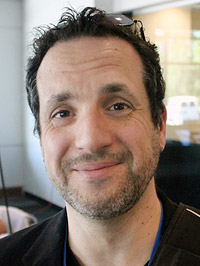
The landscape of education is changing at a pace which might be considered ‘warp speed.’ With tools like Google and Wikipedia, along with a more tech savvy population, new hurdles and challenges face professors and teachers at all levels. Computerized, online media is where many are turning for good resources and content.
In this episode of Skepticality, Derek sits down with Dr. Jeremy Friedberg, the founder and president of Spongelab, an online community which bills itself as “A Global Science Community.” The website is full of resources, digital media, educational computer games, and lesson plans—all of which are free for any educator to use to further enhance their curriculum, and to get students excited about learning the beauty of science and the real world. Find out more about how one company is making sure that science and the real world are communicated in the most effective manner in our modern, cyber-enhanced world.
About this week’s eSkeptic
In this week’s eSkeptic, we present a gem from one of the early issues of Skeptic magazine in which Phil Molé examines some of the teachings and philosophy of Deepak Chopra, and reminds us of the power of science to enlighten. This article appeared in Skeptic magazine volume 6, number 2 (1998).
Phil Molé has a bachelor’s degree in chemistry from DePaul University, where he minored in biology and mathematics. He earned a Masters in Public Health from the University of Illinois at Chicago, and works at an environmental consulting company in Elmhurst, Illinois.

Deepak’s Dangerous Dogmas
by Phil Molé
Through much of history, religious faith was a strong component of medical practice. Diseases were often thought to result from blockages in the body’s flow of vital forces, or from possession by malevolent spirits. Eventually, scientific medicine far surpassed efforts of faith healers, so the latter was made to yield authority to the former.
Occasionally, however, vestiges of the old system creep back in. The current attention given to mind-body medicine — and its most prominent practitioner, Deepak Chopra — testifies to this fact. The author of 19 books, Chopra gives seminars around the world, releases numerous videotaped lectures, and has his own line of herbs and aromatic oils. He also boasts of an impressive celebrity clientele, including Demi Moore, Elizabeth Taylor, George Harrison, and Michael Jackson. Former Good Morning America anchorwoman Joan Lunden even described him as a “huge influence” on her life (Lunden, 20).
The content of Chopra’s philosophy is often obscured by logical inconsistencies, but it is possible, nonetheless, to identify its key components. First, he views the body as a quantum mechanical system, and uses comparisons of quantum reality with Eastern thought to guide us away from our Western, Newtonian-based paradigms. Having accomplished that, he then sets out to convince us that we can alter reality through our perceptions, and admonishes us to appreciate the unity of the Universe. If we allow ourselves to fully grasp these lessons, Chopra assures us, we will then understand the force of Intelligence permeating all of existence — guiding us ever closer to fulfillment. Each component of this philosophy has serious flaws, and requires individual analysis.
The Great Quantum Paradigm Shift
To understand why Chopra is trying to nudge us Eastward in our philosophies, we must first understand the nature of mystical thought, and its rise to prominence in American culture. Mysticism, of course, has been part of our intellectual heritage for thousands of years, originating with ancient Greek thinkers such as Plato and Heraclitus. Eastern religions such as Buddhism, Hinduism, and Taoism expressed similar sentiments, in more developed and poetic forms. There are many varieties of mysticism, but all of them share the four characteristics elaborately described by Bertrand Russell in his classic essay “Mysticism & Logic.” All mystics believe in sudden insight — a revelation of irrefutable knowledge unavailable to the senses; they believe in the oneness of all matter, and the unreality of opposites; they deny the reality of time, since the “past” and the “future” are merely opposite terms resulting from deluded human thought; and they deny the existence of evil.
In 1975, mysticism received its first forceful endorsement from a member of the scientific community. Physicist Fritjof Capra, in his enormously successful book The Tao of Physics, speculated elaborately about the similarities between the science of the subatomic world and the philosophy of Eastern sages. Capra believed these similarities could not be due to chance alone and claimed that the wave particle duality of matter, the Heisenberg uncertainty principle, the equivalence of mass and energy, the Copenhagen Interpretation of quantum mechanics and Einstein’s relativity theories were specific affirmations of mystic principles. Like any mystic worth his salt, he developed this theory through sudden insight:
I was sitting by the ocean late one summer afternoon, watching the waves rolling in and feeling the rhythm of my breathing, when I suddenly became aware of my whole environment as being engaged in a gigantic cosmic dance I saw cascades of energy coming down from outer space, in which particles were created and destroyed in rhythmic pulses; I saw the atoms of the elements and those of my body participating in this cosmic dance of energy; I felt its rhythm and I heard its sound, and at that moment I knew that this was the dance of Shiva, the Lord of the Dancers worshipped by the Hindus (Capra, 11).
To his credit, Capra distinguished between the physical laws pertaining to subatomic entities — and objects traveling near the speed of light, and the physical laws pertaining to boring, macroscopic classical matter — like us. He merely stated that 20th century physics has shown us a different side of reality, and suggested we should change not only our scientific paradigms, but also our social ones, to correspond more closely with the findings of Planck, Einstein and Bohr. This, of course, is still a rather flawed thesis, as I will explain shortly.
Chopra, however, takes a stance that makes Capra look staunchly conservative. In essence, he asserts that our bodies should no longer be regarded as solid mass in the strict Newtonian sense, because they’re made of atoms, which are governed by the laws of quantum mechanics. Therefore, he argues, we must abandon our old views of our bodies, because they do not represent our true reality. “This way of seeing things — the old paradigm,” he tells us in Ageless Body, Timeless Mind, “has aptly been called the ‘hypnosis of social conditioning,’ an induced fiction in which we have collectively agreed to participate (4).” There’s no qualification of meaning attempted here: Chopra is saying the Newtonian-based image of our bodies is wrong, and the quantum-mechanical image of our bodies is right. Since he, like Capra, finds profound similarities between quantum mechanics and mystical thought, the maxims of Eastern sages are automatically fashioned into the guideposts of our life.
Examined credulously, Chopra’s argument seems persuasive. There certainly seems to be some resemblance between, say, the Buddhist assertion that matter and empty space are the same, and the fact that atoms, “the building blocks of matter,” are mostly empty space. Yet, arguments based on superficial logic are not only persuasive, but also dangerous, since they may lead us into errant patterns of thinking. This is the nature of Chopra’s argument, which finds connections where there may be none, and recklessly superimposes the laws of one level of reality on the matter of another.
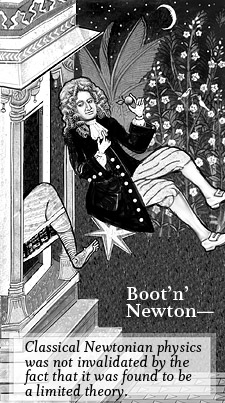
Chopra’s plea for a paradigm shift, ironically, seems to stem from the very dichotomous thinking abhorred by mystics for centuries. If classical physics has been proven to be limited, he reasons, then it must not contain any “real” truth. Modern physics, with all of its new laws and insights, must therefore represent the deeper reality. But this “either/or” business of choosing paradigms is patently absurd, because modern and Newtonian physics are both perfectly valid theories in their own rights and within their own applications. The classical model is a perfectly good description of macroscopic objects moving at relatively low velocities — it only breaks down when matter approaches subatomic size, or when it travels at velocities near the speed of light. Quantum mechanics also has its breaking point: at sizes somewhat bigger than that of a single atom, quantum effects such as wave-particle duality are no longer observed. It would be just as valid, from Chopra’s narrow viewpoint, to point to this limitation in quantum mechanics as proof that classical physics is the one true model of reality. For our bodies, the classical view is clearly the most accurate, since we’re well beyond the size limit of quantum-mechanical nature.
One of Chopra’s chief problems is his inability to realize that a limited theory is not quite the same as an incorrect theory. In fact, all theories are limited, because any models we develop are only selective approximations of reality. Russell said it best: “Science…encourages abandonment of the search for absolute truth, and the substitution of what may be called ‘technical truth,’ which belongs to any theory that can be successfully employed in inventions or in predicting the future” (Russell, .93). All that matters is that we can use a theory to make certain predictions in certain circumstances, and test the predictions through experiment and observation.
Astrophysicist John Gribbin, in his brilliant book Schrödinger’s Kittens and the Search for Reality, explored this point in more detail. Discussing our various models of the atom, and their “goodness” in different applications, Gribbin issued the following caveat:
The point is that we do not know what an atom is really, we cannot ever know what an atom is really. We can only know what an atom is like. By probing it in certain ways, we find that, under certain circumstances, it is like a billiard ball. Probe it another way, and we find it is like the Solar System. Ask a third set of questions, and the answer we get is it is like a positively charged nucleus surrounded by a fuzzy cloud of electrons. These are all images that we carry over from the everyday world to build up a picture of what an atom is. We construct a model, or an image; but then, all too often, we for get what we have done, and confuse the image with reality (Gribbin, 186).
It’s all very well to use models to describe the world, but we must remember that a model only gives us part of the overall picture. Considering any model to somehow contain all of reality is like imagining the globe in our den is a complete reproduction of Earth.
Furthermore, there’s no reason to say that the apparent similarities between quantum theory and mysticism are anything other than coincidental. Again, because of our dichotomous nature, we haven’t been able to think of very many descriptions of existence. We tend to think of something as being either hard or soft, permanent or changeable, solid or empty, united or separate. Should we be surprised if certain theories of science conform to one set of these descriptions?
This point can best be demonstrated by considering the age old philosophical example of a glass filled with water to exactly 50% of its volume. Are we best advised to consider the glass to be half empty, or half full? We seem to be awfully limited in our descriptive freedom. Yet, our answer depends entirely on what we’re trying to learn. If we wish to measure the volume of air inside the glass, it makes sense to consider it to be half empty. But if we’re trying to measure the mass of the glass and water system, we’d better model it as being half full! Taking this a step further, we can see how certain sets of measurements (i.e., mass) will tend to confirm the “half-full” theory, while another set, (i.e., air volume) will win us over to the “half-empty” theory. Which is correct? Both! As Isaac Asimov succinctly stated, “theories are not so much wrong as incomplete (Asimov, 298).”
Chopra, by implying that quantum mechanics is the true face of reality, and by exploiting coincidental parallels with mysticism, leads us into shallow logical waters. It’s one thing to say that a theory or philosophy demonstrates previously unknown features of our existence, it’s quite another to say it is the fundamental truth of our existence, and necessitates a paradigm change.
Create Your Own Reality
In “The Mysterious Stranger,” one of my favorite short stories by Mark Twain, the protagonist, Theodor Fischer, becomes severely disillusioned with life. Accompanied by an angel curiously named Satan, Fischer sees the dark underbelly of life, and the apparent hopelessness facing all of humanity. At the end of the story, his good spirits are restored when his angelic companion tells him that reality — with all of its trials and tribulations — is nothing more than a thought in his head. “Life itself is only a vision, a dream,” Satan tells him. The effect on Fischer was immediate: “A subtle influence blew upon my spirit…bringing with it a vague, dim but blessed and hopeful feeling that the incredible words might be true — even must be true” (Twain, 678).
Like Fischer, Chopra finds great satisfaction in confining reality to the dimensions of our brain. One of his favorite developments in 20th century physics is the Copenhagen Interpretation of quantum mechanics. The interpretation covers many aspects of the quantum world — uncertainty, complementarity, probability — but Chopra is mainly interested in what it says about the relationship between the observer and the observed. To quote physicist Heinz Pagel: “There is no meaning to the objective existence of an electron at some point in space independent of actual observation (Davies, 143).” The implications of this statement are enormous — it tells us an electron only exists as a probability until someone looks at it! Yet, the Copenhagen Interpretation thrived for a half century, because it made predictions verified by experiment. In the process, it also inspired a slew of philo- sophical questions of the “tree falling in the forest” variety.
Chopra uses the Copenhagen mystique to argue that our bodies are made of atoms, which are at the mercy of the observer, so we have the ability to change our body through mental acts of will. Thus, he claims, “the physical world, including our bodies, is a response of the observer. We create our bodies as we create the experience of our world” (Chopra, 1993, 7). Furthermore, he says, Einstein showed us time can flow at different rates through space-time, so why shouldn’t we be able to slow it down or stop it as we see fit? In fact, why shouldn’t we be able to reverse its flow direction, and make ourselves younger? After all, the Copenhagen Interpretation of quantum mechanics subordinates matter to our senses — why shouldn’t time be included in our dominion? If Chopra’s argument is true, the havoc I can play with reality appears boundless. I could, it seems, send all of the atoms in my right hand to Pluto right now, if I really want to. (I don’t; they’re busy typing at this moment).
There are, of course, a few snags in Chopra’s argument. First, even if we believe the human body can realistically be treated as a quantum-mechanical system (as explained before, it cannot be), and believe the Copenhagen Interpretation is the only viable model for quantum mechanics (it isn’t), we cannot assume that time can be molded to fit our observations. It’s true that an observer moving at very high velocities will experience time flowing at a slower rate, but he must first find a way to increase his speed quite significantly. Observation alone cannot alter the passage of time. Also, relativity theory and quantum mechanics have not yet been combined with any success, so time cannot be considered a quantum entity subject to observational influence.
There is another problem we must lay at Chopra’s doorstep — a problem concerning the large portion of our bodies hidden from our view. Quantum mechanics experiments have shown us that only acts of direct observation can collapse a probability function and cause a real particle to appear. In order to truly influence our bodies, therefore, we would have to observe all of the atoms in the body parts we wanted to heal. But how can someone with lung cancer, for instance, “observe” the atoms deep inside his chest cavity? How can a potential heart attack victim “see” the atoms of calcium forming plaques in his arteries?
Chopra tries to get around this issue by saying perception is what really matters. “You can change your world—including your body—simply by changing your perception (17),” he states in Ageless Body, Timeless Mind. He makes this transition in terms—from “observation” to “perception,” quite rapidly, as if they meant the same thing. They don’t. Observation pertains to what we see, and perception pertains to our interpretation of what we see. This is an important distinction, because the results of quantum mechanics experiments bear no relation to our ideas, after the fact, of what happened during the experiment. The wave functions are collapsed by the act of taking a measurement itself. Chopra confuses his terminology further in other parts of his books, talking about perceiving when he seems to really be discussing visualizing. His reliance on the Copenhagen Interpretation has now been completely shattered. If we merely visualize what we think will happen in a quantum mechanics experiment, without taking a measurement, we won’t collapse the wave function, and we will play no role in the experiment at all!
Although I’ve just killed Chopra’s fantasies of quantum mechanical bodies created by our perceptions, it couldn’t hurt to kick the corpse just one more time. Chopra relies heavily on the Copenhagen Interpretation, and seems to imply to his readers that it is the only quantum mechanical model in existence. This was true for quite a long time, but it is certainly not true anymore. Physicist John Cramer has developed a “transactional” model using the Wheeler-Feynman theory of electromagnetic radiation, and it predicts the results of quantum mechanics experiments just as well as the “old” model does. It’s even more attractive, however, because the observer has no special role in the model’s explanation of quantum mechanics—so objective reality exists, after all! Of course, this is still just a theory, but it’s quite a good one, and it may put ideas about observer-created realities out to pasture once and for all.
The Unity of Everything
Mystics have always emphasized the belief that opposites are aspects of the same reality, and our tendency to view entities as separate and unrelated stems from limits in abstract thinking. Heraclitus, for example, was fond of maxims such as “good and ill are one” and “the way up and the way down is one and the same.” The same idea was beautifully expressed by Lao Tsu in the Tao Te Ching (2):
Under heaven all can see beauty as beauty
only because there is ugliness.
All can know good as good only because there is evil.
Therefore, having and not having arise together.
Difficult and easy complement each other.
Long and short contrast each other;
High and low rest upon each other;
Voice and sound harmonize each other;
Front and back follow one another.
There is great value in this lesson; it’s always helpful to confront our old ways of thinking in order to gain a better and fuller perspective of the world. A little thought shows us many instances of ideas and things which were once considered independent, but now have a recognized relationship. In sociology, this was demonstrated in the “nature” versus “nurture” debate. The 17th-century philosopher John Locke, with his “tabula rasa” view of humanity, felt every aspect of man’s character was influenced entirely by culture—man was a fountain of limitless possibilities. This view contrasted sharply with that of many other folks, who felt certain races of man (usually whites of European descent) were biologically superior to others. We now generally recognize that nature and nurture both play a role in determining who we are. All human populations are genetically remarkably alike, but this just means that we all have essentially the same genetic “hardware,” and are not unlimited in the types of “human nature” we exhibit. Culture serves as the “software” that produces variations within our common genetic heritage. Discerning the relationship between “nature” and “nurture,” previously thought to be mutually exclusive, is one of our greatest human achievements.
Still, there should be two limits imposed on our quest for unity in the world. The first concerns attempted unification of disciplines which can only function effectively in isolation, and the second involves false assumptions that all doctrines based on unity are automatically “good.”
Chopra, extending the logic of his rally for a new paradigm shift, wholeheartedly endorses the unification of medicine and spirituality. In many of his books, he bewails the way doctors seem obsessed with “disease and cure” (Chopra, 1988, 91), treating patients as receptacles for medical treatments instead of living, intelligent beings. His solution is to develop a new model of medicine relying heavily on meditation— a practice he believes will enable us to alter the quantum- mechanical structure of our bodies. Traditional medicine should still be used, he explains, but it should not be considered our only alternative.
Medicine (a science) and Eastern spirituality (a religion) share the same goal: helping human beings maintain harmony between their minds and bodies. The approaches used, however, are quite different. Medical science is born of observation, and develops inductively and deductively from testing observations through an endless array of experiments and verifications. Only after a medical theory or procedure has been vigorously tested against reality does it become a standard part of medicine, and even then it is always amenable to new evidence. This is the best method to ensure the reliability of techniques, and to protect patients from receiving treatments which further deteriorate their health or fill them with false hopes.
Religions, on the other hand, begin with certain assumptions about the world and proceed deductively inward. Because the principle assumption is usually the bedrock of the religion, and is therefore considered indisputably factual, all ideas deduced from the assumption are also considered infallible. Spirituality is not subjected to the rigors of experiment, nor is any other attempt generally made to validate its ideas.
We can see, then, that there is no way to reconcile the methodologies of science and religion. Spirituality may be practiced by an individual, as long as it does not interfere with the prescriptions of true medicine. To claim religion as a substitute for medical science is equivalent to claiming astrology as a substitute for astronomy, or for that matter, Creationism as a substitute for evolutionary biology. There is no way of doing so without bringing religion under unnecessarily harsh scrutiny, or undermining the very mechanics by which science operates—endangering human welfare in the process.
A further caution against Chopra’s doctrine of unity is that the feeling of unity itself creates such a feeling of goodness, that it causes us to regard all holistic doctrines as being ineffably good. In other words, when the distinction between good and evil is erased, we tend to feel that only the good survives. Or, as Chopra said in The Way of the Wizard, “beyond the play of opposites, Merlin said, lies a timeless realm of pure light, pure Being, pure love” (126). But why should it be good, and not evil, that still remains after the mirage of opposites has dissipated? Is it realistic to think that holistic philosophies are exempt from any evil, whatsoever?
No. Holistic paradigms come with their own sorts of problems. As Stephen Jay Gould has pointed out, holistic worldviews in pre-Newtonian Europe were often used to justify social inequalities; each person was seen to be fulfilling a role, no matter how menial, in the support of the larger machine of government. “PreCartesian holism was more than a bucolic perception of nature’s fundamental unity,” Gould says, “it was also a dandy doctrine to enforce a status quo not blissful for everyone” (Gould, 220). In our search for universal synchronicity, we must be aware of what we are trying to unify, and the reasons why we’re trying.
Unseen Intelligence
A recurring theme in Chopra’s books concerns the Intelligence of the Universe— the notion that all of existence preserves its own order through a form of consciousness. The good news for us, he then says, is that the Universal Intelligence will provide us with anything we desire. Since we are just forms of energy living in harmony with all other existing energies, the universe maintains us in the process of maintaining itself. Our consciousness somehow melds with the Cosmic Consciousness, and informs it of our wishes. “In order to acquire wealth, or for that matter anything in the physical universe,” Chopra proclaims in Creating Affluence, “you must intend it, make a decision to go for it. The universe handles the details, organizes and orchestrates opportunities. You have simply to be alert to these opportunities” (37). When we wish upon a star, he tells us, our dreams really do come true.
The idea of a consciously evolving universe is quite similar to the strong anthropic principle in cosmology. Some researchers have attached deep meaning to the fact that the four forces (gravity, electromagnetism, strong, and weak) seem to have been “fine tuned” to allow life to develop. If the force of gravity had been just a little bit weaker, they say, denser regions of the universe would never have had the chance to condense into the stars and planets we see today; and if the strong force had been weaker, atomic nuclei couldn’t have been formed. This seems, to them, to be evidence of some form of Intelligence guiding the universe to conditions suitable to support life.
This argument is ultimately rather circular. Why do the forces have the values they do? So human beings could be created. Why were human beings created? Because the strengths of the four forces allowed them to be. But the theory glosses over the fact that vast sections of the universe are completely unsuitable for life. If a guiding principle existed, wouldn’t it also provide for the existence of life in these areas? Furthermore, some theorists, such as Michio Kaku, believe that our universe may be one of billions of cosmic bubbles that have burst into existence. There’s a real statistical probability that some of these “bubble universes” would have conditions hospitable to life, so we need not obsess over the intricate clockwork of existence. The universe may just appear tailor made for us because we are here to see it.
Needless to say, it’s also completely wrong, and potentially very dangerous, to think of the universe as a benevolent Field seeking to make us infinitely happy. This notion, with absolutely no basis in fact, absolves us of responsibility for our own life, and leaves us vulnerable to every imaginable calamity. Following Chopra’s advice, and placing our lives in the hands of the universe, is like flinging gold dust into the wind. We lose the ability to control our fate, and avoid life’s assorted snags and pitfalls, if we automatically assume things will just work out for the best. We become like Voltaire’s Candide, who believes, despite overwhelming evidence to the contrary, that he lives in “the best of all possible worlds” (Voltaire, 243).
The Burden of Proof
When your claims and practices cannot be logically defended, it’s imperative to stay clear of damning evidence. This is something Chopra does with undeniable skill—upholding any indications, no matter how uncertain, of his philosophy’s successes and caustically dismissing challenges to their validity. In his autobiography Return of the Rishi, he describes an incident in which he and a congregation of meditators assembled to demonstrate the art of yogic flying, or levitation, to a television crew. (According to Chopra, humans can levitate by melding their consciousness with the unified field.) When clinical psychologist William Polonski told Chopra his “flyers” looked a lot more like hoppers, the guru became furious: “I think it’s the height of arrogance to educate oneself with four or five years of medical school and three years of training, and then to argue with a tradition that has existed unbroken for five thousand years” (193). So much for open debate.

Quantum Healing provides a similar example of Chopra’s hostility toward skeptical inquiries. He described an experiment by French immunologist Jacques Benveniste regarding the allergic response mediated by the antibody IgE. Benveniste was trying to find out how much anti-IgE was needed to trigger an immune response, and used successively dilute samples of the anti-IgE stock solution. To his amazement, he found that a complete dilution, containing no anti-IgE whatsoever, elicited the same immune response as the stock solution! Chopra maintained this was an example of quantum intelligence—the water had “remembered” it once contained anti-IgE, and the human IgE cells accessed the memory and reacted accordingly.
I can’t, for all the world, understand why phantom immune responses indicate intelligence; they seem, if they exist, to be a better example of ignorance. If our immune system could be triggered by water, we’d swell up like a pufferfish every time we drank something. Luckily for us, Benveniste’s results were almost certainly due to error. Although he was able to duplicate his original results 70 times without the scrutiny of his peers, he could not achieve them in the presence of investigators sent by Nature magazine. A simple error, a delusion, or possibly both, caused him to attain his absurd findings.
True to form, Chopra blasted the staff of Nature for being “reluctant to walk through the quantum door, though this experiment clearly opens it” (120). How does he explain subsequent failures to reproduce the results? “Since the ability of water to remember is inexplicable, its ability to forget can hardly be held against it” (120). How convenient.
Chopra has also been less than scientific in documenting the effectiveness of his herbal remedies. In a 1993 article in Journal of the American Medical Association, Chopra used vague terminology, referring to one costly concoction as “pure knowledge pressed into material form” (Van Biema, 67). No evidence from peer reviewed studies was cited to justify his claims. This, along with Chopra’s failure to disclose his financial interest in the remedies, prompted the editors of JAMA to question his ethics; he retaliated by filing a lawsuit against the journal. (He eventually dropped the case).
But doctors, more than anyone, should be held accountable for the claims they make. If they were allowed to recommend any procedures and remedies uncorroborated by strong evidence, the public would be placed in great jeopardy. At best, many people would spend money unnecessarily, as they often do for herbal dietary supplements which have not been validated through controlled studies. (St. John’s Wort, a popular antidepressant, is one of the few that do have documented effectiveness). At worst, they may lose their lives. This was the fate of David Flint, a leukemia patient treated by an Ayurvedic “physician” endorsed by Chopra. After spending $10,000 over nine months, Flint was allegedly pronounced cured. He died shortly thereafter.
There is no danger in some of Chopra’s advice, of course. He is most lucid when discussing the proven relationship between stress and health, and recommending relaxation strategies to reduce our anxiety. Many diseases may be helped by a positive frame of mind. Back and knee pains, headaches, stuttering, ulcers, stress, hay fever, asthma, hysterical paralysis and blindness are all diseases in which the state of mind may play a central role (Sagan, 234). There are also many diseases, however—such as leukemia and diabetes—which only modern medicine has been able to treat with any success. To stay out of trouble, we must stop substituting our willingness to believe in a “cure” as proof of its effectiveness. We must remember, as Carl Sagan was fond of saying, that spectacular claims require spectacular evidence.
Conclusions: The Path to Enlightenment
It’s human to be hopeful. “Hope is what drives all of us— skeptics and believers alike—to be compelled by unsolved mysteries, to seek spiritual meaning in a physical universe, desire immortality, and wish that our hopes for eternity may be fulfilled” (Shermer, 6). When someone tells us we don’t have to grow old, evil isn’t real, and the universe caters to our wishes, we passionately want to believe. But this is the very reason we must exercise skepticism.
Mystics such as Chopra have always felt that enlightenment comes in sudden, piercing revelation. Science, in contrast, seeks enlightenment based on rigid investigations of reality, correlating its observations based on proven and repeatable experimental results. Of the two methods, only science has the power to provide a check against the pitfalls of faulty logic. To Chopra, the scientist’s world may not seem as magical as the mystic’s, but it provides us with something not even Merlin could have conjured up: the power to control our own fate. If we heed this lesson, and give figures such as Chopra the required analysis, we’ll truly be heading down the Path to Enlightenment.
Bibliography
- Asimov, Isaac. 1988. The Relativity of Wrong. New York: Pinnacle.
- Brown, Chip. “Deepak Chopra Has a (Sniff) Cold.” Esquire. October, 1995.
- Capra, Fritjof. 1975. The Tao of Physics. An Exploration of the Parallels Between Modem Physics and Eastern Mysticism. Boston, MA. Shambhala.
- Chopra, Deepak. 1993. Ageless Body, Timeless Mind: The Quantum Alternative to Growing Old. New York: Random House.
- ___. 1993. Creating Affluence: Wealth Consciousness in the Field of All Possibilities. San Rafael, CA: New World Library.
- ___. 1989. Quantum Healing: Exploring the Frontiers of Mind/Body Medicine. 1989. New York: Bantam. ___. 1988. Return of the Rishi: A Doctor’s Search for the Ultimate.
- Healer. Boston, MA: Houghton Mifflin Company.
- ___. 1994. The Seven Spiritual Laws of Success: A Practical Guide to the Fulfillment of Your Dreams. San Rafael, CA: New World Library.
- ___. 1995. The Way of the Wizard: Twenty Spiritual Lessons in Creating the Life You Want. New York: Harmony Books.
- Davies, Paul (ed.). 1989. The New Physics. Cambridge: Cambridge University Press.
- Freeman, Derek. 1997. “Paradigms in Collision.” Skeptic, 5:3.
- Gould, Stephen Jay. 1987. An Urchin in the Storm: Essays about Books and Ideas. New York: W.W. Norton and Company.
- Gribbin, John. 1984. In Search of Schrodingers Cat: Quantum Physics and Reality. New York: Bantam.
- ___. 1995. Schrodingers Kittens and the Search for Reality: Solving the Quantum Mysteries. New York: Little, Brown and Company.
- Kaku, Michio. 1994. Hyperspace: A Scientific Odyssey Through Parallel Universes, Time Warps, and the 10th Dimension. New York: Oxford University Press.
- Leland, John, and Power, Carla. “Deepak’s Instant Karma.” Newsweek. October 20, 1997.
- Lunden, Joan. “My Survival Secrets.” McCalls. July, 1997.
- Pettus, Elise. “The Mind-Body Problem.” New York August 14, 1995.
- Russell, Bertrand. 1981. Mysticism and Logic. Totowa, New Jersey: Barnes and Noble Books.
- ___. 1935. Religion and Science. New York: Oxford University Press. Excerpted in Macleod, et.al. 1991. Writing About the World. New York: Harcourt Brace Jovanovich College Publishers.
- Sagan, Carl. 1996. The Demon Haunted World: Science as a Candle in the Dark. New York: Ballantine Books.
- Shermer, Michael. 1997. Why People Believe Weird Things: Pseudoscience, Superstition, and other Confusions of Our Time. New York: W.H. Freeman and Company.
- Stix, Gary. “Plant Matters: How Do You Regulate An Herb?” Scientific American. February, 1998.
- Trefil, James. “Was the Universe Designed for Life? Coming to Terms With the Anthropic Principle.” Astronomy. June, 1997.
- Twain, Mark. 1957. “The Mysterious Stranger.” The Complete Short Stories of Mark Twain. New York: Bantam.
- Tsu, Lao. 1997. Tao Te Ching. New York: Vintage Books.
- Van Biema, David. “Of the Soul.” Time. June 24, 1996.
- Voltaire. 1985. The Portable Voltaire. Ed. B.R. Redman. New York: Penguin.
Skeptical perspectives on quantum mechanics…
-
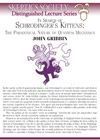 In Search of Schrödinger’s Kittens
In Search of Schrödinger’s Kittens
by John Gribbin -
Astrophysicist and science writer John Gribbin explains the bizarre and quirky world of quantum mechanics and devises a solution to Einstein’s paradox and what he called “spooky action at a distance.” Order the lecture on DVD.
-
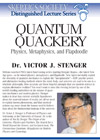 Quantum Quackery: Physics, Metaphysics, and Flapdoodle
Quantum Quackery: Physics, Metaphysics, and Flapdoodle
by Dr. Victor J. Stenger -
Dr. Stenger shows that because quantum mechanics is obscure it is often misused to explain the “unexplainable”—ESP, psychic power, etc. But quantum mechanical hypotheses fit the facts of material reality quite well without any need at all to call upon mysticism. Order the lecture on DVD.
-
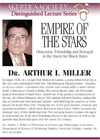 Empire of the Stars: Obsession, Friendship, and Betrayal in the Quest for Black Holes
Empire of the Stars: Obsession, Friendship, and Betrayal in the Quest for Black Holes
by Arthur I. Miller -
Dr. Miller discusses two great theories: relativity and quantum mechanics, which meet head on in the description of black holes. Miller recounts the dramatic story of the quest to understand black holes and the feud between the great astrophysicist Sir Arthur Eddington and his rival, the young Indian imigrant Subrahmanyan Chandrasekhar.
Order the lecture on DVD.
Announcing The Amaz!ng Meeting 2012
Southpoint Hotel & Casino, Las Vegas, NV
July 12–15, 2012
THE AMAZ!NG MEETING (TAM) is an annual celebration of science, skepticism and critical thinking. People from all over the world come to TAM each year to share learning, laughs and the skeptical perspective with their fellow skeptics and a host of distinguished guest speakers and panelists.
The James Randi Educational Foundation (JREF) has hosted its annual Amaz!ng Meeting since 2003 as a way to promote science, skepticism and critical thinking about paranormal and supernatural claims to the broader public. TAM has been held in Las Vegas, NV since 2004 and has become the world’s largest gathering of like-minded science-advocates and skeptics.
With yet another incredible lineup of speakers, hands-on workshops, and entertainment, this is sure to be an Amaz!ng Meeting you won’t want to miss! Check out the entire program, and follow @jref on Twitter for the latest #TAM2012 news and announcements.
12-05-30
In this week’s eSkeptic:
The Latest Episode of Mr. Deity: Mr. Deity and the Rights
WATCH THIS EPISODE | DONATE | NEWSLETTER | FACEBOOK | MrDeity.com
About this week’s eSkeptic
In this week’s eSkeptic, Andrew Zak Williams reviews Lawrence Krauss’ latest book A Universe from Nothing: Why There Is Something Rather than Nothing, with an Afterword by Richard Dawkins (Free Press, 2012, ISBN-13: 978-1451624458). This review appears in the Skeptic magazine 17.2 (2012).
Andrew Zak Williams is a barrister based in England. He has written for The Independent newspaper, The New Statesman, The Humanist and American Atheist. He is also a columnist at www.secularnewsdaily.com.
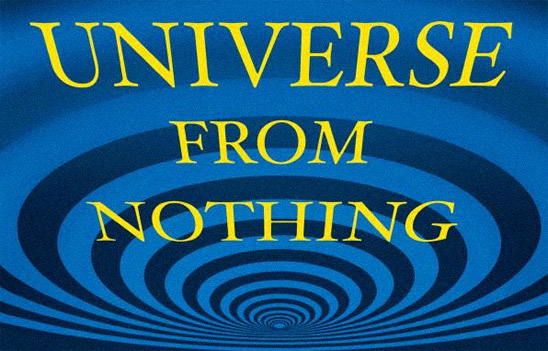
A Universe From Nothing?
by Andrew Zak Williams
In hindsight I couldn’t have chosen a worse time to interview the renowned cosmologist Lawrence Krauss. With his newly released book A Universe From Nothing adorning the New York Times bestseller list, the man of the moment had become the man with no moment to spare. Our first attempt by Skype was postponed due to a photoshoot that ran late. More troubling, the next delay was caused by a break-in at his office in Arizona State University where he is Foundation Professor and Director of the Origins Project. Our next attempt to speak conflicted with a live internet stream his publishers had organized for him with Richard Dawkins.
When we finally met, Krauss was remarkably relaxed and convivial, dressed in the brown suede jacket which, from what I can tell, has accompanied him on most of his public appearances for some time. Within moments, what struck me was the wide-eyed awe he retains for his subject. In fact, it was surely his infectious enthusiasm that turned his lecture on the origins of the universe at the 2009 Atheist Alliance International conference into an Internet sensation, attracting over a million YouTube hits, the success of which gave him the idea to write his latest book.
Since the book sets out to provide a plausible account for the origin of the universe—in particular one that doesn’t involve the supernatural—he could hardly have been surprised that not everyone welcomed his contribution to the subject. The extent of the flak he has received from some parts of the religious community was a recurring theme of our conversation.
“I’m not bashing religion,” he explained. “In fact, physicists spend so little time thinking about God they don’t bother worrying whether they are atheists. God is simply an irrelevance to physics.” Even so, as someone who recently debated the evidence for the existence of God with leading religious apologist William Lane Craig, he knows that his book could sound the death knell for one of the key arguments on which theists rely. (More below.) As for the likes of Craig, Krauss says they are “hucksters running cheap arguments and pedaling a philosophy that has been overtaken by science. They may not like the way the universe works, but who cares? The universe is the way it is.”
This exemplifies the straight-talking approach adopted in the book even though Krauss also frequently reaches inside a trunk-load of humorous analogies he’s heaved around the lecture circuit. Take antimatter: Krauss writes, “It is strange in the sense that Belgians are strange. They are not really strange; it is just that one rarely meets them.” And after explaining that the question why there is something rather than nothing has no basis in science, he drives home the point by announcing that the question “may be no more significant or profound than asking why some flowers are red and some are blue.”
So perhaps it should come as no surprise that the most quoted individual in the book isn’t one of the many theoretical physicists about whose works Krauss is thoroughly knowledgeable. Instead it’s the late Christopher Hitchens, the titan of the New Atheism who was to write a foreword to the work until his illness took him from us.
I asked Krauss about the loss to the skeptical cause following Hitchens’ passing: “He was cultured in a way that none of the rest of us are,” he replied. “So he connected with many people who may not otherwise have been interested in what the likes of, say, Richard Dawkins or I would have to say. Christopher was a wonderful human being. Simply irreplaceable.”
Krauss could see where I was going with this line of questioning and quickly noted, “I have received some emails from people suggesting that I could fill part of the gap left by him,” he added. “If I can fill the void in some small way, I’d be very pleased to do so. In fact, as a scientist I may even be able to reach some audiences that were beyond Christopher.”
This is where A Universe From Nothing comes in. In fewer than 200 pages it sets out to rebut the age-old argument raised by religious apologists who contend that the reason why there is something rather than nothing is that God, outside of time and space, created both at the moment of the Big Bang.
“I think it is virtually certain that everything we see came from empty space,” Krauss exposited. “And all the physics I know is highly suggestive that our universe popped into existence as a quantum fluctuation.” The book develops this by explaining that because of the laws of quantum mechanics and special relativity, empty space consisted of a bubbling brew of virtual particles spontaneously popping in and out of existence on timescales too small to notice. (It is this behavior that makes them virtual.) This was the “nothing” out of which the universe arose. These bubbling activities, known as quantum fluctuations, caused a mass density fluctuation which, in combination with the process of cosmological Inflation, resulted in the Big Bang.
But what about the religious apologists who say that there must have originally been a purer form of nothing, one that didn’t consist of virtual particles? Krauss was dismissive. “I’m not interested in classical, logical descriptions of nothing, but rather what science tells us about nothing. The philosophical bother may be there, but who cares? It just means the universe is cleverer than theologians are. The fact that you can’t get your head around it doesn’t make it less so.”
Still, Krauss’s book deals with how the universe could still have come into existence even if what preceded it was this purer form of nothing, one that doesn’t allow even for empty space. As he explained it to me, “If, at the very beginning, quantum mechanics was applied to gravity, space and time would have become dynamical and so would have spontaneously appeared. So you wouldn’t have needed pre-existing space. Instead the space itself would have arisen.” Why is that? Krauss’s answer: “Because nothing is unstable.” What does this mean? Krauss continued:
When you take out gravity, nothing will always be unstable with particles popping in and out of existence, but these are only virtual particles. But once you have gravity, you offer the possibility of creating something real—that is, not just virtual particles— with zero total energy. Nothing is unstable because once you’ve made something real with zero energy, quantum mechanics says you’ll always create it. If you wait long enough, no matter how small the probability is, it must arise. If you have particle pairs with a gravitational attraction that is just right for their total energy to be zero, you’re guaranteed that something will arise from nothing. That’s because nothing with total zero energy is unstable and so will create something with total zero energy.
In short, although there isn’t yet a fully worked out model of quantum gravity, Krauss’ point is that if you apply quantum mechanics to gravity, not only can a universe spontaneously appear from nothing, it must do so. After explaining this, he returned to a recurring theme: “Some of this bothers people. But who cares? Quantum mechanics is illogical—just get over it.”
I should pause at this point to mention that when religious apologists posit God to explain how something came from nothing, a skeptical retort sometimes heard is that the universe may be eternal: Our own baby universe originated at the Big Bang but the cosmos that gave birth to it may be eternal. And so there never was a nothing from which something arose. There are numerous models that allow for this, most notably the inflationary multiverse, quantum tunneling, and two ideas based on string theory, namely the Ekpyrotic (“conflagration”) scenario and the pre-Big Bang scenario. Yet these models are barely testable, let alone proven. Krauss’ book is particularly useful in showing that skeptics don’t need to resort to these scenarios in order to deal with theist cosmological arguments.
Where did the very laws of nature that Krauss describes come from? After all, some theists may agree with everything Krauss says but then posit God as the creator of the scientific laws that made it all possible. The book answers this question by referring to the possibility of an inflationary multiverse in which the natural laws of any particular baby universe are created spontaneously at the point of its creation. When I asked Krauss whether that means that he considers that the universe must be eternal after all, he swatted away the question by pointing to how much we still have to learn. He added, “Whether the laws themselves are fluid or whether there’s only one set of laws is something I’m agnostic about. I like the idea that there’s only one set of laws but what I like is irrelevant.”
Towards the end of our conversation I reminded Krauss about the afterword to his book in which Richard Dawkins writes that if On the Origin of Species was biology’s deadliest blow to supernaturalism, we may come to see A Universe from Nothing as the equivalent from cosmology. I asked whether he worries about trying to live up to the implied comparison with Darwin, one of the greatest scientists ever. Yet before he even responded, I knew the answer. Krauss is enjoying himself far too much for that. ![]()
Our Next Lecture at Caltech:
Dr. Art Benjamin

The Secrets of Mental Math: The Mathemagician’s Guide to Lightning Calculation and Amazing Math Tricks
SUNDAY, JUNE 10, 2012 AT 2 PM
Baxter Lecture Hall
Teachers and parents, bring your students and kids to see the famous lightning calculator and mathemagician Art Benjamin demonstrate simple math secrets and tricks that will forever change how you look at the world of numbers. Get ready to amaze your friends—and yourself—with incredible calculations you never thought you could master, and learn how to do math in your head faster than you ever thought possible, dramatically improve your memory for numbers, and—maybe for the first time—make mathematics fun. Dr. Benjamin will teach you how to quickly multiply and divide triple digits, compute with fractions, and determine squares, cubes, and roots without blinking an eye. No matter what your age or current math ability, Dr. Benjamin will teach you how to perform fantastic feats of the mind effortlessly. This is the math they never taught you in school.
Admission policy for Baxter Lecture Hall
Due to security concerns, Baxter Hall will be locked and the audience will be admitted only through the doors on the South side of the building by the lily ponds. If, for medical reasons, you cannot climb the stairs to the hall on the 2nd floor, someone at the main entrance (located in the middle of the West side of the building) will escort you to the elevator.
Tickets
First come, first served at the door. Seating is limited. $8 for Skeptics Society members and the JPL/Caltech community, $10 for nonmembers. Your admission fee is a donation that pays for our lecture expenses.
Announcing The Amaz!ng Meeting 2012
Southpoint Hotel & Casino, Las Vegas, NV
July 12–15, 2012
THE AMAZ!NG MEETING (TAM) is an annual celebration of science, skepticism and critical thinking. People from all over the world come to TAM each year to share learning, laughs and the skeptical perspective with their fellow skeptics and a host of distinguished guest speakers and panelists.
The James Randi Educational Foundation (JREF) has hosted its annual Amaz!ng Meeting since 2003 as a way to promote science, skepticism and critical thinking about paranormal and supernatural claims to the broader public. TAM has been held in Las Vegas, NV since 2004 and has become the world’s largest gathering of like-minded science-advocates and skeptics.
With yet another incredible lineup of speakers, hands-on workshops, and entertainment, this is sure to be an Amaz!ng Meeting you won’t want to miss! Check out the entire program, and follow @jref on Twitter for the latest #TAM2012 news and announcements.
12-05-23
In this week’s eSkeptic:

NEW ON SKEPTICBLOG.ORG
The Unknown Unknowns
In this week’s Skepticblog, Michael Shermer reviews Stuart Firestein’s book Ignorance: How it Drives Science (Oxford University Press, 2012, ISBN 13: 97801-998-28074). This review was originally published in Nature, 484, 446–447 (26 April 2012) as “Philosophy: What we don’t know.”
Our Next Lecture at Caltech:
Dr. Art Benjamin

The Secrets of Mental Math: The Mathemagician’s Guide to Lightning Calculation and Amazing Math Tricks
SUNDAY, JUNE 10, 2012 AT 2 PM
Baxter Lecture Hall
Teachers and parents, bring your students and kids to see the famous lightning calculator and mathemagician Art Benjamin demonstrate simple math secrets and tricks that will forever change how you look at the world of numbers. Get ready to amaze your friends—and yourself—with incredible calculations you never thought you could master, and learn how to do math in your head faster than you ever thought possible, dramatically improve your memory for numbers, and—maybe for the first time—make mathematics fun. Dr. Benjamin will teach you how to quickly multiply and divide triple digits, compute with fractions, and determine squares, cubes, and roots without blinking an eye. No matter what your age or current math ability, Dr. Benjamin will teach you how to perform fantastic feats of the mind effortlessly. This is the math they never taught you in school.
Admission policy for Baxter Lecture Hall
Due to security concerns, Baxter Hall will be locked and the audience will be admitted only through the doors on the South side of the building by the lily ponds. If, for medical reasons, you cannot climb the stairs to the hall on the 2nd floor, someone at the main entrance (located in the middle of the West side of the building) will escort you to the elevator.
Tickets
First come, first served at the door. Seating is limited. $8 for Skeptics Society members and the JPL/Caltech community, $10 for nonmembers. Your admission fee is a donation that pays for our lecture expenses.

Closing The Gate
SKEPTICALITY EPISODE 183

Deborah Simpson, author of
Closing The Gate
About fifteen years ago, the largest mass suicide on American soil was conducted by the Heaven’s Gate cult in California. While most of the media attention focussed on the events in Rancho Santa Fe, there were other connected suicides which happened in cities around the United States.
In this episode of Skepticality, Derek speaks with Deborah Simpson, the sister of one of the Heaven’s Gate group, Jimmy, who was living in Atlanta, GA at the time. In his farewell letter Jimmy wrote, “It’s past time for me to go”, and soon after, took his own life to join his Heaven’s Gate brother in the ‘next level’.
In her new book Closing The Gate, Simpson shares the deeply personal story of how her brother got involved with the destructive and manipulative group. It is a rare look into some of the inner workings and effects that such groups can have on the families of those involved.
About this week’s eSkeptic
In this week’s eSkeptic, Dr. Harriet Hall, M.D., the SkepDoc, critiques an article from Skeptic magazine (17.2) entitled, “Depression Treatment: What Works and How We Know” (pp. 23–27) by Bruce Levine.
Harriet Hall, M.D. is a retired family physician and former Air Force flight surgeon. She writes about medicine, so-called complementary and alternative medicine, science, quackery, and critical thinking. She is an editor and one of the five founders of the Science-Based Medicine blog, a regular columnist for Skeptic magazine, a contributing editor to Skeptical Inquirer, and a medical advisor and author of articles on Quackwatch.com. Her most recent book is Women Aren’t Supposed to Fly: The Memoirs of a Female Flight Surgeon.
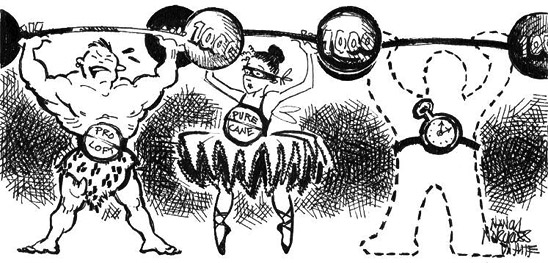
Illustration by Nancy Norcross-White
Don’t Be Depressed
About Depression Treatment
by Dr. Harriet Hall, M.D., the SkepDoc
Bruce Levine’s article in the latest issue of Skeptic Vol. 17, No. 2: “Depression Treatment: What Works and How We Know” (pp. 23–27) paints a bleak view of depression treatment. He destroys all options except for the patient to congratulate himself on his critical thinking skills and to find something he can believe in. I think the reality is more encouraging: treatment can help.
I think Levine goes too far when he says antidepressants don’t outperform placebos. He cites Erick Turner’s study of FDA data showing that negative studies are less likely to be published, thereby skewing the published data; but he leaves out an important part of the story. After incorporating the data from the unpublished studies on 12 different antidepressants, Turner found that every one of the 12 still clearly beat the placebo.
Irving Kirsch looked at a subset of the 12 drugs in Turner’s analysis and came to a different conclusion: that antidepressants were no more effective than placebo. The difference in their conclusions hinges on the interpretation of “effect size.” It’s a bit complicated. I explained it in more detail in an article on ScienceBasedMedicine.org but basically, Kirsch used an arbitrary cutoff of 0.5, and when the studies failed to meet that mark he interpreted that as “antidepressants don’t work.” Turner looked at the actual effect sizes and found a positive effect for every antidepressant drug, with an overall effect size of 0.31. In an elegant metaphor, he explains that the published studies had sold us a glass of juice advertised to contain 0.41 liters, and the actual glass of efficacy (that included the unpublished data) contained only 0.31 liters. Kirsch considers the glass to be empty; Turner correctly concludes that the glass is far from full, but it’s also far from empty. He further points out that patients’ responses are not all-or-none and that partial responses can be meaningful.
Psychiatry bashing is a popular sport. There is much wrong with psychiatry, but it doesn’t deserve all the criticism directed at it. Marcia Angell was critical of psychiatry in her two-part article for The New York Review of Books where she reviewed Kirsch’s book and two others. I have critiqued her article on ScienceBasedMedicine.org, where I go into much more detail than space permits here. I’ll just make a few points. Depression is a complicated subject. The chemical imbalance model of depression is too simplistic. Drugs have side effects. They are often prescribed inappropriately for minor depression and the problems of everyday life. But conversely, many depressed patients suffer unnecessarily because they are untreated or undertreated. Severe depression is a life-threatening illness, and treatment with antidepressant medication has been shown in several studies to significantly reduce the risk of suicide. While psychotherapy is an alternative to drugs, antidepressants may be needed at first to lift the depression enough that patients are able to participate in psychotherapy.
There’s a baby in that depression treatment bathwater; let’s not throw it out just yet!
Skeptical perspectives on pseudomedicine, alternative medicine, false memory syndrome, and a skeptical classic from Sagan…
-
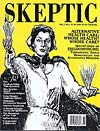 Pseudomedicine
Pseudomedicine
Skeptic magazine volume 3, number 1 -
Topics in this issue include: Update on False Memory Syndrome; Homeopathy; Alternative Healthcare; Therapeutic Touch; Leftist Science; Mattoon Mass Hysteria; Star Trek’s Meaning; Liquefying “Blood”… Order the back issue.
-
 The Trick or Treatment: The Undeniable Facts About Alternative Medicine
The Trick or Treatment: The Undeniable Facts About Alternative Medicine
by Simon Singh & Edzard Ernst -
An excellent guide to the confusions and contradictions of alternative medicine written with clarity, integrity and authority. What works? Who can you trust? What alternative cures have positive results? What medical authorities are included in their “Top ten culprits in the promotion of unproven and disproven medicine?” Includes extensive information on the big four: acupuncture, homeopathy, herbs, and chiropractic, plus a “Rapid guide to Alternative Therapies.”… Order the book.
-
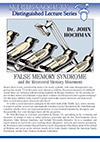 False Memory Syndrome and the Recovered Memory Movement
False Memory Syndrome and the Recovered Memory Movement
with Dr. John Hochman -
Repressed memories of childhood sexual abuse are surfacing with increasing regularity in therapy situations. Are the growing stories of often violent and elaborate sexual abuse evidence of widespread crimes against humanity? Are this many children really abused? Can the mind really repress memories and then recall them in vivid and accurate details decades later? Or is this a social movement analogous to the witch trials of the Middle Ages, where memory is acquired and the accused are automatically considered guilty?… Order the lecture on DVD.
-
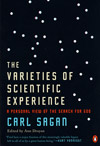 The Varieties of Scientific Experience
The Varieties of Scientific Experience
by Carl Sagan (edited by Ann Druyan) -
This book presents Sagan’s prestigious Gifford Lectures on Natural Theology, in which he discusses his views on topics ranging from manic depression and the possibly chemical nature of transcendance to creationism and so-called intelligent design to the likelihood of intelligent life on other planets to the likelihood of nuclear annihilation of our own to a new concept of science as “informed worship.” Sagan’s humorous, wise, and at times stunningly prophetic observations on some of the greatest mysteries of the cosmos have the invigorating effect of stimulating the intellect, exciting the imagination, and reawakening us to the grandeur of life in the cosmos. Order the book.
Announcing The Amaz!ng Meeting 2012
Southpoint Hotel & Casino, Las Vegas, NV
July 12–15, 2012
THE AMAZ!NG MEETING (TAM) is an annual celebration of science, skepticism and critical thinking. People from all over the world come to TAM each year to share learning, laughs and the skeptical perspective with their fellow skeptics and a host of distinguished guest speakers and panelists.
The James Randi Educational Foundation (JREF) has hosted its annual Amaz!ng Meeting since 2003 as a way to promote science, skepticism and critical thinking about paranormal and supernatural claims to the broader public. TAM has been held in Las Vegas, NV since 2004 and has become the world’s largest gathering of like-minded science-advocates and skeptics.
With yet another incredible lineup of speakers, hands-on workshops, and entertainment, this is sure to be an Amaz!ng Meeting you won’t want to miss! Check out the entire program, and follow @jref on Twitter for the latest #TAM2012 news and announcements.
12-05-16
In this week’s eSkeptic:
Our Next Lecture at Caltech:
Dr. Art Benjamin

The Secrets of Mental Math: The Mathemagician’s Guide to Lightning Calculation and Amazing Math Tricks
SUNDAY, JUNE 10, 2012 AT 2 PM
Baxter Lecture Hall
Teachers and parents, bring your students and kids to see the famous lightning calculator and mathemagician Art Benjamin demonstrate simple math secrets and tricks that will forever change how you look at the world of numbers. Get ready to amaze your friends—and yourself—with incredible calculations you never thought you could master, and learn how to do math in your head faster than you ever thought possible, dramatically improve your memory for numbers, and—maybe for the first time—make mathematics fun. Dr. Benjamin will teach you how to quickly multiply and divide triple digits, compute with fractions, and determine squares, cubes, and roots without blinking an eye. No matter what your age or current math ability, Dr. Benjamin will teach you how to perform fantastic feats of the mind effortlessly. This is the math they never taught you in school.
Admission policy for Baxter Lecture Hall
Due to security concerns, Baxter Hall will be locked and the audience will be admitted only through the doors on the South side of the building by the lily ponds. If, for medical reasons, you cannot climb the stairs to the hall on the 2nd floor, someone at the main entrance (located in the middle of the West side of the building) will escort you to the elevator.
Tickets
First come, first served at the door. Seating is limited. $8 for Skeptics Society members and the JPL/Caltech community, $10 for nonmembers. Your admission fee is a donation that pays for our lecture expenses.
About this week’s eSkeptic
In this week’s eSkeptic, Sam Mackintosh reviews Terrence Deacon’s book, Incomplete Nature: How Mind Emerged From Matter (New York: W.W. Norton & Company, 2011, ISBN-13: 978-0393049916).
Sam Mackintosh is a veteran teacher with degrees from Wesleyan University and New York Theological Seminary. He has a life-long interest in exploring the unfinished business of science in connection with quaternary-sapiential consciousness and ritual’s Paleolithic roots. This blog-post contains a more extensive introduction to Deacon’s book.
Mind Matters
by Sam Mackintosh
Terrence Deacon is author of the well-received 1998 book The Symbolic Species: The Co-Evolution of Language and the Brain and is Professor of Biological Anthropology and Neuroscience at the University of California, Berkeley. In Incomplete Nature: How Mind Emerged From Matter, Deacon attends to what he calls “the unfinished business of science”: understanding life and mind from a strictly scientific perspective. As such he identifies what he considers to be two impediments to this task: scientific reductionism and philosophical dualism.
Scientific reductionism aims to explain biological and human life entirely by the underlying physical and chemical processes of inanimate matter. The subjective, lived experience of meaning and value are not only ignored but regarded as mere ephemera—indeed, unworthy of scientific investigation. Although few live as if this were an accurate assessment of human experience, reductionism is nonetheless a widespread view. Indeed, it is commonly misunderstood to be the scientific understanding of reality. Dualism is the opposite of reductionism. It is a philosophical (and often religious) perspective that insists not only that life and consciousness are something more than mere matter but that the “more” has been inserted into matter by a source external to the material world. Deacon disagrees with both perspectives. He laments, “Our best science excludes us.” The point of his extended argument is that it need not.
Absential Influences
The human mind and heart are fascinated by the order perceived in the world: recurring patterns in the night sky, the cycles of the seasons, the six-pointed shapes of snowflakes. Deacon notes that such patterns necessarily were explained in pre-scientific times by what he calls “absential influences”—magic, supernatural powers, divine intervention. In science, says Deacon, these “absential accounts” came into question beginning around the year 1850. No longer is “divine design” acceptable as a scientific explanation for anything. Instead, the modern mechanistic view ascended, reaching a zenith in the mid-20th century with the birth of ideas about “self-organizing processes.”
Deacon avers that while self-organization is a misleading term (since there is no “self” involved in the formation of these natural patterns), it is in such common use now that he, too, employs the term. As well, while “self-organizing” concepts do help us better understand patterns in nature, they do not account for key thresholds in the origins of complexity. Notably, the “unfinished business of science” is to comprehend the processes by which the physical world gives rise to the living and, in a later step, to consciousness. Deacon stresses that in everyday life we act as if we have goals for what we do. We presume that some outcomes are better than others, and thus we engage in specific tasks. In ordinary life, therefore, purpose, value, and function are central concerns. Yet science ignores them.
Deacon wants to bring them into the scientific fold through what he calls “ententional phenomena,” which encompass these and other aspects of living systems for which ends or goals (telos, in Greek) are distinguishing features. Scientifically, one takes a wrong path by assuming that ententional phenomena are embodied in physical things or static material objects. Rather, life and mind emerge “from the dynamic processes which generate them.” To ignore the ententional phenomena, cautions Deacon, would consign humans to the status of mere automatons, like the golems of Medieval stories or the zombies of contemporary science fiction films. Yes, there is human-like behavior in the purported actions of golems and zombies. But, as Deacon puts it, “nobody’s home.” As he observes: “There would be no caring, no cared for, no kindness, no sharing of beauty and discovery and sorrow, no value to our pains and pleasures.” Indeed, for each of us, there would be no “me” at all. Reductionist materialism, says Deacon, “is impotent to explain the mystery of ourselves.”
If, on the other hand, we accept the dualistic view that life and mind are real because of an intervention from outside the material realm, this would just make us aliens to this world. Many people do experience this kind of alienation today, and Deacon holds that this is the root cause of our ecological problems. “We don’t owe the Earth much if we don’t belong here,” he notes, and thus a sense of “belonging in the universe” is humanity’s single greatest need.
Denial of the reality of “ententional phenomena” has divided the natural sciences from the human sciences, says Deacon, and has divided all of science from the humanities. It has alienated scientific knowledge from human experience, and that denial makes science appear to be the enemy of human values—hence, the rebirth of religious fundamentalism with its deep distrust of non-religious explanations for the genesis of human values.
Deacon contends that to move beyond the impasse of rationalist reductionism and religious dualism, we need in science something akin to what zero is in math. Historically, any attempt to reify the concept of nothing was long shunned and feared. Once accepted, zero revolutionized calculations and made modern science possible. In our day, ententional phenomena are likewise waiting in the wings for their turn on stage. Deacon attempts to demonstrate the wonders of discovery and explanation that their admission will bring forth.
The Energy of Life
To bring ententional phenomena fully into the purview of science Deacon begins by categorizing three distinct levels of energy processes, which he labels homeo-dynamics, morpho-dynamics and teleo-dynamics. In homeo-dynamics, the bits and pieces of matter move spontaneously from a higher energy state to a lower energy state. The shift goes from more to less orderly. We all know this process from personal experience: life is messy and things all too easily fall into disrepair. In physics, this process is described by the Second Law of Thermodynamics, but it’s not really a law so much as a way of accounting for the relentless and inevitable increase toward disorder in the world.
Both morpho and teleo processes, however, work against this general thermodynamic flow. Both depend on an influx of energy from outside themselves and both result, thereby, in a spontaneous increase in order, regularity, and (sometimes) complexity. Morpho-dynamic processes yield regularly shaped but still-inanimate objects, such as snowflake crystals and convection columns in a pot of boiling water. Teleo-dynamic processes emerge from and sustain life and mind. At minimum, living things have a purpose (an end or goal): their own persistence. Overall, it is probing into how these teleo processes actually work that can help us understand the origins of life and mind.
Deacon lists four major ways in which life-forms differ from the inanimate shapes born of morpho-dynamics. While morph-forms result from the surrounding environment, life-forms interact with it. Living things are also able to initiate changes within themselves in response to external changes in their environment, to “assess or evaluate various gradients in their surroundings” and to “move so as to anticipate and avoid depleted conditions and seek more optimal ones.” Even at the level of one-celled organisms, living things have an inner agency, an authentic acting “self.” They are not reducible to their components: they show different properties—and thus have a certain freedom—from what they are constructed. And even the most elementary kinds of living things reproduce themselves, resulting in lineages which (just as do individual organisms) adapt within and without to environmental changes. Lineages unable to adapt go extinct, while those that do adapt sometimes evolve greater thresholds of complexity.
That life forms adapt and evolve is by no means an explanation for the origins of life and mind. The question of origins is thus “the great question for 21st-century science.” How indeed did life and mind emerge during Earth’s long evolutionary development? “We need to construct an understanding of emergence based on the dynamic cosmic processes,” says Deacon. The idea of emergence is quite new; it does not date back to the time of Galileo or Newton, or even Darwin. Rather, emergence “began to take on meaning only in the last years of the 20th century,” and that, in turn, owes to the advent of high-speed computers.
Modern computers can run hundreds of thousands of iterations in a relatively short time, and this allows the pathways of physical, chemical, biological, and even social changes to be modeled and studied. Deacon points out that the concept of emergence is now used not just in computation and the physical sciences but also in economics, social studies, and business applications. To a great extent, then, the fundamental philosophical transition of our time—the shift from stasis to dynamis in our cosmology—owes to computer technology. Given the challenges confronting cultures globally, this dynamic, emergent worldview is an essential frame for getting on with “the unfinished business of science.”
Key to this new perspective is that emergence “does not mean new physics and chemistry laws but new cause-and-effect laws.” And for that we need to examine more than the dynamic processes involving matter and energy. Deacon urges us to turn our attention to relationships. One aspect of relationship on which processes of emergence depend is constraint. When energy infuses a dynamic molecular system, something new will emerge only if the lower level homeo-dynamic and morpho-dynamic processes are constrained, are channeled. For example, the energy released in an internal combustion engine performs useful work only because the cylinder constrains the piston to move in but one direction.
Now here is the twist: Morpho and teleo processes are no less a norm in the natural world than are homeo processes. They will occur wherever they can; they emerge whenever the higher levels of energy are available and transition to the lower levels is restricted/constrained. Deacon offers an analogy from the ancient craft of silk weaving. When threads of silk are woven together, all other random ways in which those threads might have been aggregated are prevented (excluded, constrained). While it is obvious that the resulting fabric isn’t made of anything other than thread, it is also obvious that the fabric is much more than mere thread. We can do very little with heaps of thread compared to what we can do with woven fabric.
Just as the resulting fabric is “thread in relationship,” so too are living things and human consciousness “matter and energy in relationship.” By examining the growth of complexity and the genesis of telos in this way, Deacon notes, “The emergence of these attributes can be understood without attributing them to an external source or denying that a real threshold has been crossed.” Thus, the unique characteristics of the fabric of life and mind are woven from the same matter and energy that constitute the rest of the world. There is complete continuity between the realm of physics and chemistry and the realm of life. Deacon proclaims, “After 500 years of modern science we can stop saying to ourselves, ‘Maybe I don’t belong here.’”
Meaning, purpose, value and the other “ententionals” expressive of human life are no less real and natural than are atoms and molecules. Ententional phenomena are fully accessible to scientific inquiry. In Deacon’s view, they are poised to become the ‘zero’ that will transform modern science and implant our selves and subjectivity gracefully within the continuum of natural and understandable processes.
Skeptical perspectives on brains, minds, and consciousness…
-
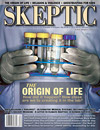 The Origin of Life
The Origin of Life
Skeptic magazine volume 16, number 2 -
Topics in this issue include: How Did Life Begin: A Perspective on the Nature and Origin of Life; An Incomprehensible Universe: Why the Human Brain is Ill-Equipped to Grasp the True Nature of Nature; Broadcasting from the Great Beyond: A review of Consciousness Beyond Life: The Science of the Near-Death Experience; How Close Are We to Creating Life in the Lab?; Who Still Believes in 9/11 Conspiracies?; What is Naturopathy?; Was Hypatia of Alexandria a Scientist?; Stradivarius Pseudoscience; Lying About Placebos… Order the back issue.
-
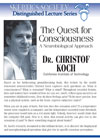 The Quest for Consciousness
The Quest for Consciousness
by Dr. Christof Koch
-
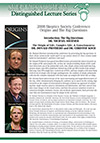 Origins & The Big Questions:
Origins & The Big Questions:
Conference 2008. Part 1
with Dr. Christof Koch -
Dr. Christof Koch delivers one of the most entertaining and laugh-filled lectures of the day, while simultaneously bringing the audience up to speed on the cutting edge research on the origins of consciousness through a bottom-up approach of analyzing how single neurons process stimulation and information, and then convert that into visual images in the visual cortex, and how this process somehow results in conscious thought, emotions, reason, and aesthetic appreciation. Koch presents the case that our consciousness may be unique in the universe. Order the conference DVD.
-
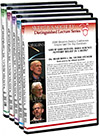 Origins & The Big Questions
Origins & The Big Questions
Conference 2008 (5 Part Set)
with Donald Prothero, Leonard Susskind, Paul Davies, Sean Carroll, Christof Koch, Kenneth miller, Nancey Murphy, & Michael Shermer -
Today, there is arguably no hotter topic in culture than science and religion, and so much of the debate turns on the “Big Questions” that involve “origins ”: the origin of the universe, the origin of the “fine-tuned” laws of nature, the origin of time and time’s arrow, the origin of life and complex life, and the origin of brains, minds, and consciousness. Now, science is making significant headway into providing natural explanations for these ultimate questions, which leaves us with the biggest question of all: “Does science make belief in God obsolete?” we have assembled some of the world’s greatest minds to discuss some of the world’s greatest questions. In 2008, the Skeptics Society held a conference wherein we assembled some of the world’s greatest minds to discuss some of the world’s greatest questions…
READ more about this conference and order the 5-part DVD set.
OR, order single DVDs: part 1 | part 2 | part 3 | part 4 | part 5
-
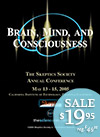 Brain, Mind, Consciousness:
Brain, Mind, Consciousness:
Conference 2005
with Dr. Christof Koch
Announcing The Amaz!ng Meeting 2012
Southpoint Hotel & Casino, Las Vegas, NV
July 12–15, 2012
THE AMAZ!NG MEETING (TAM) is an annual celebration of science, skepticism and critical thinking. People from all over the world come to TAM each year to share learning, laughs and the skeptical perspective with their fellow skeptics and a host of distinguished guest speakers and panelists.
The James Randi Educational Foundation (JREF) has hosted its annual Amaz!ng Meeting since 2003 as a way to promote science, skepticism and critical thinking about paranormal and supernatural claims to the broader public. TAM has been held in Las Vegas, NV since 2004 and has become the world’s largest gathering of like-minded science-advocates and skeptics.
With yet another incredible lineup of speakers, hands-on workshops, and entertainment, this is sure to be an Amaz!ng Meeting you won’t want to miss! Check out the entire program, and follow @jref on Twitter for the latest #TAM2012 news and announcements.
Consciousness: Confessions of a Romantic Reductionist
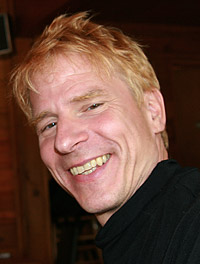
WHAT LINKS CONSCIOUS EXPERIENCE OF PAIN, joy, color, and smell to bioelectrical activity in the brain? How can anything physical give rise to nonphysical, subjective, conscious states? Neuroscientist Christof Koch has devoted much of his career to bridging the seemingly unbridgeable gap between the physics of the brain and phenomenal experience. Koch recounts not only the birth of the modern science of consciousness but also the subterranean motivation for his quest—his instinctual (if “romantic”) belief that life is meaningful. Koch describes his own groundbreaking work with Francis Crick in the 1990s and 2000s and the gradual emergence of consciousness (once considered a “fringy” subject) as a legitimate topic for scientific investigation. Koch gives us stories from the front lines of modern research into the neurobiology of consciousness as well as his own reflections on a variety of topics, including the distinction between attention and awareness, the unconscious, how neurons respond to Homer Simpson, the physics and biology of free will, dogs, sentient machines, and Der Ring des Nibelungen.
TAGS: consciousness, Der Ring des Nibelungen, free will, neuroscience, unconscious12-05-09
In this week’s eSkeptic:
- The Latest Issue of Skeptic magazine: Climate Change Q & A
- Follow Michael Shermer: Where in the world are the atheists?
- Lecture at Caltech this Sunday: Dr. Christof Koch
- Skepticality: Interview with Comedian “Dr. Pete”
- The Amaz!ng Meeting 2012: July 12–15 in Las Vegas, Nevada
- Freethought Alliance Conference: May 19–20 in Irvine, California
- Feature Article: Exposing the Chupacabra: A Morphing Modern Monster
Announcing the Latest Issue
of Skeptic Magazine
TOPICS IN THIS ISSUE INCLUDE: How We Know Global Warming is Real and Human Caused; Special Section on Perception Self-Deception; Special Section on Evidence-Based Medicine; A Historical and Physiological Perspective on a World War II Aviation Mystery; Talking to the Dead: An Empirical Study on the Psychological Aspects of Interpreting Electronic Voice Phenomena; Sleep Paralysis; Energy Medicine and Fantasy Physics; Depression Treatment, and more…
Current subscribers should receive this issue by mid-May 2012.

NEW ON SKEPTICBLOG.ORG
Atheist Nation
Where in the world are the atheists? That is, in what part of the globe will one find the most people who do not believe in God? In this week’s Skepticblog, Michael Shermer shares some statistics collected and crunched by Tom W. Smith of the National Opinion Research Center (NORC) at the University of Chicago, in a paper entitled “Beliefs About God Across Time and Countries,” produced for the International Social Survey Programme (ISSP) and released on April 18, 2012.
Lecture this Sunday at Caltech:
Dr. Christof Koch

Consciousness: Confessions of a Romantic Reductionist
Sunday, May 13, 2012 at 2 pm
Baxter Lecture Hall
WHAT LINKS CONSCIOUS EXPERIENCE OF PAIN, joy, color, and smell to bioelectrical activity in the brain? How can anything physical give rise to nonphysical, subjective, conscious states? Neuroscientist Christof Koch has devoted much of his career to bridging the seemingly unbridgeable gap between the physics of the brain and phenomenal experience. Koch recounts not only the birth of the modern science of consciousness but also the subterranean motivation for his quest—his instinctual (if “romantic”) belief that life is meaningful…
NEW ADMISSION POLICY FOR BAXTER HALL
Due to security concerns, Baxter Hall will be locked and the audience will be admitted only through the doors on the South side of the building by the lily ponds. If, for medical reasons, you cannot climb the stairs to the hall on the 2nd floor, someone at the main entrance (located in the middle of the West side of the building) will escort you to the elevator.
TICKETS are first come, first served at the door. Seating is limited. $8 for Skeptics Society members and the JPL/Caltech community, $10 for nonmembers. Your admission fee is a donation that pays for our lecture expenses.
Followed by…
The Secrets of Mental Math: The Mathemagician’s Guide
to Lightning Calculation and Amazing Math Tricks
with Dr. Art Benjamin, Sunday, June 10, 2012 at 2 pm
Baxter Lecture Hall, Caltech, Pasadena, CA

Interview with Comedian “Dr. Pete”
SKEPTICALITY EPISODE 182

When it comes to certain topics, people sometimes seem to turn a blind eye to the evidence and research that have been collected over the past few hundred years of systematic inquiry. Can comedy bring a bright candle to ideas that other methods struggle to illuminate?
In this episode of Skepticality, Derek welcomes a special in-studio guest, Dr. Peter Ludovice (a.k.a. “Dr. Pete”), a popular stand up comedian who performs his show with a twist of science and rational thinking. Ludovice, also an Associate Professor of Chemical and Biomolecular Engineering at Georgia Tech, discusses how he uses his interesting mix of professions to reach out to his students and audiences across the United States.
Announcing The Amaz!ng Meeting 2012
Southpoint Hotel & Casino, Las Vegas, NV
July 12–15, 2012
THE AMAZ!NG MEETING (TAM) is an annual celebration of science, skepticism and critical thinking. People from all over the world come to TAM each year to share learning, laughs and the skeptical perspective with their fellow skeptics and a host of distinguished guest speakers and panelists.
The James Randi Educational Foundation (JREF) has hosted its annual Amaz!ng Meeting since 2003 as a way to promote science, skepticism and critical thinking about paranormal and supernatural claims to the broader public. TAM has been held in Las Vegas, NV since 2004 and has become the world’s largest gathering of like-minded science-advocates and skeptics.
With yet another incredible lineup of speakers, hands-on workshops, and entertainment, this is sure to be an Amaz!ng Meeting you won’t want to miss! Check out the entire program, and follow @jref on Twitter for the latest #TAM2012 news and announcements.
JOIN FREETHINKERS AT THE THIRD ANNUAL conference of the Orange County Freethought Alliance, May 19–20 2012, at the University of California, Irvine.
SECULAR SPEAKERS INCLUDE: Robert Price, Phil Zuckerman, Dave Silverman, Aron Ra, Richard Carrier, Jim Underdown, Barbara Forrest, Brian Dunning, Mr Deity, Dan Barker, Edward Tabash, Dave Richards, Heina Dadabhoy, and Michael Shermer.
This two-day conference is divided into Saturday’s afternoon/evening sessions and Sunday’s morning/afternoon sessions. You may purchase a one-day ticket for either day or a two-day ticket.
About this week’s eSkeptic
In this week’s eSkeptic, Sharon Hill reviews Benjamin Radford’s latest book, Tracking the Chupacabra: The Vampire Beast in Fact, Fiction, and Folklore. The book was nominated as a Finalist for the 2011 ForeWord Reviews’ Book of the Year Award in the social science category, and was a Finalist for the New Mexico Book Awards.
Sharon Hill is a skeptical writer and blogger specializing in topics connecting science and the public. She has a personal web site “Doubtful” which covers topics of general skeptical goodness and runs the critical thinking newsblog, Doubtfulnews.com. The Doubtful NewsBlog is syndicated hourly, right here on skeptic.com.

Exposing the Chupacabra:
A Morphing Modern Monster
by Sharon Hill
The paranormal explanation can be the quick, easy and popular route to go compared to the genuine one, which is far more complex. We, as a culture, create our monsters to suit us, smearing the line between fiction and reality, paranormal and normal, as needed. That’s what Tracking the Chupacabra: The Vampire Beast in Fact, Fiction and Folklore is about. Author Benjamin Radford admits this book is not actually about the “monster” called “chupacabra”1 but about how folklore becomes real, how humans tell and receive stories, and how memories can be wrong. In this comprehensive examination, Radford shows us that “chupacabra” is not an explanation for a specific phenomenon; it’s a convenient scapegoat utilized in circumstances perceived as threatening or bizarre.
Descriptions of the chupacabra as a real creature are problematic. Its chameleon-like, shape-shifting nature became one of its hallmarks. The tale of the monster begins with livestock attacks in Puerto Rico in 1995, which is explained in part one of the book. The animals were found reportedly drained of blood. An unidentified, mysterious vampiric killer was on the loose and the media embraced the story. Naming the creature “chupacabra” (goat sucker) brought it into being. Confusion over its physical description finally sharpened in response to the widely publicized description by witness Madelyn Tolentino. Her story is scrupulously examined in the key chapter of the book, Chapter 7, where Radford concludes that Tolentino’s recollections and interpretations hold the key to solving the mystery of the chupacabra. Based on the Tolentino report, the chupacabra was an otherworldly humanoid with spines, claws, red eyes and a curious hopping locomotion. A subsequent second body form associated with the chupacabra was smaller, essentially hairless and dog-like. This type was based upon actual animals killed in proximity to livestock attacks. They appeared far too grotesque to be common fauna. A third bin of creatures labeled “chupacabra” was filled with any unusual thing regardless of size, number of limbs and body shape. If one couldn’t identify a creature right away or affirm that it was a recognized animal, it was called chupacabra.
Prior to Radford’s book, there was only one other volume dedicated to the subject—Scott Corrales’ Chupacabras and Other Mysteries.2 Corrales’ work is a collection of chupacabra-related incidents including encounters (reported in the local press and some obtained directly by the author), livestock attacks and UFO reports. Presented as a diary through the years where the legend blossomed and spread, Corrales’ book connects the chupacabra stories to interpretations in terms of UFOs and alien visitation. Corrales’ book is a collection of tales, uncritical of eyewitness’ testimony and paranormal explanations. Radford, as a scientific and skeptical investigator, launches from a foundation based on collected evidence. The intent of his quest is to solve the mystery, not to promote it. This is a fundamental difference between the few genuinely useful cryptozoological references and the profusion of popular, often speculative, monster books which rehash anecdotes without scrutiny or analysis.
In multiple approaches to the chupacabra enigma, Radford explores the following topics: vampires and other blood-eating animals, folklore, mass hysteria, cultural influences and socioeconomic factors, sarcoptic mange and canid genetics, animal deaths and postmortem effects, and the trouble with eyewitness reports and making unsupported assumptions.
In an intriguing part two, Radford discusses the cultural aspects, considering vampires across cultures and the metaphor of a society sucked dry by outsiders. “It is undoubtedly true,” he writes, “that the chupacabra drew much of its notoriety and power from the fabric of Puerto Rican culture, society and politics” (page 37). The fertile meme of a modern blood-sucking monster spread all over the world thanks to the new Internet age. The chupacabra became a pop culture icon and the star of books and movies.
In spite of many critics’ claims to the contrary, Radford concludes that the creature sprang into existence in 1995. It simply didn’t exist before this. In order to test his claim, Radford publicly offered a $250 reward for anyone who could provide a written reference of the chupacabra (as we now know it) dated prior to 1990. Four months later, he reported to me he received no dated references.
Part three is the search for the beast in the flesh. This book is an example of how thorough investigation works. Assuming that monster (or any other wild) stories are literally true is not research; one needs to question and go under the surface, pick it apart. To do this, Radford went to great lengths: trekking into the Latin American jungles to search for traces of a live one, exposing the exaggerations by witnesses and the shabby scholarship by reporters, and examining a frozen severed head of a supposed chupacabra. Investigation clearly isn’t pretty or always fun. Cryptozoologists almost never obtain a body, yet in the case of the chupacabra, many carcasses were put forth for examination. Typically missing hair, with odd-colored skin and strange dentition, tests showed that they were dogs, coyotes and even a raccoon—normal species suffering from sarcoptic mange and perhaps other related illnesses. They looked abhorrent but they were not unknown to science.
In part four, Radford questions the origin of the chupacabra in consideration of all the evidence and extraordinary claims. Strange events don’t occur in a vacuum, he notes. Indeed. Radford puts forth convincing connections to show that the origin of the mysterious chupacabra had very Hollywood connections and was distorted through human foibles. Circumstances came together in the construction of the narrative that brought a blood-sucking monster to life in Latin America and the southern United States. The final chapter is a surprisingly fundamental piece—a look into the zoology of actual blood sucking/eating animals. I had never seen the obvious problem pointed out before: dog-like animals can’t suck. It takes specialized physiology to do so. Curiously, we can observe the “vampire” characteristic falling away from the recent (and ongoing) flap of hairless dog-like reports of chupacabras. Our pop culture beast continues to evolve.
Eyewitnesses in the chupacabra story believed something out-of-the-ordinary had happened to them. When testing and solid evidence showed that carcasses were a sickly coyote or domestic dog, or that their livestock were most likely killed by dogs instead of a frightening vampire beast, they rejected that explanation. Instead, they sought only that which confirmed their belief. They embraced fantastic tales of a mutant, hybrid or government plot. Some preferred to blame extraterrestrials or Satan himself. Too often, they invented elements to make it fit their perception. When a person has a good bit invested in a story, they will not readily exchange it for a mundane explanation. Fact be damned—they know otherwise. Thus, the most powerful lesson reinforced by Radford’s necropsy of the chupacabra legend is one that resonates with those who provide sound, logical explanations for seemingly paranormal explanations…people don’t want to hear the truth. This is the hurdle we face every day as scientific skeptics.
Tracking the Chupacabra is satisfying for those willing to consider a legitimate, evidence-based explanation. If you aren’t happy to do that, this book will make you mad. I’m hard pressed to find any stone unturned in this stunning exposé of the first Internet-age cryptid.
References
- There is dispute about whom to attribute the first use of “chupacabra” or “chupacabras” or “el chupacabras”. Radford sticks with the most straightforward moniker that translates to “goat sucker”.
- Corrales, Scott (1997). Chupacabras and Other Mysteries. Greenleaf Publications. 248p.
Suggestions for Further Reading on the Topics of Cryptozoology and Paranormal Investigation…
-
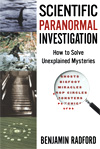 Scientific Paranormal Investigation
Scientific Paranormal Investigation
by Benjamin Radford
Monsters in Junior Skeptic magazine…
Bound into every issue of Skeptic magazine, Junior Skeptic is an engagingly illustrated science and critical thinking publication for younger readers.
Junior Skeptic is our flagship educational periodical, written for both the young and the young at heart. In each issue, readers are invited to consider the background, concepts, and arguments surrounding a major paranormal claim (such as the Bermuda Triangle, or Bigfoot). Junior Skeptic explores the best evidence in support of these claims, but also exposes where thinking went wrong—and how. Accessible but not simplistic, Junior Skeptic has often gone toe to toe with the bigshots of the paranormal world. Add these monsters to your collection…
12-05-02
In this week’s eSkeptic:

NEW ON MICHAELSHERMER.COM
Much Ado about Nothing
Why is there something rather than nothing? This is one of those profound questions that is easy to ask but difficult to answer. In Michael Shermer’s May “Skeptic” column for Scientific American, he discusses several of the various scientific theories for why there is something (a universe) rather than nothing.
Our Next Lecture at Caltech:
Dr. Christof Koch

Consciousness: Confessions of a Romantic Reductionist
Sunday, May 13, 2012 at 2 pm
Baxter Lecture Hall
WHAT LINKS CONSCIOUS EXPERIENCE OF PAIN, joy, color, and smell to bioelectrical activity in the brain? How can anything physical give rise to nonphysical, subjective, conscious states? Neuroscientist Christof Koch has devoted much of his career to bridging the seemingly unbridgeable gap between the physics of the brain and phenomenal experience. Koch recounts not only the birth of the modern science of consciousness but also the subterranean motivation for his quest—his instinctual (if “romantic”) belief that life is meaningful. Koch describes his own groundbreaking work with Francis Crick in the 1990s and 2000s and the gradual emergence of consciousness (once considered a “fringy” subject) as a legitimate topic for scientific investigation. Koch gives us stories from the front lines of modern research into the neurobiology of consciousness as well as his own reflections on a variety of topics, including the distinction between attention and awareness, the unconscious, how neurons respond to Homer Simpson, the physics and biology of free will, dogs, sentient machines, and Der Ring des Nibelungen.
TICKETS are first come, first served at the door. Seating is limited. $8 for Skeptics Society members and the JPL/Caltech community, $10 for nonmembers. Your admission fee is a donation that pays for our lecture expenses.
Followed by…
The Secrets of Mental Math: The Mathemagician’s Guide
to Lightning Calculation and Amazing Math Tricks
with Dr. Art Benjamin, Sunday, June 10, 2012 at 2 pm
Baxter Lecture Hall, Caltech, Pasadena, CA

Qu’est Que C’est?
Remorseless killers are the stuff of countless films. Sadly, the real world has even more of them. Jack the Ripper, Ted Bundy, H. H. Holmes, John Wayne Gacy—these remorseless psychopaths filled graveyards with corpses and sleeping minds with nightmares. But these aren’t monsters—they’re real people who have a brain that developed differently than most peoples. Author Jon Ronson joins us on this episode of MonsterTalk to discuss the condition of psychopathy—and to share with us his journey into the world of these dangerous people.
The Latest Episode of Mr. Deity: Mr. Deity and the Latter-Days
WATCH THIS EPISODE | DONATE | NEWSLETTER | FACEBOOK | MrDeity.com
About this week’s eSkeptic
In this week’s eSkeptic, Ueli Rutishauser reviews Christof Koch’s latest book entitled, Consciousness: Confessions of a Romantic Reductionist (Cambridge: MIT Press, 2012, ISBN-13: 978-0262017497). Dr. Koch will present a lecture at Caltech (based on this book) on May 13, 2012 at 2pm.
Ueli Rutishauser is a neuroscientist who studies the neural mechanisms by which animals learn. He records the activity of single neurons in the human brain in neurosurgical epilepsy patients, which has lead to the discovery of novelty detecting neurons. He is a Group Leader at the Max Planck Institute for Brain Research in Frankfurt am Main, Germany and holds a Ph.D. in Computation & Neural Systems from the California Institute of Technology. His research has been published in journals such as Nature, Neuron, Current Biology, Neural Computation, and Proceedings of the National Academy of Science.

What’s it Like to be a Brain?
by Ueli Rutishauser
The human brain is the most complex system ever studied, but it is nevertheless a physical system obeying physical laws. How is it that this system, unlike many others, has subjective internal states and experiences? Why does it feel like something to be the conscious person you are? Why do we feel personal ownership and responsibility for our actions?
Historic and religious approaches to the ancient mind-body distinction have called for some form of dualism to bridge the physical and the mental. However, the advent of modern neuroscience with its increasingly detailed understanding of the inner workings of the brain has given rise to the hope that we will be able to conquer this final frontier and reduce the mind to the brain, to give a rational explanation of the subjective. This quest has lead to the birth of the scientific study of consciousness, which was previously the exclusive providence of philosophy.
In his new book, Caltech neuroscientist Christof Koch describes what the latest findings from the front lines of neurobiology tell us about consciousness and free will together with his innermost thoughts, feelings and motivations in a highly personal narrative. Koch’s previous book, Quest for Consciousness (Roberts & Company, 2004), which has become a standard scholarly text, laid out the scientific rational for the search for what he and his collaborator Francis Crick coined the neural correlates of consciousness. In contrast, Koch’s new book gives readers an unusually personal view into how and why he conducts his science, how new results emerge and what deep motivations are driving the author as a scientist and person to devote decades of his life to the quest of explaining consciousness. “I want to know before I die,” he confesses, “so I can’t afford to wait forever.”
Much has been written by philosophers about subjective thoughts and feelings, leading to heated debates between proponents of various “isms”. However, philosophy can merely be speculative. “Philosophers deal in belief systems, simple logic, and opinions, not in natural laws and facts,” Koch notes, “but they have a mediocre historical record of prognostication.” He describes a conversation with philosopher David Chalmers, who coined the term “The Hard Problem” for explaining consciousness. Chalmers claimed that consciousness would forever resist rational explanation and that no future discovery or conceptual advance could ever convince him otherwise. On the contrary, Koch argues that scientific and technological developments have allowed humanity to understand phenomena previously resistant to rational explanation and that this will undoubtedly also be the case for the problem of how a physical system can give rise to subjective experience.
Koch’s approach is anchored in the principle that there is a minimal set of neuronal mechanisms that are jointly sufficient for a specific conscious percept—the neural correlates of consciousness (NCC). According to this definition, most neurons are not part of the NCC. For example, activity in the retina is correlated with visual consciousness, but is not sufficient to cause it. In fact, most retinal activity never makes it into awareness. In binocular rivalry, activity in early visual cortex (V1) does not predict conscious awareness, whereas activity in higher areas such as inferotemporal (IT) cortex does. Thus, Koch concludes that some neurons in IT are likely to be part of the NCC whereas neurons in the retina or V1 are not. Further, he notes that “large parts of the cerebral cortex can be destroyed without any overall loss of function after recovery” and these are thus not part of the NCC either. The cerebellum, for example, contains more neurons than the human cortex, but its loss does not impair consciousness but rather fine motor movements. On the other hand, a comparatively small bilateral lesion in a particular area of the brainstem leads to irreversible loss of consciousness, leaving the person in a vegetative state. This is an example of what Koch calls enabling factors of consciousness—neurons without which consciousness cannot exist but activation of which does not in itself cause a particular conscious percept. The NCC proper, the specific factors, consist of the particular neuronal events that cause the percept. Localized lesions, such as those leading to an inability to see color or faces, impair particular NCCs. Thus, the NCCs are both highly localized and specific as opposed to being a holistic global property of the brain. Koch’s quest hinges on identifying these specific factors, a strategy that has been very successful in driving research.
If a neuronal mechanism is sufficient to cause a subjective percept, activation of this NCC should both precede the percept in time and cause it some time later. Experimental evidence for NCCs comes from electrical stimulation with microelectrodes during surgical procedures. Depending on the stimulation site, these evoke a smell, a memory of your grandmother, the urge to move a limb, or feelings of familiarity—all subjective percepts. Koch, together with his UCLA collaborator Itzhak Fried, has discovered concept cells deep within the temporal lobes. They are active when viewing images of a particular person such as Bill Clinton, but also when seeing his name written on a screen or hearing him speak. New findings described in the book also show that these cells are activated when people think about a concept, leading Koch to conclude that they are likely part of the NCC for the concepts that they respond to and are presumably also the neurons that are activated by the electrical stimulation that led to the conscious percepts.
These immensely important findings result from observing and disturbing the brain in the currency in which it operates—the neuron. As Koch poignantly notes, they go much beyond the often naive phrenological interpretations made based on “hot spots” found using neuroimaging techniques such as fMRI or PET that tell us little about what particular neurons are doing but frequently are the only evidence for claims that some area is “the neural correlate” of something. In Koch’s words, “consciousness does not arise from regions but from highly networked neurons within and across neurons.” The claims that have been made as to the “neural correlates” of consciousness-related functions based entirely on neuroimaging are troublesome. Even if we assume that such functions can be localized, they only tell us where something happens, not how and why. Neurons are the atoms of perception, so this should be the unit of measurement.
What about the neural mechanisms that constitute the NCC enables them to generate phenomenal experience? Koch believes that consciousness is a fundamental property of organized matter that cannot be further reduced to elementary properties. This belief rests on information theoretic arguments. Koch provides a very readable description of how the interaction of physical elements could lead to subjective states—the theory of integrated information. In the consciousness literature, theoretical too often stands for speculative descriptive models. Refreshingly, in this case it means a mathematical model. While this is the most speculative chapter of the book, it makes predictions that can be validated. The theory predicts to what extend a particular system is conscious. Is a dog conscious and if so how is it different from an awake human? How about a human in a coma? How about an iPhone? Koch argues that any system is conscious to some degree, permitting, in principle, conscious machines. It also follows that even simple animals have some degree of phenomenal experience.
As is so often the case in science, the question of what consciousness is can be reduced to “How can we measure it?” Conscious states are highly informative since each differentiates between many possible other states by ruling them out. At the same time, any such state integrates a large amount of information. The theory proposes a quantity called “Phi” that quantifies, in units of bits, the amount of integrated information generated by a particular state above and beyond the information provided by the parts. Phi specifies the quantity of conscious experience that this particular state provides. The total number of all possible such states that a system has specifies the quality of conscious experience. While computationally expensive, Phi can be calculated for both biological and artificial networks.
The integrated information approach predicts that in states of reduced consciousness, information in the brain should propagate less readily. This can be measured by estimating the spread of a disturbance caused by transcranial magnetic stimulation. Indeed, experiments show that such disturbance spreads widely in awake brains, whereas it stays local in deep sleep. Illustrating the power and potential usefulness of this approach for building a “conscious-meter,” this measure could differentiate between patients who are either in a vegetative state or a minimally conscious state. Distinguishing between different states of unconsciousness is an incredibly difficult task that would be greatly facilitated by such a measurement. Intriguingly, this approach could also predict which coma patients would later regain awareness.
Free will is a difficult and discomforting topic to which Koch provides an insightful perspective. After summarizing arguments from classical and quantum physics, Koch concludes that at present it is unknown how the brain makes decisions which are “free”—neither random nor pre-determined. Nevertheless, he identifies possible sources of indeterminism that, in principle, allow free decisions. The argument is that we do not have free will in the Cartesian or libertarian sense because it is incompatible with determinism. That is, given a past decision and exactly identical circumstances (including internal brain state), we could not have acted other than we did. In contrast, most scientists believe in compatibilism, which holds that we are free if we can follow our own desires and preferences. But determinism does not imply predictable—the future of a complex deterministic system is inherently unpredictable even in the absence of randomness (which is apparent everywhere in the nervous system).
We believe that we have free will because of the sense of agency, the feeling that we willed an action. Koch argues that the feeling of agency is nothing but a conscious percept, with an NCC that can be studied like any other. The brain makes decisions before the conscious mind is aware a decision has been made. This tells us neither how decisions are made nor that we lack free will, but that decisions are made before we become aware of them and that agency plays no role in making them. The agency aspect of free will is orthogonal to how decisions are made.
I found Confessions of a Romantic Reductionist to be highly engaging, making inroads into several deeply difficult and controversial topics and enlightening each with what modern neurobiology has to offer. Its assessment of the state of the art is enthusiastic but fair, making clear that we are only at the very beginning of this quest. As such, Koch’s assessment of our present understanding of neuronal processes and how these give rise to consciousness shows that we are still very far from Ray Kurzweil’s singularity, the point at which computers reach human-level intelligence. Confessions of a Romantic Reductionist combines cutting edge science with personal stories—including the author’s struggle with religion—and I highly recommend it for anyone with an interest in consciousness and its neural basis.
Skeptical perspectives on consciousness
from Christof Koch…
-
 The Quest for Consciousness
The Quest for Consciousness
by Dr. Christof Koch
-
 Origins & The Big Questions:
Origins & The Big Questions:
Conference 2008. Part 1
with Dr. Christof Koch
-
 Brain, Mind, Consciousness:
Brain, Mind, Consciousness:
Conference 2005
with Dr. Christof Koch
Dr. Leonard Mlodinow — Subliminal: How Your Unconscious Mind Rules Your Behavior

From the best-selling author of The Drunkard’s Walk and coauthor of The Grand Design (with Stephen Hawking) and War of the Worldviews (with Deepak Chopra) comes a fascinating, illuminating examination of the profound ways in which the unconscious mind shapes our lives. Every aspect of our mental lives plays out in two versions: one conscious, which we are constantly aware of, and the other unconscious, which remains hidden from us. Over the past two decades researchers have developed remarkable new tools for probing the unconscious, or subliminal, workings of the mind. This explosion of research has led to a sea change in our understanding of how the mind affects the way we live. As a result, scientists are becoming increasingly convinced that how we experience the world—our perception, behavior, memory, and social judgment—is largely driven by the mind’s subliminal processes and not by the conscious ones, as we have long believed.
You play a vital part in our commitment to promote science and reason. If you enjoyed this Distinguished Science Lecture, please show your support by making a donation.
TAGS: Leonard Mlodinow, subliminal processes, unconscious mind12-04-25
In this week’s eSkeptic:

NEW ON SKEPTICBLOG.ORG
Shermer in Seminary School
In this week’s Skepticblog, Michael Shermer recounts his experience presenting arguments on the question of “Is There Life After Death?” in a debate with theologian Gary Habermas that took place on Friday, April 13, 2012 in the chapel of the New Orleans Baptist Seminary.
Lecture at Caltech this Sunday:
Dr. Leonard Mlodinow

Subliminal: How Your Unconscious Mind Rules Your Behavior
with Dr. Leonard Mlodinow
Sunday, April 29, 2012 at 2 pm
Baxter Lecture Hall
FROM THE BEST-SELLING AUTHOR of The Drunkard’s Walk and coauthor of The Grand Design (with Stephen Hawking) and War of the Worldviews (with Deepak Chopra) comes a fascinating, illuminating examination of the profound ways in which the unconscious mind shapes our lives. Every aspect of our mental lives plays out in two versions: one conscious, which we are constantly aware of, and the other unconscious, which remains hidden from us. Over the past two decades researchers have developed remarkable new tools for probing the unconscious, or subliminal, workings of the mind. This explosion of research has led to a sea change in our understanding of how the mind affects the way we live. As a result, scientists are becoming increasingly convinced that how we experience the world—our perception, behavior, memory, and social judgment—is largely driven by the mind’s subliminal processes and not by the conscious ones, as we have long believed.
TICKETS are first come, first served at the door. Seating is limited. $8 for Skeptics Society members and the JPL/Caltech community, $10 for nonmembers. Your admission fee is a donation that pays for our lecture expenses.
Followed by…
Consciousness: Confessions of a Romantic Reductionist
with Dr. Christof Koch, Sunday, May 13, 2012 at 2 pm
Baxter Lecture Hall, Caltech, Pasadena, CA

Skepticality
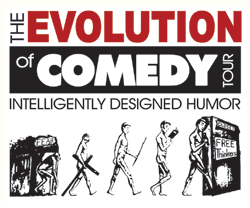
Interviews with Ian Harris
and Bob Carroll
This week on Skepticality, Derek talks to Ian Harris, one of a troupe of comedians whose “Evolution of Comedy Tour” covers topics science-loving folks will really enjoy. Ian and Derek discuss why comedy is a great fit for talking about skeptical and scientific issues. Later in this episode, Derek checks in with Bob Carroll to discuss his new e-book, Unnatural Acts, which he produced as part his ongoing efforts on The Skeptic’s Dictionary.
MonsterTalk

Onan the Jar Burying
In modern science the homunculus refers to various models of the human mind, but in medieval times it was something quite different. Join us for a fascinating interview with professor William R. Newman, of Indiana University’s Department of History and Philosophy of Science. He is the author of seven books, including Promethean Ambitions: Alchemy and the Quest to Perfect Nature—a book which provides much insight into the seedy back-story of this strange creature.
This episode contains adult material and may be unsuitable for junior skeptics.
About this week’s eSkeptic
In this week’s eSkeptic, Skeptic magazine’s religion editor demonstrates how the Christian apologetic argument of creation ex nihilo (that God created the universe out of nothing), is not dissimilar to earlier creation myths.
The Genesis creation myth
is not unique
by Tim Callahan
The Skeptics Society Great Debate on Sunday, March 25, “Has Science Refuted Religion?,” (watch it for free on skeptic.com) featured physicist Sean Carroll and Skeptic publisher Michael Shermer debating physicist Ian Hutchinson and conservative author Dinesh D’Souza. At one point Ian Hutchinson fished out an old chestnut of an argument, one often used by Christian apologists, that, to my mind, has too long gone without rebuttal. He stated that, of all the ancient creation myths only Genesis 1 features a transcendent deity who created the universe out of nothing and is independent of it. The argument, which Dinesh D’Souza also used in his 2007 book, What’s So Great About Christianity, is basically this: According to Big Bang cosmology the universe was created seemingly out of nothing 13.7 billion years ago; Genesis 1, featuring a god that created the universe ex nihilo (out of nothing) is compatible with modern physics; and, in featuring a transcendent god—as opposed to gods who themselves rose out of a watery abyss and therefore did not transcend the physical world—is unique among all the ancient creation myths. This Christian apologetic argument, known as creation ex nihilo, is obscure enough that scientists and others debating Christian apologists are often baffled by it and without a reasonable rebuttal.
In reality, the doctrine of creation ex nihilo is based on substance so gossamer thin that it’s surprising it can be seen to support such an edifice of theology. In fact, the entire argument rests on a single Bible verse, namely Genesis 1:1: “In the beginning God created the heavens and the earth.” It is only because the verse neglects to say out of what God made the heavens and the earth that one can assume he made it out of nothing. Beyond being based on a single Bible verse, the doctrine of creation ex nihilo and the argument, voiced by both Hutchinson and D’Souza, for the unique nature of the transcendent God of Genesis and the compatibility of Genesis 1 with the Big Bang, are unsustainable, not only in regards to physics and biblical interpretation, but most especially when Genesis 1 is compared to other, earlier creation myths.
Does the Big Bang theory in fact claim creation ex nihilo? Consider the 2012 book A Universe From Nothing by physicist Lawrence Krauss.1 It seems that the “nothing” out of which material universes rise is, in fact, a quantum field: a nothing that really is a something. Without becoming ensnared in the abstruse discipline of cosmology, about which most of us, myself included, are profoundly ignorant, I might observe that the quantum field can be metaphorically related to the primeval chaos out of which first things emerge in many creation myths. That metaphor notwithstanding, I will, however, refrain from making the quantum field an argument for the validity of neo-pagan theology.
A particular weakness of the argument for creation ex nihilo is that it demands a rigorous, one to one, translation of a single Hebrew word in Genesis 1:1, bara, when its proponents should know that the definition of Hebrew words is often complicated because they have multiple meanings dependent on context. Bara not can not only mean “create,” but as well, “choose,” or “divide,” among other meanings. According to one Old Testament scholar, Professor Ellen van Wolde, in the context of Genesis 1 bara should be translated as “separate.” Thus, Genesis 1:1 should be translated, “In the beginning God separated the heavens and the earth.2 This fits the context of Genesis 1, in which the creation is presented as a series of separations: light is created and separated from darkness, the firmament of heaven is created to separate the waters above it from the waters below it, and the separation of land from water. This is followed by a series of creation events populating the separated realms—the land populated with plants, the firmament populated with heavenly bodies, the sea populated with fish and sea monsters, the air with birds, and the land, again, with animals—followed finally by the creation of humans in the image of God.
Another blow to the uniqueness of Genesis 1 is that it is almost certainly based on the sequence of creation events in Enuma elish, the Babylonian creation epic. In this story, after killing the chaos dragon Ti’amat, Marduk slices her body in half lengthwise, top to bottom, using the top half to created the firmament of heaven, separating the waters above from the waters below, and using the bottom half to create land separate from the waters below.3 Before Marduk had killed her, Ti’amat ruled over a chaotic, formless void, much like the initial state of creation in Genesis 1:2: “And the earth was without form, and void, and darkness was on the face of the deep. And the spirit of God moved upon the face of the waters.”
The Hebrew word for the deep is tehom. In its feminine plural form, tehomot, “deeps,” it is cognate with the Akkadian, Ti’amat. Of course, Genesis 1 does not begin with a divine combat. That its author edited out an original combat between Yahweh and a chaos dragon can be seen from the many allusions to such a battle, with a serpent variously referred to as Leviathan and Rahab, salted throughout the Hebrew Scriptures. Consider the following:
Psalms 74:13, 14: Thou didst divide the sea by thy might. Thou didst break the heads of the dragons of the waters. Thou didst crush the heads of Leviathan. Thou didst give him as food for the creatures of the wilderness.
Psalms 89:10a: Thou didst crush Rahab like a carcass
Isaiah 51:9b: Was it not thou that didst cut Rahab in pieces, that didst pierce the dragon?
However, Christian apologists could easily argue that the similarities between Enuma elish and Genesis 1 are only coincidental and that Professor van Wolde is wrong in her interpretation of the verb bara. If, for the sake of argument, we accept that Genesis 1 clearly argues for creation ex nihilo, doesn’t that mean that it is unique among the many creation myths of the ancient world? In a word, no. While most of the Egyptian creation myths (there are several) begin with a creator deity rising from Nun, the watery abyss, there are a number of Egyptian papyri antedating the P Document creation story of Genesis 1—probably written no earlier than ca. 750 BCE—in which creation is presented as ex nihilo. One of these is the Papyrus of Princess Nesi Khensu, daughter of a priest-king of Thebes ca. 950 BCE, in which the god Amen Ra is conflated with the god Khepera or Khepri. The god is described as:4
…the lord of space, the mighty one of the form of Khepera, who came into existence in the form of Khepera, the lord of the form of Khepera; when he came into being nothing existed except himself.
An even earlier papyrus, the Papyrus Hunefur, now in the British Museum and dating from the 19th dynasty ca. 1285 BCE, referring to the God Ra, states:5
Thou art the one god who came into being in the beginning of time. Thou didst create the earth, Thou didst fashion man. Thou didst make the watery abyss of the sky [i.e. Nut]. Thou didst form Hapi [i.e. the Nile]. Thou didst create the great deep…
At this point, Christian apologists are likely to point out that the translations of Egyptian material by E.A. Wallis Budge are outdated and possibly faulty. However, in a more up to date translation of another text, a hymn to the god Ptah in the Papyrus Harris I, written during the reign of Ramesses III (1182–1151 BCE), also speaks of a transcendent god:6
Greetings to you exalted ancient one,
O Tatenen [Ptah] father of the gods,
Eldest god of the primeval time,
who shaped mankind and formed the gods,
Who began Becoming, is the first primeval god—
every event that occurred came after him.
Who created the sky according to what his heart imagined
and raised it like a feather
Who founded the world as his own creation,
circled it about with Ocean and the Great Green Sea
Who made the underworld, province for the dead
allowing Ra o sail across below to comfort them
Ruler of Eternity forever.
That Ptah is credited here with creating the sky and the sea, the two abysses from which the gods emerge, demonstrates that Ptah, in this hymn, was seen as independent of the abyss. This is reinforced a few lines down from those quoted above when Ptah is hailed as: “Who created the offerings for all the gods when he embodied himself as Nun, the primeval chaos.”7 Since, in those Egyptian creation stories in which the gods do rise out of the primordial chaos, that chaos or watery abyss is Nun, Ptah, by embodying himself as Nun becomes transcendent.
It was under Ramesses III that Bronze Age Egypt experienced its final hurrah, garrisoning troops in Canaan for the last time. Thus, even before the semi-legendary period depicted in the Book of Judges, when a tribal confederacy worshiping a henotheistic deity named Yahweh, was still competing for space with a host of other tribal groups, the already ancient civilization of Egypt had conceived of a transcendent god over all other gods, and this was not the God of the Bible.
Besides the Egyptians, the ancient Hindus also envisioned a creation ex nihilo, well before the P document was written. The Indian Rig Veda has been dated anywhere from ca. 1400 to ca. 1000 BCE. It asks:
If in the beginning there was neither Being nor Non-Being, neither air nor sky what was there? Who or what oversaw it? What was it when there was no darkness, light, life or death? We can only say that there was the One that which breathed of itself deep in the void, that which was heat and became desire and the germ of spirit.8
In fact, according to David Leeming, author of Creation Myths of the World, creation ex nihilo is about as common as creation from a pre-existing watery chaos.9
Thus, the God of the Bible was far from unique in creating ex nihilo, if indeed his Jewish creators even cared about such a theological fine point. He did not suddenly appear, transcendent, universal and alone, in stark contrast to a host of crudely conceived idols, gods of wood and stone, as the Bible presents it. Rather, his development was gradual and the concept of him as an eventually monotheistic, universal deity borrowed heavily from cultures that were old when Israel was young.
References
- Krauss, Lawrence. A Universe from Nothing. New York: Free Press.
- Alleyne, Richard. 2009. 2009. “God is not the Creator, claims academic” The Telegraph (U.K.) October 8.
- I document this in: Callahan, Tim. 2002. Secret Origins of the Bible. Millennium Press, p. 37.
- Wallis Budge, A. E. 1900 (republished in 1991). Egyptian Religion. New York: Carol Publishing Group, 131.
- Ibid., 49.
- Foster, John L., (translator) 1995. (ed. Susan T. Hollis). Hymns, Prayers and Songs: An Anthology of Ancient Egyptian Lyric Poetry. Atlanta: Scholars Press, 109.
- Ibid.
- Leeming, David Adams. 2010. Creation Myths of the World. (2nd ed). Santa Barbara, CA: ABC CLIO, 3.
- Ibid., 2–9.
Skeptical perspectives by Tim Callahan…
-
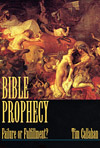 Bible Prophecy: Failure or Fulfillment?
Bible Prophecy: Failure or Fulfillment?
by Tim Callahan
-
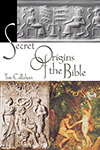 Secret Origins of the Bible
Secret Origins of the Bible
by Tim Callahan
12-04-18
In this week’s eSkeptic:

NEW ON LATIMES.COM
E-book overkill: Justice Dept. trustbusters should‘ve left Apple and book publishers alone
The US Justice Department filed suit last week against Apple Inc. and two major book publishers, Macmillan and Penguin Group USA, accusing them of colluding in 2010 to raise the prices of e-books. Read Michael Shermer’s response to the matter in Monday’s Los Angeles Times.
Our Next Lecture at Caltech:
Dr. Leonard Mlodinow

Subliminal: How Your Unconscious Mind Rules Your Behavior
with Dr. Leonard Mlodinow
Sunday, April 29, 2012 at 2 pm
Baxter Lecture Hall
FROM THE BEST-SELLING AUTHOR of The Drunkard’s Walk and coauthor of The Grand Design (with Stephen Hawking) and War of the Worldviews (with Deepak Chopra) comes a fascinating, illuminating examination of the profound ways in which the unconscious mind shapes our lives. Every aspect of our mental lives plays out in two versions: one conscious, which we are constantly aware of, and the other unconscious, which remains hidden from us. Over the past two decades researchers have developed remarkable new tools for probing the unconscious, or subliminal, workings of the mind. This explosion of research has led to a sea change in our understanding of how the mind affects the way we live. As a result, scientists are becoming increasingly convinced that how we experience the world—our perception, behavior, memory, and social judgment—is largely driven by the mind’s subliminal processes and not by the conscious ones, as we have long believed.
TICKETS are first come, first served at the door. Seating is limited. $8 for Skeptics Society members and the JPL/Caltech community, $10 for nonmembers. Your admission fee is a donation that pays for our lecture expenses.
Followed by…
Consciousness: Confessions of a Romantic Reductionist
with Dr. Christof Koch, Sunday, May 13, 2012 at 2 pm
Baxter Lecture Hall, Caltech, Pasadena, CA
About this week’s eSkeptic
In this week’s eSkeptic, Matthew Ainsworth reviews Stephen Greenblatt’s book: The Swerve: How the World Became Modern (W.W. Norton, 2011, ISBN: 0393064476).
Matthew F. Ainsworth holds an MA in American history, an MS in Library and Information Science, and is a member of The Magic Collectors Association. He is researching a cultural history of entertainment magic in America. He is also an atheist who enjoys membership in the New York Society for Ethical Culture.

How the World Swerved Toward Science
by Matthew F. Ainsworth
What do atoms, evolution, atheism, and sex have in common? One answer is De Rerum Natura (On the Nature of Things, sometimes translated as On the Nature of the Universe). This ancient Roman poem by Lucretius has inspired intellectuals for centuries and is a prime source for our knowledge of Epicurean philosophy, which added the pursuit of pleasure to Democritus’s theory of atoms, while extending the anti-theistic implications of the atomic theory. Unlike the other philosophers’ writings at the time, De Rerum Natura survived and, according to contemporaries, explained it more eloquently. The poem’s 15th century rediscovery and controversial implications are the subject of a surprisingly engaging and intellectually wide ranging new book by Stephen Greenblatt (Will in the World), The Swerve: How the World Became Modern.
The Preface opens, appropriately, with Greenblatt’s own discovery of the poem, which begins erotically (with Venus in the lap of Mars), but continues on to philosophy, death, and life, including the theory of atoms and evolution. “I marveled—I continue to marvel—that these perceptions were fully articulated in a poem written more than two thousand years ago”(6), writes Greenblatt, praising the poem’s “scientific vision of the world…with a poet’s sense of wonder”(8). This personal sense of discovery is also the theme of the first two chapters of The Swerve in which the controversial text of De Rerum Natura is rescued in 1417 from centuries of neglect by Poggio Bracciolini, a man who personifies the Renaissance ideal of the rebirth of classical learning. Greenblatt explains that many classical Greek and Roman texts that survived the collapse of their civilizations, decay, neglect, and fire, were preserved in monasteries but tragically later lost when monks scraped the ink from the pages of the scrolls they were indifferent to, to sell the paper for scrap or use it to copy religious texts. In 1417, on a cold January day the ancient text Poggio finds in a remote monastery, and gets permission to have copied, is Lucretius’s De Rerum Natura. Poggio’s excitement is conveyed in quotation from letters he wrote, with Greenblatt masterfully filling in context to make the scene vivid without slipping into the invention of detail.
Greenblatt then takes us back 1500 more years, reconstructing what little can be known of the man who created De Rerum Natura, and marveling that such a fragile piece of parchment survived at all. Lucretius is known to have written only one work, and less is known about him than about other ancient writers (according to The Dictionary of Literary Biography, Volume 211: Ancient Roman Writers, 154). Approximate contemporaries of Lucretius, the great philosopher poets Cicero (d. 43 BC) and Ovid (d. 17AD) praise the poem as Greenblatt reflects on the irony that the ancient eruption of the volcano Vesuvius, in destroying a city, preserved portions of it for future scholars including, it was recently confirmed, an original fragment of the Lucretius poem.
Greenblatt then returns to the early 15th century, discussing the historical context of the Florentine Renaissance and the early life of Poggio, and then his profession as Papal secretary and scriptor (part executive assistant, part intellectual counselor, part lawyer). Greenblatt then gets to the heart of Lucretius’s poem: atomism and what we would now call the scientific worldview, which turns out to be a scathing critique of religion and the supernatural, and a plea to live life responsibly but with pleasure. It is from the theory that invisible particles called atoms make up the universe that the other arguments in the poem follow, and it is thus fitting that the title of Greenblatt’s book, The Swerve, refers to a key passage saying that it is when atoms swerve from their straight course that life and change happens, including free will (188–189). Lucretius’s advocacy of what we would now call evolution follows from this. To quote Lucretius: “Sight did not exist before the birth of the eyes, nor speech before the creation of the tongue” (De Rerum Natura, book four, lines 836–837 (190). That the universe was not created for humans is implicit (190), and the finality of death (192–193) leads, at least in Greenblatt’s summary, to the conclusion that religion is false (193–195). Greenblatt (183–184) qualifies, with quotation, that Lucretius’s poem emphatically and poetically argues that Gods do exist but do not impact the ways nature works and do not intervene in human affairs. (Excerpts from Lucretius’ poem are the first selection in recently deceased skeptic Christopher Hitchens’ collection of writings on atheism, The Portable Atheist). This view leads to a measured celebration of pleasure, including what the poet W.B. Yeats called “the finest description of sexual intercourse ever written” (197).
Greenblatt ends by considering the poem’s cultural impact, much of which is presumptive: passages in a famous text (the executed heretic Giordano Bruno, the pioneering astronomer Galileo Galilei, Thomas More’s Utopia) are discussed at length by Grenblatt, and while they may echo Lucretius’ topics or style, it is too often without proof that they are referring to him. The case of Galileo is interesting: his 1633 Inquisition conviction was believed to be solely for his astronomical science, especially his 1632 Dialogue. “But in 1982 an Italian scholar…found…in the archives of the Holy Office….a memorandum detailing…evidence of atomism….” (p. 255) in Galileo’s 1623 The Assayer. Lucretius’s poem was the main way people learned of atomism in this era, so the evidence is circumstantial.
This is not to say that De Rerum Natura’s place in history is insecure, especially as a result of Poggio’s recovery. It was published by pioneering printer Aldus Minutis, and it was criticized formally: In 1516 the Florentine Synod prohibited teaching of Lucretius (226), although a 1549 proposal to include it on the Catholic Church’s Index of Prohibited Books was defeated. Leading intellectuals annotated their copies, or discussed it in writing: In 1961 it was confirmed by new techniques that the notes in a copy of De Rerum Natura now held by the Vatican were made by the political philosopher Niccolò Machiavelli (221), who joins French essayist Montaigne (243–249) and Thomas Jefferson (262–263) as confirmed fans.
Readers of Skeptic critical of the paranormal will, beyond mentions in Swerve, be intrigued to read that De Rerum Natura is quoted in the last two pages of Reginald Scot’s 1584 book The Discoverie of Witchcraft, while librarian Daniel Boorstin’s history from almost exactly four centuries later (The Discoverers) judges that “In one of the greatest Latin poems, De rerum natura, Lucretius…perpetuated ancient atomism” and argued that “there was no reason to fear death or supernatural powers,” concluding that Lucretius “became one of the most influential figures in the Renaissance” (Vintage, 1984, pp. 675–676).
Readers familiar with Lucretius’s poem may still be entranced by Greenblatt’s telling of its 1417 recovery and his discussion of the man who did so. Readers not familiar with Lucretius might want to start with the book’s final two chapters to appreciate the poem’s impact, before reading of its rediscovery. I’ve read few books in which sentences flow as easily as they do in Greenblatt’s Swerve. In lesser hands his parallel telling of the poem’s creation, recovery, and philosophical and religious implications would be confusing, but Greenblatt has the skill to pull it off: he seems comfortable in a range of academic disciplines, and he implicitly and explicitly draws parallels between the stories, the one enhancing the other: the theme of the Renaissance rediscovery, rather than a strictly chronological format, is a metaphor for the love of learning that is a theme for Greenblatt, and a hook for the discussion of the poem’s greatest impact in the 16th through 18th centuries, the Age of Reason and the Enlightenment.
The impact of Lucretius’s On the Nature of Things, the number of authors it influenced, is so great that some of the book’s puffery is unnecessary and makes me cringe. The praise or fascination by Cicero, Ovid, Machiavelli, Montaigne, Thomas Jefferson and W.B. Yeats are unambiguous, but the inner text reveals that the jacket copy paragraph emphasizing the impact on Galileo, Freud, Darwin, and Einstein is tenuous. Some of Greenblatt’s discussion of the impact of Lucretius is speculative: Virgil’s writing alluded to Lucretius, Erasmus and Thomas More discuss themes probably taken from Lucretius, the evidence for Shakespeare’s reading Lucretius is strong but circumstantial. Of Darwin and Einstein Greenblatt argues that if they were not influenced directly, it was because “these were only signs of Lucretius’ absorption into modern thought.” (262). Thus the subtitle of Greenblatt’s book, “How the World Became Modern” is publisher’s puffery, but not as egregious an example of it as I had thought before I read the book.
I could nitpick: a reference work (the aforementioned Dictionary of Literary Biography, p. 156) states that the poem is 7415 lines, not the 7400 lines that Greenblatt states (p. 182). Is Greenblatt approximating, has scholarship changed, or is the different line count due to a different translation? When Poggio recovered the text in 1417, he immediately sent his one and only copy to a friend, who apparently shared it with no one and did not return it to him until at least the end of 1429 (209). Does this make the repeated claim that Poggio returned Lucretius to circulation in 1417 (for example, p. 256) somewhat misleading? There are also cases where I might have written the book differently: lacking Greenblatt’s skill, a strictly chronological format might have made the arc of Lucretius’s impact easier to follow. Although there are quotes from Lucretius throughout Swerve, I would have been grateful for an appendix with extended excerpts. A timeline, including Lucretius’s approximate dates (they are in dispute, and the year he published De Rerum Natura unknown), major subsequent references to Lucretius and his poem, and key edition publications, would enhance understanding of the poem’s impact in a way that the inclusion of the same facts scattered throughout the text does not.
But these quibbles with Greenblatt’s book are small ones. Swerve is erudite and intellectually stimulating on multiple levels. The history of books and the love of learning, the tension between religion and science, and a critique of religion and the supernatural are all themes of Greenblatt’s graceful multilayered philosophical history.
Skeptical perspectives from Jennifer Michael Hecht…
-
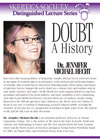 Doubt: A History (the lecture)
Doubt: A History (the lecture)
by Dr. Jennifer Michael Hecht
Announcing The Amaz!ng Meeting 2012
Southpoint Hotel & Casino, Las Vegas, NV
July 12–15, 2012
THE AMAZ!NG MEETING (TAM) is an annual celebration of science, skepticism and critical thinking. People from all over the world come to TAM each year to share learning, laughs and the skeptical perspective with their fellow skeptics and a host of distinguished guest speakers and panelists.
The James Randi Educational Foundation (JREF) has hosted its annual Amaz!ng Meeting since 2003 as a way to promote science, skepticism and critical thinking about paranormal and supernatural claims to the broader public. TAM has been held in Las Vegas, NV since 2004 and has become the world’s largest gathering of like-minded science-advocates and skeptics.
With yet another incredible lineup of speakers, hands-on workshops, and entertainment, this is sure to be an Amaz!ng Meeting you won’t want to miss! Check out the entire program, and follow @jref on Twitter for the latest #TAM2012 news and announcements.
Born Believers: The Science of Children’s
Religious Belief
Religious Belief
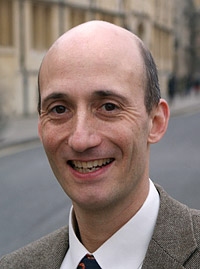
FROM A NOTED DEVELOPMENTAL PSYCHOLOGIST and anthropologist at Oxford University, this fascinating theory about the value of religious faith posits that we are all predisposed to believe in God from birth. We are all Born Believers, explains Professor Justin L. Barrett. It begins in the brain. Infants, under the sway of powerful internal and external forces, make sense of their environments by imagining a creative and intelligent agent, a grand controller who makes the sun shine and the night fall. In the chaos of childhood, where so much is out of the child’s control, this belief in a morally good creator can bring tremendous comfort and calm. A child’s world is then filled with beings who intentionally act upon the environment, maintaining order. Summarizing scientific experiments conducted with children across the globe, Professor Barrett illustrates the ways human beings have come to develop complex belief systems about God’s omniscience, the afterlife, and the immortality of deities. He shows how the science of childhood religiosity reveals, across humanity, a “Natural Religion.”
TAGS: belief in God, belief in God from birth, childhood religiosity, Justin Barrett12-04-11
In this week’s eSkeptic:
- Follow Michael Shermer: Are you an Atheist or Agnostic?
- Skepticality: Interview with Guy Harrison
- New Episode: Mr. Deity and The Therapist
- Feature Article: One Last Kick at the UFO Can
- Lecture at Caltech this Sunday: The Science of Children’s Religious Belief
- The Amaz!ng Meeting 2012: July 12–15 in Las Vegas

NEW ON SKEPTICBLOG.ORG
Are you an Atheist or Agnostic?
In this week’s Skepticblog, Michael Shermer distinguishes between agnosticism as an intellectual position and atheism as a behavioural position and reiterates what is his preferred “label.”

Interview with Guy Harrison
SKEPTICALITY EPISODE 180
This week on Skepticality, Derek interviews Guy Harrison about his latest book, 50 Popular Beliefs That People Think Are True, a guide to help steer people away from bogus pseudoscience by offering alternative explanations to commonly held unfounded beliefs. Derek also sits down with the founders of the website The Odds Must Be Crazy, a site which highlights extraordinary stories submitted by people who claim to have experienced the supernatural (yet these experiences have perfectly natural explanations).
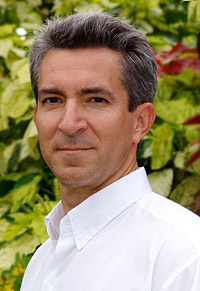
The Latest Episode of Mr. Deity: Mr. Deity and the Therapist
WATCH THIS EPISODE | DONATE | NEWSLETTER | FACEBOOK | MrDeity.com
About this week’s eSkeptic
In this week’s eSkeptic, George Michael and Robert Sheaffer have one last kick at the UFO can in this, the final segment of the dialogue that has happened over the past two weeks. Today, we present George Michael’s response to Robert Sheaffer’s rebuttal, followed by the last word from Robert Sheaffer.
For those of you who missed George Michael’s original review of UFOs: Generals, Pilots, and Government Officials Go on the Record you can read it in eSkeptic from March 28.
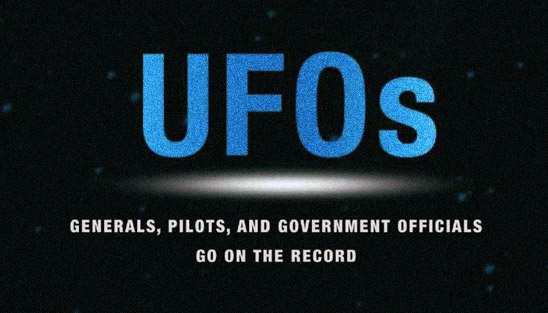
Reply to Robert Sheaffer
by George Michael
In last week’s eSkeptic, Robert Sheaffer lamented that I gave Leslie Kean’s book UFOs: Generals, Pilots, and Government Officials Go on the Record what he sees as an uncritical review. He seems to suggest that I am not qualified to review her book insofar as I am not adequately acquainted with so-called “debunker” literature that dismisses UFO claims.
His core criticism centers on my recounting of the alleged UFO sightings described in Kean’s book. Specifically, he cites the 1980 incidents at Rendlesham Forest in England during which several U.S. airmen were said to have reported seeing a triangular-shaped metallic craft moving near an airbase. For Kean’s book, two of the alleged witnesses, then Sergeant James Penniston and now retired Colonel Charles I. Hart, recount their experiences in detail in which they claim they saw an object that they suggest was extraterrestrial in origin. For his part, Sheaffer chides me for my lack of research into the matter, quoting a UFO skeptic, Ian Ridpath, who commented that if I had taken even a “glance at Wikipedia,” I would have found numerous explanations for the incidents, which in fact, I did. Some explanations attributed the sightings to a nearby lighthouse, while others attributed them to a meteor, and still another to a policeman who played a hoax on the credulous airmen. Case closed? Perhaps. But I’m in the unenviable position of figuring out which explanation is true. It seems that there is no consensus among those who seek to debunk this case.
But from my perspective, what truly happened during one particular incident, such as Rendlesham Forest, really misses the main point of Kean’s book. Contrary to what Sheaffer might believe, I am not entirely convinced of the authenticity of each and every UFO case detailed in her book, for example, the Hudson Valley wave of 1982. Sheaffer fails to address the distinguishing quality of Kean book. That is, she relies upon numerous seemingly credible people to make her case that there is something real behind UFO sightings rather than hoaxes and misidentifications that can be attributed to earthly sources. From what I can infer, her subjects did not provide her with off-the-cuff interviews that they might have later regretted. Rather, they provided lengthy, detailed, and seemingly considered accounts of their experiences and thoughts on UFOs. Her sources are not anonymous persons whom she refuses to identify or shadowy figures in the style of “Carlos Allende” who did much to create the legend of the Philadelphia Experiment. Rather, her subjects included retired high-ranking military officers, former prominent government officials, respected pilots, research scientists, and a former two-term Arizona governor. Now, some UFO claimants might find my preference for public figures as sources to be elitist; however, it’s far easier to ascertain their credibility and these are the people on whom Kean relies. Although Sheaffer disparages the “academic rigor” that I ascribe to Kean’s book, I stand by this characterization.
Despite the impressive case that Kean makes, I made it clear that the burden of proof is still on the UFO claimants insofar as smoking gun evidence has yet to be adduced. And as I explained near the end of the review, I find it well-nigh impossible that the U.S. government could maintain a conspiracy of silence if it indeed had solid information on the extraterrestrial origins of UFOs. Something of such earth-shaking significance would be hard to conceal or ignore for so long. Nevertheless, I think Kean has made a case for UFOs that merits more research into the matter.
Please keep in mind that skepticism cuts both ways. While it is important to question the veracity of UFO claims, the prospect of UFOs (of extraterrestrial origin) should not be categorically dismissed either. Are we to believe that Ms. Kean is so persuasive, that she was able to get all of her subjects to go on the record and publicly lie for her so she could publish a book? Or, were they hoping to launch their own careers on the UFO lecture circuit? Perhaps a few, but I doubt if that is what most of them had in mind. For those who question the reliability of Kean, they will have to impugn her subjects as well, who after all, wrote approximately half of her book.
Response to George Michael
by Robert Sheaffer
I find it very interesting, Mr. Michael, that you refer to the “so-called ‘debunker’ literature that dismisses UFO claims.” That is the kind of terminology we hear from hard-core UFO proponents like Stanton Friedman, but is rather surprising here. I would have called it “the skeptical literature, that critically examines UFO claims.” No, the problem is not your unfamiliarity with said literature. It is your failure to recognize that it even exists, or might have any valid inputs whatsoever. Most pro-UFOlogists do exactly that, saving themselves the trouble of having to read it. Some of the better pro-UFO writers, for example Kevin Randle, will deal with the skeptical literature in at least a perfunctory way. He will write something like “Klass says this is a hoax…”, and then go on to explain why he thinks Klass is wrong. And this is fine. But Leslie Kean does not do this. She cannot have all those “unexplained” cases unless she completely ignores the carefully-reasoned published explanations of those same cases by skeptics, whose writings have at least until now been pretty highly-regarded in skeptical publications.
Let me make it clear that I am by no means suggesting 100% acceptance of the explanations of UFO cases published by Philip J. Klass or anyone else. I do have some important differences with Klass’ explanations of a few major cases. Still, I would say that Klass’ explanations were at least 80% correct, and a great deal of investigation is underway today concerning any perceived loose ends.
I’m glad, Mr. Michael, that you’ve chosen Rendlesham to make your stand, because it is here we find one of the widest divergences between the Kean Version, and reality. You write, “then Sergeant James Penniston and now retired Colonel Charles I. Halt, recount their experiences in detail in which they claim they saw an object that they suggest was extraterrestrial in origin.” Mr. Michael, did you realize that James Penniston told Ancient Aliens on the History Channel of telepathically receiving a binary message from the craft (Google it!), whose occupants are, he says, “time travelers”? Do you accept this claim (a claim that wasn’t made until decades after the event)? As for Charles Halt, in 2010 he wrote an affidavit hugely contradicting his original memo of 1980. For example, he now says that the UFO flew directly over him, “stopped over head and sent down a small pencil like beam, sort of like a laser beam,” a detail completely lacking in his original memo and tape, which tells only of lights in the sky at a low ten-degree elevation. Do you still think we should accept Halt’s claim to have seen an extraterrestrial craft?
As for the Wikipedia entry on Rendlesham, you write “Some explanations attributed the sightings to a nearby lighthouse, while others attributed them to a meteor, and still another to a policeman who played a hoax on the credulous airmen… It seems that there is no consensus among those who seek to debunk this case.” You really need to read that more carefully. The event was due to misinterpretation of a series of nocturnal lights—a fireball, the Orford Ness lighthouse and bright stars—by different persons at different times. (The “policeman’s hoax” claim has been withdrawn.) When local UFO excitement gets strong enough, every light in the sky becomes an extraterrestrial craft. There is no controversy among skeptics as to who saw what, when, at Rendlesham.
“Are we to believe that Ms. Kean is so persuasive, that she was able to get all of her subjects to go on the record and publicly lie for her so she could publish a book?” Don’t be absurd, Mr. Michael! Very few of the cases in Kean’s book are new—most of them were first published decades ago. Her contribution was merely to dust them off, and get a new narrative from the person(s) involved. While some like Penniston and Halt are obviously UFO opportunists, the great majority of people reporting encounters with extraordinary flying objects are perfectly sincere. And high-status persons are not automatically better witnesses than ordinary ones, as Kean seems to think. In fact, Project Blue Book’s scientific UFO consultant, J. Allen Hynek, wrote, “Surprisingly, commercial and military pilots appear to make relatively poor witnesses”—a fact Kean conceals from her readers, while quoting other pages of that same book.
Finally, you suggest that “the prospect of UFOs (of extraterrestrial origin) should not be categorically dismissed either.” Unfortunately, that places us in the position of dismissing either these UFO sighting reports, or the laws of physics. “A spacecraft can generate thrust only by expelling mass…Reported UFOs cannot be under extraterrestrial control if the laws of physics are valid”—William Markowitz, “Physics and Metaphysics of Unidentified Flying Objects,” (Science, 157, 1274–79). The motto of the Royal Society of London, the world’s first scientific body (founded in 1660), is nullius in verba—“take nobody’s word for it.” Especially uncorroborated stories that contradict known laws of physics.
Order Skeptic back issues on the topic of UFOs ($6 each)
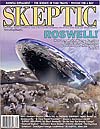
ROSWELL (10.1)
Buy it now
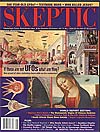
MEDIEVAL UFOs?
Buy it now
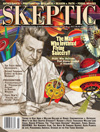
THE MAN WHO INVENTED FLYING SAUCERS
Buy it now
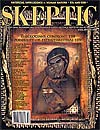
A.I. AND THEOLOGY
OF UFOs
Buy it now
Lecture at Caltech this Sunday
Born Believers: The Science of Children’s Religious Belief
with Dr. Justin Barrett
Sunday, April 15, 2012 at 2 pm
Baxter Lecture Hall
FROM A NOTED DEVELOPMENTAL PSYCHOLOGIST and anthropologist at Oxford University, this fascinating theory about the value of religious faith posits that we are all predisposed to believe in God from birth. We are all Born Believers, explains Professor Justin L. Barrett. It begins in the brain. Infants, under the sway of powerful internal and external forces, make sense of their environments by imagining a creative and intelligent agent, a grand controller who makes the sun shine and the night fall. In the chaos of childhood, where so much is out of the child’s control, this belief in a morally good creator can bring tremendous comfort and calm. A child’s world is then filled with beings who intentionally act upon the environment, maintaining order. Summarizing scientific experiments conducted with children across the globe, Professor Barrett illustrates the ways human beings have come to develop complex belief systems about God’s omniscience, the afterlife, and the immortality of deities. He shows how the science of childhood religiosity reveals, across humanity, a “Natural Religion.”
TICKETS are first come, first served at the door. Seating is limited. $8 for Skeptics Society members and the JPL/Caltech community, $10 for nonmembers. Your admission fee is a donation that pays for our lecture expenses.
Followed by…
Subliminal: How Your Unconscious Mind Rules Your Behavior
with Dr. Leonard Mlodinow
Sunday, April 29, 2012 at 2 pm
Announcing The Amaz!ng Meeting 2012
Southpoint Hotel & Casino, Las Vegas, NV
July 12–15, 2012
THE AMAZ!NG MEETING (TAM) is an annual celebration of science, skepticism and critical thinking. People from all over the world come to TAM each year to share learning, laughs and the skeptical perspective with their fellow skeptics and a host of distinguished guest speakers and panelists.
The James Randi Educational Foundation (JREF) has hosted its annual Amaz!ng Meeting since 2003 as a way to promote science, skepticism and critical thinking about paranormal and supernatural claims to the broader public. TAM has been held in Las Vegas, NV since 2004 and has become the world’s largest gathering of like-minded science-advocates and skeptics.
With yet another incredible lineup of speakers, hands-on workshops, and entertainment, this is sure to be an Amaz!ng Meeting you won’t want to miss! Check out the entire program, and follow @jref on Twitter for the latest #TAM2012 news and announcements.
12-04-04
In this week’s eSkeptic:
- Missed March 25th’s Caltech Events?: Watch them free on skeptic.com!
- Follow Michael Shermer: Climbing Mount Immortality
- MonsterTalk: ThylaCinema and Nocturnal Submissions
- Feature Article: The Day the Skeptics Society Wasn’t Skeptical
- Our Next Lecture at Caltech: The Science of Children’s Religious Belief
- The Amaz!ng Meeting 2012: July 12–15 in Las Vegas
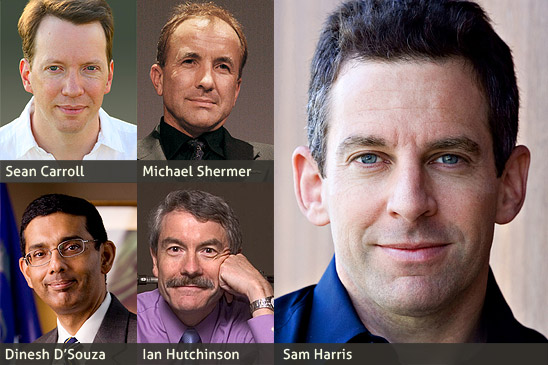
Missed March 25th’s Caltech Events?
Watch them for free on skeptic.com!
On March 25, the Skeptics Society hosted two sold out events, back to back: The Great Debate: “Has Science Refuted Religion?” in which Sean Carroll & Michael Shermer debated Dinesh D’Souza & Ian Hutchinson, followed by Sam Harris lecturing on “Free Will.” If you missed these events, you can now watch them for free right here!

NEW ON SKEPTICBLOG.ORG
Climbing Mount Immortality
In Michael Shermer’s April “Skeptic” column for Scientific American, he discusses what philosopher Stephen Cave calls the “Mortality Paradox” and “Terror Management Theory” and how awareness of our own mortality may be a major driver of civilization.

ThylaCinema and
Nocturnal Submissions
Join the hosts of MonsterTalk for an interview with Daniel Nettheim, director of a new film about a man hunting for thylacines. The Hunter stars Willem Dafoe as the eponymous character tasked with seeking out the last living thylacine in the wild. Also, Scott Sigler calls in to discuss his newest monster book, Nocturnal.
About this week’s eSkeptic
In this week’s eSkeptic, we present Robert Sheaffer’s rebuttal to George Michael’s review of UFOs: Generals, Pilots, and Government Officials Go on the Record that we published in last week’s eSkeptic. This rebuttal, republished here with permission, originally appeared on April 2, 2012 in Sheaffer’s blog Bad UFOs: Skepticism, UFOs, and The Universe.
Robert Sheaffer is a writer with a lifelong interest in astronomy and the question of life on other worlds. He is one of the leading skeptical investigators of UFOs, a founding member of the UFO Subcommittee of the well-known Committee for Skeptical Inquiry (CSI, formerly CSICOP). He is also a founding director and past Chairman of the Bay Area Skeptics, a local skeptics’ group in the San Francisco Bay area. Sheaffer is the author of UFO Sightings: The Evidence (Prometheus Books, 1998), and has appeared on many radio and TV programs. He is a regular columnist for The Skeptical Inquirer and his writing has appeared in OMNI, Scientific American, Spaceflight, Astronomy, The Humanist, Free Inquiry, and Reason.

The Day the Skeptics Society
Wasn’t Skeptical
by Robert Sheaffer
Normally the Skeptics Society is a pretty reliable source of information concerning paranormal and pseudo-scientific claims. So imagine my surprise (and dismay) to read in the weekly eSkeptic of March 28, 2012 a totally uncritical review of Leslie Kean’s book UFOs: Generals, Pilots, and Government Officials Go on the Record. Titled “Best Evidence for UFOs” by George Michael, it praises Kean’s “numerous credible eyewitnesses to UFO encounters and authoritative sources.” He thinks she makes an “ impressive case,” and praises her “academic rigor.” Plainly, either Michael did not read the same book I did, or he was entirely hornswoggled by the way that the crafty Kean disguises her hard-core UFO belief as respectable agnosticism.
Michael is totally uncritical of the claims and statements in Kean’s book. Given that the title of the magazine is “Skeptic,” why did it never occur to him to question any of the assertions made by Kean, instead of just accepting each and every one as Gospel truth? Did it not occur to him that, in a book written by a hard-core UFO believer (Kean’s mentor in UFOlogy was the late Budd Hopkins), one needs to verify the accuracy of the picture the author is trying to paint? Are all these UFO cases really unexplained? What have we skeptics been doing, sitting on our hands, or scratching our heads, during the decades since these Oldie-But-Moldy UFO claims were made?
The author is obviously totally clueless about the history of the UFO controversy. Otherwise, he would realize that many of Kean’s “unexplained” cases have been explained in detail by Philip J. Klass and others, years ago. Kean simply ignores all explanations and commentaries that she doesn’t like. To me that does not constitute “academic rigor,” as Mr. Michael seems to think. But he apparently has never read any of Klass’ UFO books, and I suspect doesn’t even know who Klass was (or else he would have asked himself, “What did Klass write about this case during the 70s or 80s?”). I have already written a review of Kean’s book, “‘Unexplained’ Cases—Only If You Ignore All Explanations,” that was published in the Skeptical Inquirer, March/April, 2011. I have now placed a copy of that review on my website, for those who would like to see what a critical analysis of Kean’s dubious pro-UFO claims might look like.
The British UFO skeptic Ian Ridpath wrote:
In his review of Leslie Kean’s book, George Michael too readily takes the author’s word for various UFO cases that have turned out, on investigation, not to be quite as the author describes them. A case in point is the Rendlesham Forest incident of 1980, which he calls “Perhaps the most notable reported military case involving a UFO”. A little research (even a glance at Wikipedia, for example) would have shown that explanations for all major aspects of that case have been in print for over 25 years. To address the points he raises: No unusual radiation was detected at the site, the supposed landing marks were made by forest animals, and the story of examining a landed craft for 45 minutes is something that was made up many years after the event by one of the witnesses, apparently bent on becoming a UFO celebrity. I would not expect to learn that from a book by an uncritical UFO proponent such as Leslie Kean, but I would have expected to hear it in a review on these pages… There are quite a few other cases he needs to learn about, too.
Peter Brookesmith, longtime paranormal researcher and regular contributor to Fortean Times, says
This review contains what must surely be the most distorted version of the Rendlesham Incident to see the light…where was the wary & informed editorial control? It’s not even as if this worthless tract has never been kicked in the fundament (and not only in hard-line skeptical journals) by other reviewers: it’s been out & about for a while. So the real question is, how come the review was published by eSkeptic at all?
As far back as August, 2010 skeptic James Oberg wrote for MSNBC that Kean’s book was based on a “questionable foundation.” He quickly glanced at a list of supposed “unexplained” cases given by Kean, and immediately pulled out ten that he knew to be caused by Russian space launches.
eSkeptic is probably unaware that Kean’s book was also made into an equally bad one-sided pro-UFO documentary on the History Channel. I have also written a critique of the misrepresentations made on this show.
Apparently Mr. Michael is also unaware that the big controversy underway in UFOlogy at the moment involves Kean promoting a video of a fly buzzing around as being possibly “the case UFO skeptics have been dreading.” Even many of the UFO proponents are choking on that one, as her position is so obviously illogical. Had Michael known that Kean was vigorously defending such an obvious absurdity, I cannot imagine how he possibly could have written such a fawning review.
Unfortunately, now Leslie Kean will be able to boast to reporters that her book has been given the ‘seal of approval’ of Skeptic magazine for its “academic rigor.” As Ian Ridpath noted, if Michael had even bothered to check Wikipedia, he would have seen the problems in Kean’s version of the Rendlesham case. Let us hope that in future articles concerning UFOs, the Skeptics Society will utilize the services of authors and reviewers whose understanding of the UFO controversy is better than paper-thin, and who will check out the validity of pro-UFO claims before credulously swallowing them.
Order Skeptic back issues on the topic of UFOs ($6 each)

ROSWELL (10.1)
Buy it now

MEDIEVAL UFOs?
Buy it now

THE MAN WHO INVENTED FLYING SAUCERS
Buy it now

A.I. AND THEOLOGY
OF UFOs
Buy it now
Our Next Lecture at Caltech
Born Believers: The Science of Children’s Religious Belief
with Dr. Justin Barrett
Sunday, April 15, 2012 at 2 pm
Baxter Lecture Hall
FROM A NOTED DEVELOPMENTAL PSYCHOLOGIST and anthropologist at Oxford University, this fascinating theory about the value of religious faith posits that we are all predisposed to believe in God from birth. We are all Born Believers, explains Professor Justin L. Barrett. It begins in the brain. Infants, under the sway of powerful internal and external forces, make sense of their environments by imagining a creative and intelligent agent, a grand controller who makes the sun shine and the night fall. In the chaos of childhood, where so much is out of the child’s control, this belief in a morally good creator can bring tremendous comfort and calm. A child’s world is then filled with beings who intentionally act upon the environment, maintaining order. Summarizing scientific experiments conducted with children across the globe, Professor Barrett illustrates the ways human beings have come to develop complex belief systems about God’s omniscience, the afterlife, and the immortality of deities. He shows how the science of childhood religiosity reveals, across humanity, a “Natural Religion.”
TICKETS are first come, first served at the door. Seating is limited. $8 for Skeptics Society members and the JPL/Caltech community, $10 for nonmembers. Your admission fee is a donation that pays for our lecture expenses.
Followed by…
Subliminal: How Your Unconscious Mind Rules Your Behavior
with Dr. Leonard Mlodinow
Sunday, April 29, 2012 at 2 pm
Announcing The Amaz!ng Meeting 2012
Southpoint Hotel & Casino, Las Vegas, NV
July 12–15, 2012
THE AMAZ!NG MEETING (TAM) is an annual celebration of science, skepticism and critical thinking. People from all over the world come to TAM each year to share learning, laughs and the skeptical perspective with their fellow skeptics and a host of distinguished guest speakers and panelists.
The James Randi Educational Foundation (JREF) has hosted its annual Amaz!ng Meeting since 2003 as a way to promote science, skepticism and critical thinking about paranormal and supernatural claims to the broader public. TAM has been held in Las Vegas, NV since 2004 and has become the world’s largest gathering of like-minded science-advocates and skeptics.
With yet another incredible lineup of speakers, hands-on workshops, and entertainment, this is sure to be an Amaz!ng Meeting you won’t want to miss! Check out the entire program, and follow @jref on Twitter for the latest #TAM2012 news and announcements.
12-03-28
In this week’s eSkeptic:
- Announcing The Amaz!ng Meeting 2012: July 12–15 in Las Vegas
- Follow Michael Shermer: A Report from the Reason Rally
- MonsterTalk: What the Bigfoot market will bear
- Skepticality: Interview with Neil DeGrasse Tyson
- Feature Article: Best Evidence for UFOs (a book review)
- Our Next Lecture at Caltech: The Science of Children’s Religious Belief
Announcing The Amaz!ng Meeting 2012
Southpoint Hotel & Casino, Las Vegas, NV
July 12–15, 2012
THE AMAZ!NG MEETING (TAM) is an annual celebration of science, skepticism and critical thinking. People from all over the world come to TAM each year to share learning, laughs and the skeptical perspective with their fellow skeptics and a host of distinguished guest speakers and panelists.
The James Randi Educational Foundation (JREF) has hosted its annual Amaz!ng Meeting since 2003 as a way to promote science, skepticism and critical thinking about paranormal and supernatural claims to the broader public. TAM has been held in Las Vegas, NV since 2004 and has become the world’s largest gathering of like-minded science-advocates and skeptics.
With yet another incredible lineup of speakers, hands-on workshops, and entertainment, this is sure to be an Amaz!ng Meeting you won’t want to miss! Check out the entire program, and follow @jref on Twitter for the latest #TAM2012 news and announcements.

NEW ON SKEPTICBLOG.ORG
Reason Rally Rocks
In this week’s Skepticblog, Michael Shermer reports on his experience at the March 24, 2012 Reason Rally in Washington, DC: the largest gathering of skeptics, atheists, humanists, nonbelievers, and “nones” (those who tick the “no religion” box on surveys) in the world.
NEW IN THE READING ROOM
The Moral Arc of Reason
Read Michael Shermer’s speech given at the Reason Rally in Washington, D.C.
on March 24, 2012.

What the Bigfoot market
will bear
In the forests of Pennsylvania, on a dark September night, a trail-cam took a series of controversial pictures. The Bigfoot Field Researchers Organization (BFRO) still claims they show a juvenile Bigfoot. Skeptics claim the photos show a bear. Join the hosts of MonsterTalk as they discuss Bigfoot photos, fair-use and the economics of unusual photos.
About this week’s eSkeptic
In this week’s eSkeptic, George Michael reviews Leslie Kean’s book UFOs: Generals, Pilots, and Government Officials Go on the Record (Crown, 2010, ISBN13: 978-0307716842).
George Michael received his Ph.D. from George Mason University’s School of Public Policy. Currently, he is an associate professor of nuclear counterproliferation and deterrence theory at the Air War College in Montgomery, Alabama. Previously, he was an associate professor at the University of Virginia’s College at Wise. He is the author of five books, including Willis Carto and the American Far Right, Theology of Hate: A History of the World Church of the Creator, and Lone Wolf Terror and the Rise of Leaderless Resistance. In addition, his articles have been published in numerous journals.

Best Evidence for UFOs
by George Michael
The study of UFOs has long been consigned on the fringes of the research community. Although the SETI (Search for Extraterrestrial Intelligence) project is regarded as a serious scientific effort, Ufology suffers from a sizable credibility gap despite the fact that nearly 80 percent of those Americans surveyed—according to a CNN poll conducted in 1997—believed that the government was hiding knowledge of the existence of alien life forms.1 The failure of Unidentified Flying Objects (UFOs) to be taken seriously in academia can be ascribed in large part to a dearth of physical evidence and the questionable reliability of UFO claimants. In UFOs: Generals, Pilots, and Government Officials Go on the Record, Leslie Kean, an investigative journalist, attempts to break with this pattern by relying on accounts from numerous credible eyewitnesses to UFO encounters and authoritative sources.
As Kean recounts, the contemporary UFO era commenced in the late 1940s after a sudden influx of sightings were observed in the United States and around the world. Concomitant with the start of the cold war, military officials began investigating UFOs, as they suspected that they might be Soviet in origin. In 1947, Lieutenant General Nathan Twining, commander of the Air Force Material Command, sent a secret memo concerning “Flying Discs” to the Pentagon and recommended that a detailed study into the topic was warranted. The next year, the “Sign” project was established within the Air Material Command with operations located at Wright Field (now Wright-Patterson Air Force Base). Sign was later renamed “Grudge” and in 1951 “Project Bluebook” became a repository for UFO cases and a place for people to call and file reports of sightings.
Other agencies took an interest in UFOs as well. In 1953, the Central Intelligence Agency (CIA) convened a scientific advisory panel chaired by H.P. Robertson, a physicist and weapon systems specialist from the California Institute of Technology. The panel proposed the creation of a broad educational program that would integrate the efforts of all concerned agencies. The CIA encouraged all agencies within the intelligence community to work with the media and infiltrate civilian research groups for the purpose of debunking UFOs. By doing so, public interest in the topic would diminish.
Some researchers, however, took issue with the government’s agenda to discredit UFO claims. For example, J. Allen Hynek, an astronomer who worked for a number of years as a consultant to Project Blue Book, released a book in 1972 titled The UFO Experience: A Scientific Inquiry, in which he acknowledged that the Air Force followed the CIA’s lead in debunking UFO claims. But UFO sightings continued, and in 1966 the University of Colorado agreed to host a government-funded study of UFOs led by Edward U. Condon, a prominent physicist and head of the National Bureau of Standards. The Condon Report concluded that “Nothing has come from the study of UFOs in the past twenty years that has added to scientific knowledge.” Project Bluebook was officially terminated in early 1970, thus ending all official government investigations into the topic of UFOs. Thereafter the UFO question shifted to the margins.
Although Project Bluebook was officially terminated, Kean believes that the U.S. military continues to investigate UFOs. She claims to have acquired a British government document from a Freedom of Information Act (FOIA) request that comes close to verifying the existence of a secret group in the U.S. intelligence community that still investigates UFOs. Despite the U.S. government’s dismissal of the validity of UFO sightings, according to Kean, documents released under FOIA show that officials in multiple branches of government asserted that the UFOs might be extraterrestrial in origin.
Compellingly, a significant proportion of UFO sightings have been reported by military pilots and their crews. Kean cites the notable example of Parviz Jafari, a major in the Iranian Air Force, who in 1976 approached a luminous UFO that was observed over Tehran. Jafari claimed that he attempted to fire a Sidewinder missile at the UFO, but his equipment shut down and returned to normal only after his jet moved away from the object. Apparently, the U.S. government took an interest in the case, as a once-classified memo from the Defense Intelligence Agency on the incident was sent to the National Security Agency (NSA), the White House, and the CIA. Another purported military encounter with a UFO occurred on April 11, 1980, when Lieutenant Oscar Santa Maria Huertas of the Peruvian Air Force was ordered to intercept what was initially believed to be an aerial spying balloon. He fired a 64-round burst of 30 mm shells that would normally obliterate a target, but the barrage had no effect. The bullets seemed to be absorbed by the object, which ascended very rapidly away from the air base. When Huertas got close to his target, he realized that it was not a balloon after all, but appeared to be an object with a shiny dome on top. As he explained, the object lacked the typical features of an aircraft, as it had no wings, propulsion jets, exhausts, or windows.
Perhaps the most notable reported military case involving a UFO occurred on December 26, 1980, at the Rendlesham Forest, near Ipswich in England. A three-man patrol from the U.S. Air Force’s 81st Security Police Squadron reported seeing a triangular-shaped metallic craft moving through the trees, which eventually landed in a small clearing. According to his account of the incident, upon approaching the craft, Sergeant James Penniston observed strange markings that he likened to Egyptian hieroglyphs. He even touched the craft and took photographs of it. After about 45 minutes he said the craft lifted off and maneuvered through the trees at a remarkable speed. Alas, the Air Force later told Penniston that his photos were overexposed and did not come out. However, depression marks where the object had landed were observed and a Geiger counter indicated significantly high radiation readings. Two nights later, the deputy base commander Lieutenant Colonel Charles I. Halt observed the craft as well and became one of the highest-ranking military officers ever to go on the record about a UFO sighting.
After many years of study, the U.S. military concluded that UFOs posed no threat to national security. Only a small fraction of UFOs have demonstrated even a remote semblance of hostility. And those rare occasions occurred only after severe provocation, such as an attack by military aircraft. According to several accounts, UFOs were able to evade attacks at the very last moment just when pilots locked onto their targets. Inasmuch as these last-minute evasions were so perfectly-timed, the pilots concluded that they could not be coincidental.
Numerous civilian accounts of UFO sightings that have surfaced are documented by Kean as well. For instance, the Hudson Valley wave, which began in upstate New York and parts of Connecticut in 1982, involved repeated sightings of large silent objects hovering at low altitudes with extremely bright spotlights. Even more significant was the case of the “Phoenix Lights,” which included a number of spectacular sightings that were reported in Arizona on March 13, 1997. Scores of witnesses claimed to have seen a massive aircraft measuring the size of “multiple football fields.” As is often the case, the government did not appear interested in the episode and no official investigation was launched despite the public outcry from the scores of eyewitnesses. A few months after the sightings, Governor Fife Symington announced at a press conference that he would reveal the source of the Phoenix Lights, whereupon his chief of staff, Jay Helier, was escorted to the podium in handcuffs and wearing an alien mask over his head. In a remarkable essay provided to Kean, Symington revealed that he too had seen the UFO, but explained that his levity at the press conference was as an effort to allay the consternation of his constituents.
Kean characterizes the U.S. government as a “pariah” on the international scene concerning official UFO investigations for its lack of transparency. In contrast, several European and South American governments have taken the issue seriously and established agencies to investigate to study of UFOs. In particular, Kean commends the French government for its open-mindedness on UFOs as evidenced by its creation of GEIPAN, a unit in the French space agency (CNES) that investigates unidentified aerial phenomena (UAP). In 1999, a private French group—COMETA (the committee for In-Depth Studies)—released a 90-page document that concluded that the best explanation for the small number of seemingly inexplicable UFO cases was the extraterrestrial hypothesis. Inasmuch as the report was undertaken by numerous retired generals, scientists, and space experts who spent three years analyzing military and pilot encounters with UFOs, it had considerable credibility. One of the report’s authors, Jean-Jacques Velasco, who from 1983 to 2004 led GEIPAN, concluded that the existence of UFOs was without question.
After a wave of UFO sightings were recording in Belgium in 1989-1990, the Belgian government took an interest in the topic as well. Approximately, 2,000 cases were reported of which 650 were investigated and 500 remain unexplained. Some observers described the aircraft as triangular, while other described them as massive inverted aircraft carriers. Several witnesses observed the craft making tilting maneuvers, which revealed a dome at the top. Belgian Major General Wilfried De Brouwer maintained that the maneuvers of the UFOs were beyond the capacity of even experimental aircraft and no “black program” could have been responsible for the sightings. Moreover, American authorities assured the Belgian Air Force that there were no U.S. aerial test flights that could have occasioned the sightings.
Despite numerous recorded incidents, Kean points out that many people dismiss the subject of UFO as something that is unserious and not worthy of study. Ostensibly, the U.S. government appears to be aloof on UFOs despite the documentary evidence. Still, some officials have taken the topic seriously. For example, shortly after assuming office, President Jimmy Carter (who had his own UFO sighting in 1969), instructed his science advisor, Frank Press, to write a memo to the National Aeronautics and Space Administration (NASA), recommending that the agency set up a panel of inquiry on UFOs. However, after a number of letters, memos, and inquiries made their way through the various levels of the hierarchy of the NASA bureaucracy, the agency turned down the president’s request in December 1977. For his part, Senator Barry Goldwater (Rep-AZ), a former pilot and retired major general in the Air Force Reserve, was convinced that a secret UFO program did exist. He once called the commander of the Strategic Air Command, Curtis LeMay, and asked permission to access the room at Wright-Patterson where information on UFOs resided, at which point LeMay alleged got angry and cussed him out, exclaiming “Don’t ever ask me that question again.” More recently, John Podesta, who served as President Bill Clinton’s White House chief of staff, wrote a foreword to Kean’s book and supported her efforts to bring more information on the topic of UFOs.
Why, Kean asks, is there such a strong taboo against taking the UFO subject seriously when there is so much evidence for it? Rather than an intentional conspiracy, Kean speculates that the U.S. government might be as baffled as everyone else on the UFO question. In an interesting essay included in the book titled “Militant Agnosticism and the UFO Taboo,” two political scientists, Alexander Wendt and Raymond Duvall, advance a theory as to why the U.S. government has supposedly been less than forthcoming on the UFO question. As they point out, skeptics cite a number of seemingly intractable obstacles to interstellar travel to argue against the extraterrestrial hypothesis. Nevertheless, Wendt and Duvall argue that the origins of the UFO taboo are political, not scientific. As they see it, the prospect of UFOs presents three major challenges to the sovereignty and credibility of the state. First, if UFOs are accepted as truly unidentified, then that proposition would acknowledge a potential threat, which could undercut the legitimacy of the state insofar as protection against potential threats is the most elemental function of the government. Second, a confirmation of the presence of UFOs would create tremendous pressure for a world government that today’s territorial states would be reluctant to form. Third, and most important, the extraterrestrial possibility would call into question the anthropocentric model of modern sovereignty, which as they explain, forms the basis of the authority of states to command the loyalty of their subjects. The arrival of extraterrestrial aliens, they assert, would be something analogous to the Christian “Second Coming.” In such a scenario they ask, to whom would people give their loyalty? Could states survive if such a question became salient?
In sum, Wendt and Duvall argue that the presence of UFOs creates a deep, unconscious insecurity in which certain possibilities are unthinkable because of their political implications. As a consequence, the taboo emerges not so much from a vast conscious conspiracy seeking to suppress “the truth” about UFOs. Rather countless undirected practices that help us “know” that UFOs are not extraterrestrial in origin and can therefore be disregarded are carried out by the government, but not in the style of a covert conspiracy.
The consensus among the researchers cited in the book is that 95 percent of UFO sighting can be explained by earthly sources. However, the other 5 percent cannot be attributed to secret military exercises or natural phenomena. The witnesses maintain that the UFOs appear to make exceptional performance maneuvers that are beyond the capabilities of know aircrafts. Moreover, they insist that they are guided by some intelligence.
Kean endorses Wendt’s and Duvall’s call for a “militant agnosticism” in pursuit of UFO investigations. By agnostic, they mean not rushing to ascribe UFOs to extraterrestrial sources. If, however, the eyewitness accounts presented in Kean’s book are to be believed, then one would be hard pressed to conclude otherwise. Other explanations proffered in the past would be at least, or even more mind-boggling, such as time travelers, Nazi flying saucers from underground bases in Antarctica, or visitors from other dimensions. What is most compelling about Kean’s study is the number of seemingly credible and authoritative first person sources who go on the record for her with their positions on UFOs. None of them claimed to have experienced any repercussions from the government or men-in-black visitations.
Alas, despite the impressive case she makes, smoking gun evidence remains elusive. Moreover, there appears to be little to no corroborative evidence outside of UFO studies that would support the extraterrestrial hypothesis. As Kean concedes, there have been no deathbed confessions or willed documents from any government scientists or officials that have revealed the truth about special access programs on UFOs. Moreover, she points out that we have not seen any fantastic reverse-engineered military technology that might have been retrieved from captured UFOs, despite rumors to the contrary. Numerous memoirs of past presidents and other prominent leaders often reveal embarrassing details of their lives, but so far, none have provided any insight about their secret relationships with extraterrestrial representatives.
Furthermore, although Wendt and Duvall dismiss the notion of a “vast conscious conspiracy” on the part of the U.S. government that prevents information on UFOs from reaching the public, it is hard to see how otherwise an issue of such earth-shaking significance could be withheld. Instead, the world’s leaders seem to go about their day-to-day business and decision-making without considering the influence of extraterrestrial visitors, who if they were so magnanimous, might at least give us some advice on how to find alternatives to fossil fuels, considering their ability to master interstellar travel. As others have noted, contact with extraterrestrials would be a transformative event, yet if it has already occurred, the world’s leaders seem startling aloof and amazingly tight-lipped—a remarkable adherence to security protocol in an age of exposé journalism. At least from surface appearances, public officials do not seem to take into account the presence of aliens, with few exceptions. For instance, far from shunning the prospect of extraterrestrial life, in August 1996, President Bill Clinton enthusiastically announced that NASA scientists had found evidence for life on Mars in the form of microscopic features inside a meteorite recovered from Antarctica in 1984, though subsequent analysis chipped away at that conclusion.2
As well, even the detailed accounts provided by reliable sources lack credibility. In his April, 2011 column in Scientific American, for example, Michael Shermer deconstructs the above-mentioned UFO wave over Belgium in 1989–1990. Here is Belgian Major General Wilfried De Brouwer’s recounting of the first night of sightings: “Hundreds of people saw a majestic triangular craft with a span of approximately a hundred and twenty feet and powerful beaming spotlights, moving very slowly without making any significant noise but, in several cases, accelerating to very high speeds.” As Shermer notes: “But even seemingly unexplainable sightings such as De Brouwer’s can have simple explanations. It could simply have been an early experimental model of a stealth bomber (U.S., Soviet, or otherwise) that secret-keeping military agencies were understandably loath to reveal.” Shermer then compares De Brouwer’s narrative to Kean’s summary of the same incident: “Common sense tells us that if a government had developed huge craft that can hover motionless only a few hundred feet up, and then speed off in the blink of an eye—all without making a sound—such technology would have revolutionized both air travel and modern warfare, and probably physics as well.” Shermer notes how a “120-foot craft” becomes “huge,” how “moving very slowly” changes to “can hover motionless,” how “without making any significant noise” shifts to “without making a sound,” and how “accelerating to very high speeds” transforms into “speed off in the blink of an eye.” He notes that “This language transmutation—probably unintentional—is common in UFO narratives, making it harder for scientists to provide natural explanations.” Despite this significant shortcomings, Kean’s book is a welcome addition to the topic of UFOs, which heretofore, suffered from a lack of reliability and academic rigor. Kean advises that UFO cases should be investigated utilizing scientific techniques that evaluate physical evidence rather than relying exclusively on subjective eyewitness accounts. To that end, she calls for the creation of a small agency within the U.S. government to handle appropriate UFO investigations and coordinate with other countries and the scientific community. With the ubiquity of digital cameras and cell phones, there are now more opportunities for witnesses to capture UFOs in pictures which could be exciting, for as it still stands, the burden of proof is still on the UFO claimants.
References
- “Poll U.S. hiding knowledge of aliens,” CNN, June 15, 1997, http://articles.cnn.com/1997-06-15/us/9706_15_ufo.poll_1_ufo-aliens-crash-site?_s=PM:US.
- Paul Davies, The Eerie Silence: Renewing Our Search for Alien Intelligence. (Boston and New York: Houghton Mifflin Harcourt, 2010), pp. 61–62.
Order Skeptic back issues on the topic of UFOs ($6 each)

ROSWELL (10.1)
Buy it now

MEDIEVAL UFOs?
Buy it now

THE MAN WHO INVENTED FLYING SAUCERS
Buy it now

A.I. AND THEOLOGY
OF UFOs
Buy it now
Our Next Lecture at Caltech
Born Believers: The Science of Children’s Religious Belief
with Dr. Justin Barrett
Sunday, April 15, 2012 at 2 pm
Baxter Lecture Hall
FROM A NOTED DEVELOPMENTAL PSYCHOLOGIST and anthropologist at Oxford University, this fascinating theory about the value of religious faith posits that we are all predisposed to believe in God from birth. We are all Born Believers, explains Professor Justin L. Barrett. It begins in the brain. Infants, under the sway of powerful internal and external forces, make sense of their environments by imagining a creative and intelligent agent, a grand controller who makes the sun shine and the night fall. In the chaos of childhood, where so much is out of the child’s control, this belief in a morally good creator can bring tremendous comfort and calm. A child’s world is then filled with beings who intentionally act upon the environment, maintaining order. Summarizing scientific experiments conducted with children across the globe, Professor Barrett illustrates the ways human beings have come to develop complex belief systems about God’s omniscience, the afterlife, and the immortality of deities. He shows how the science of childhood religiosity reveals, across humanity, a “Natural Religion.”
TICKETS are first come, first served at the door. Seating is limited. $8 for Skeptics Society members and the JPL/Caltech community, $10 for nonmembers. Your admission fee is a donation that pays for our lecture expenses.
Followed by…
Subliminal: How Your Unconscious Mind Rules Your Behavior
with Dr. Leonard Mlodinow
Sunday, April 29, 2012 at 2 pm

